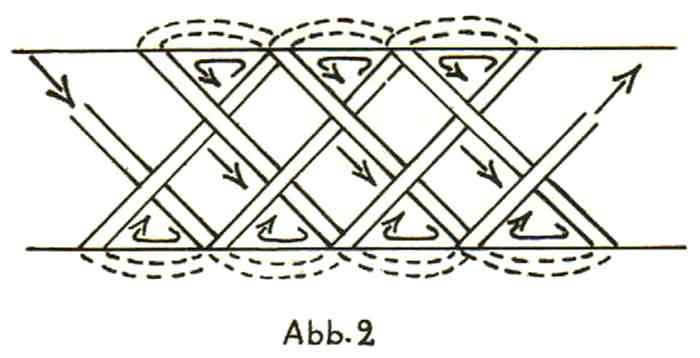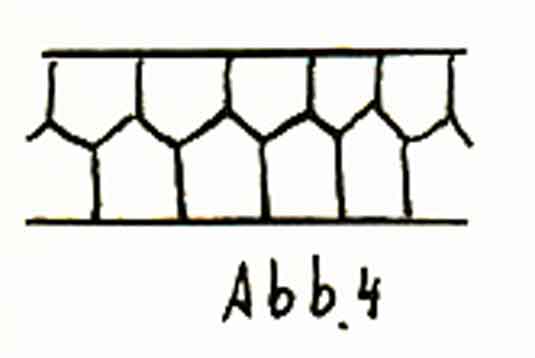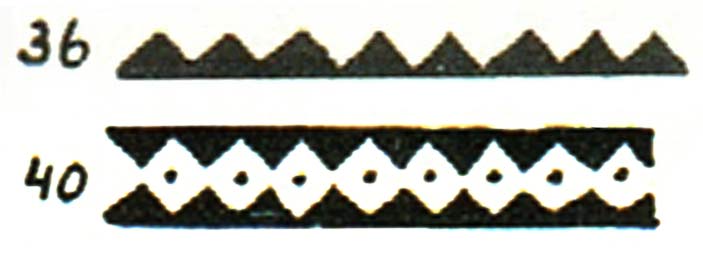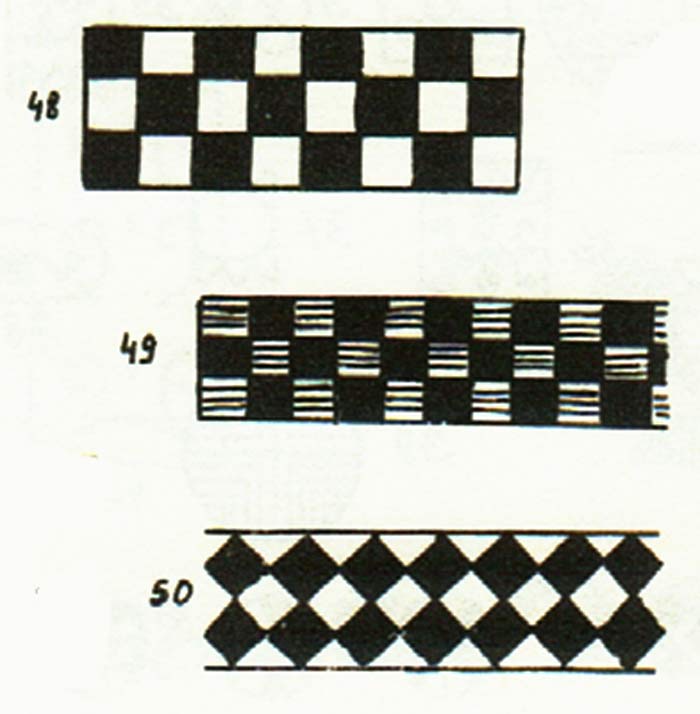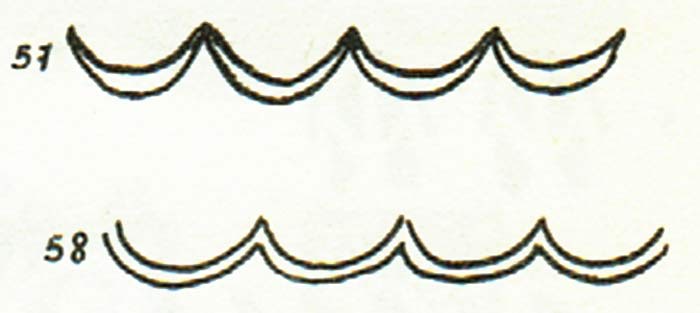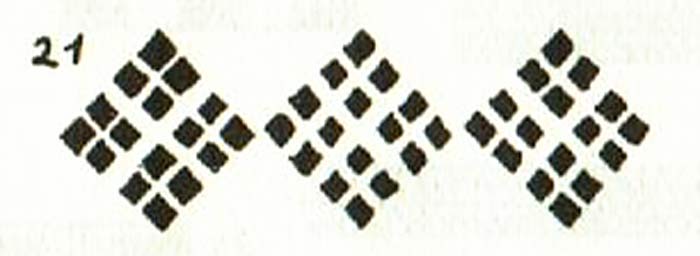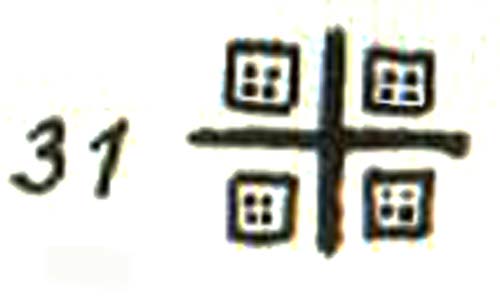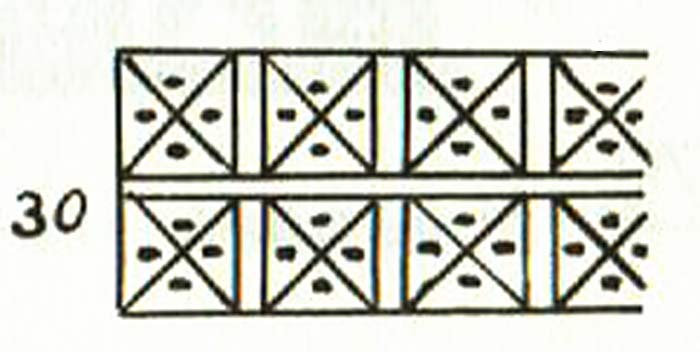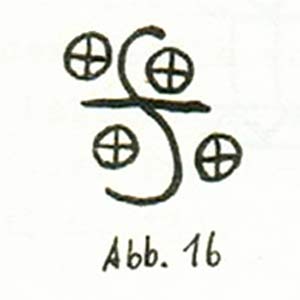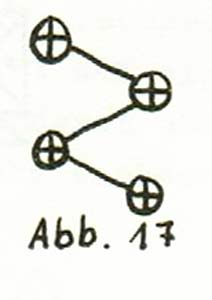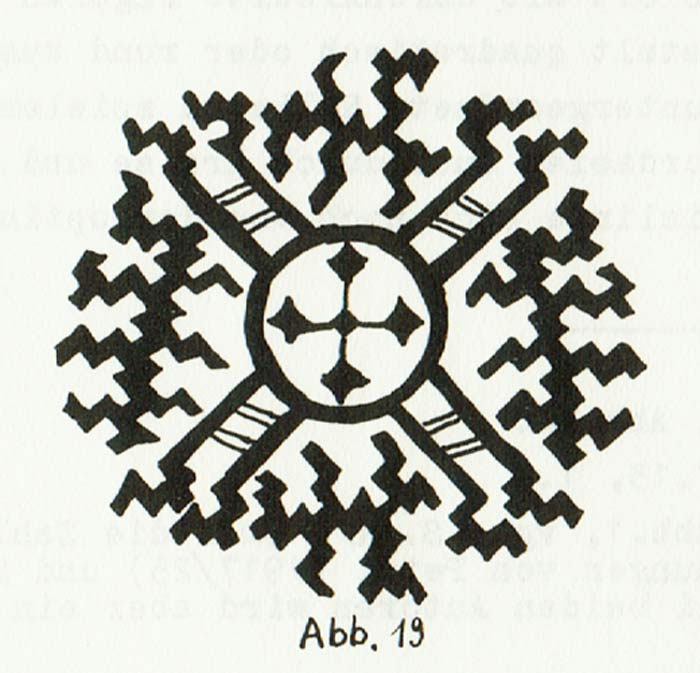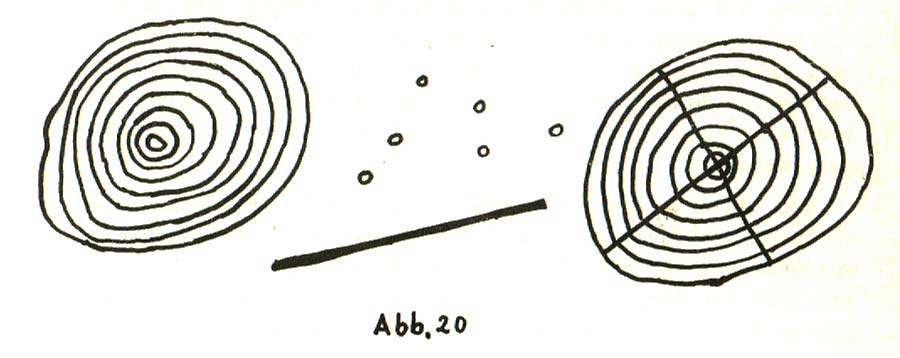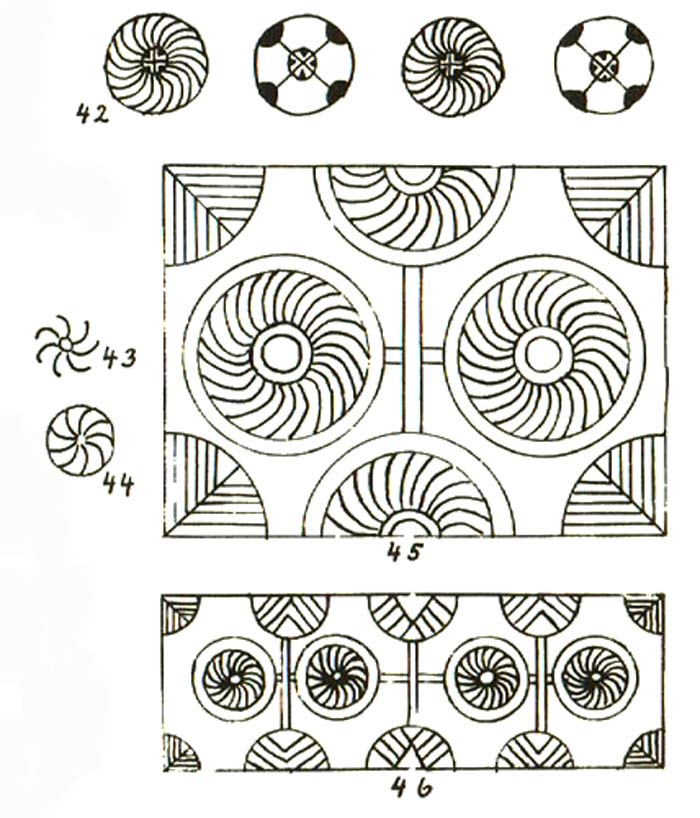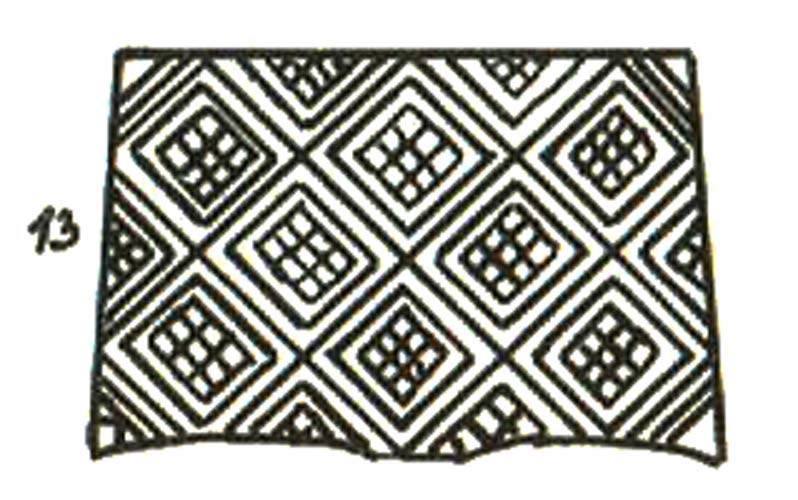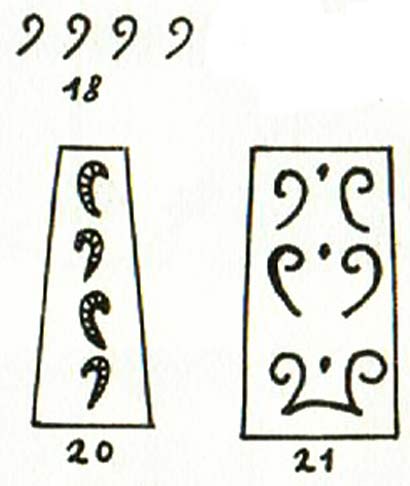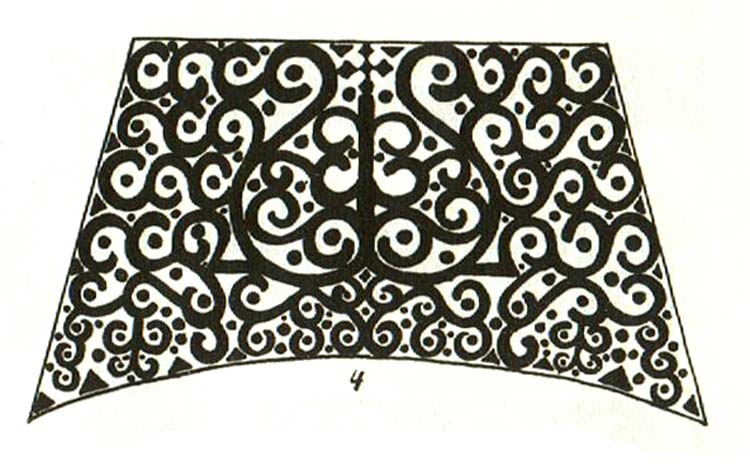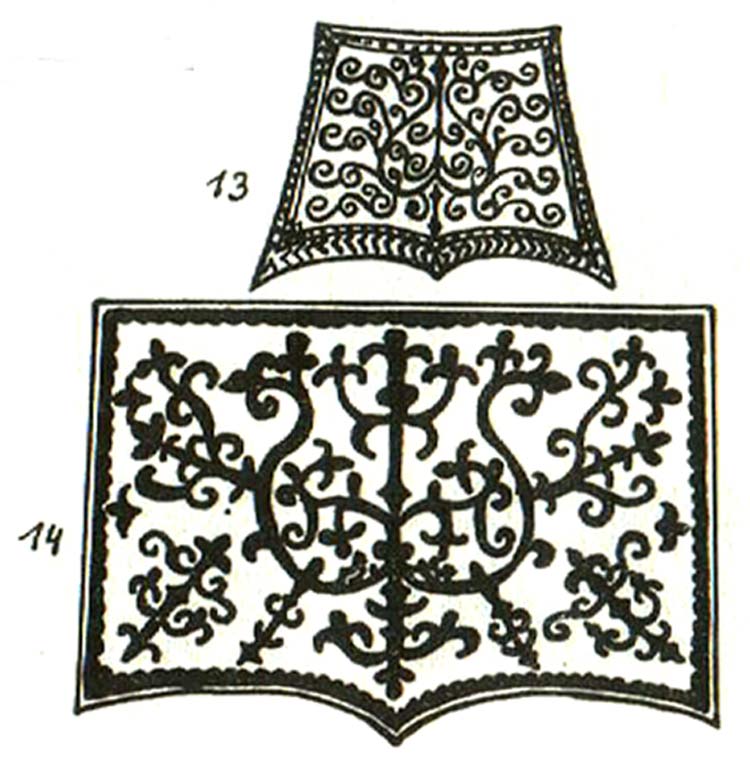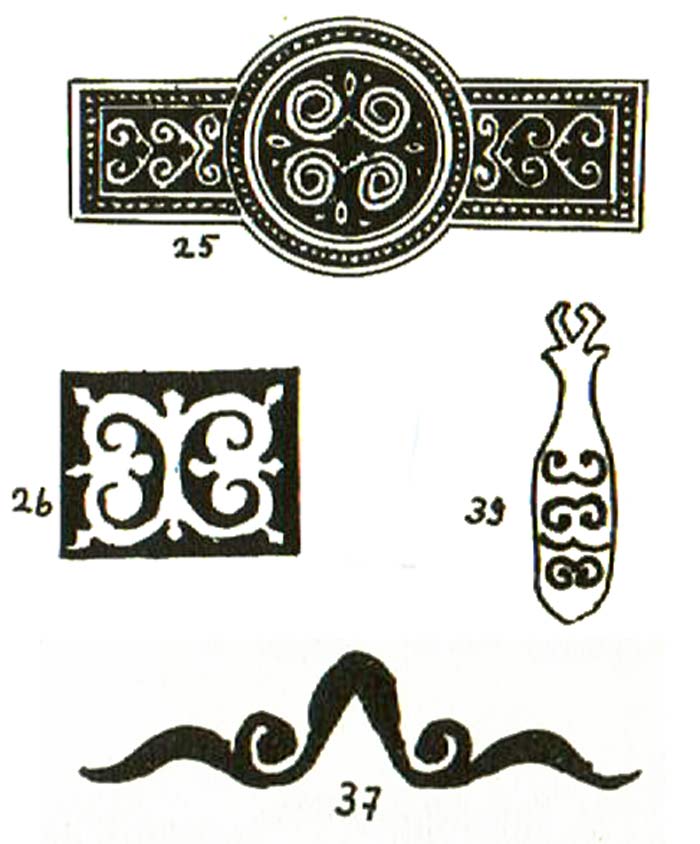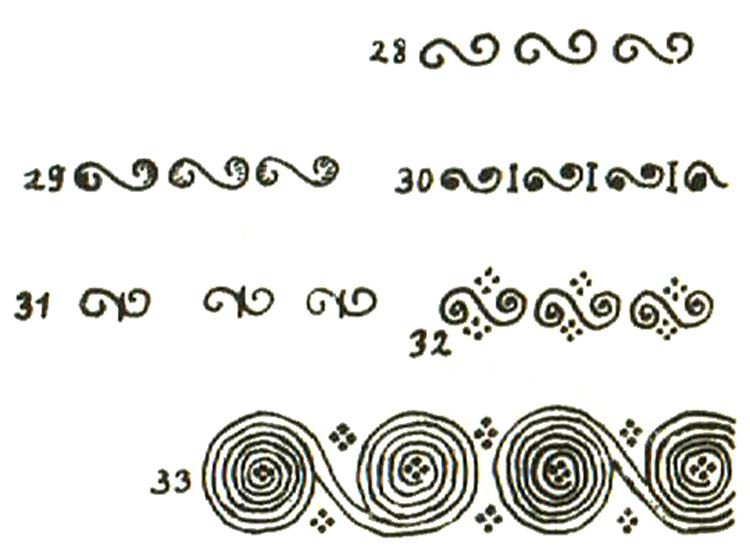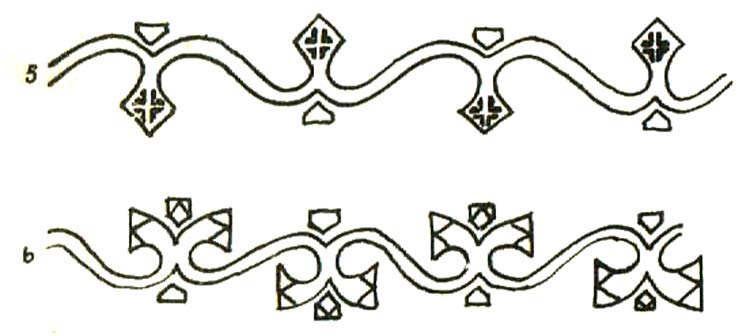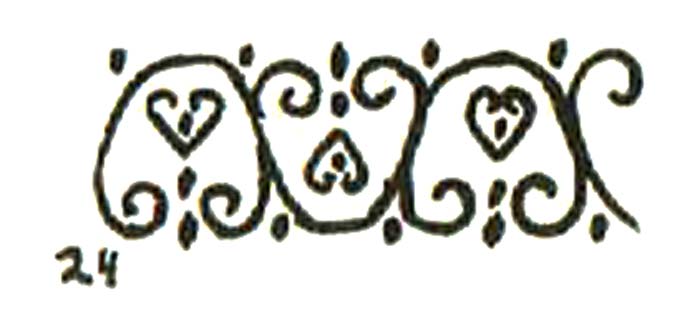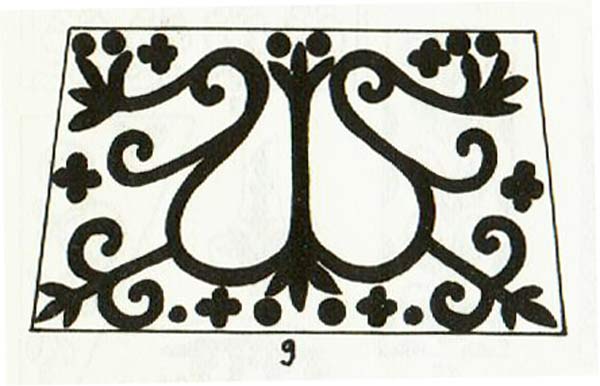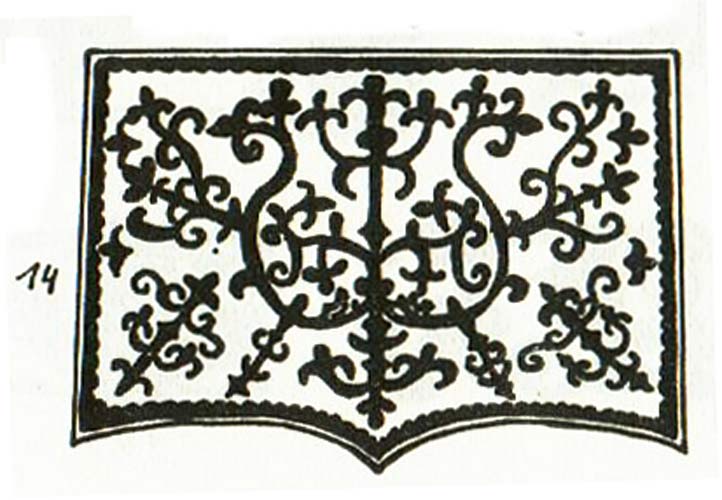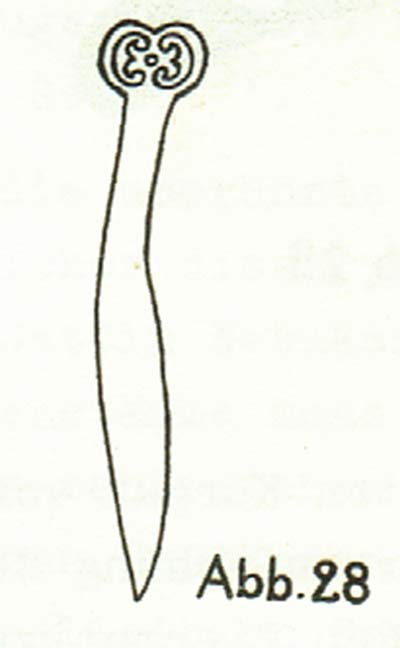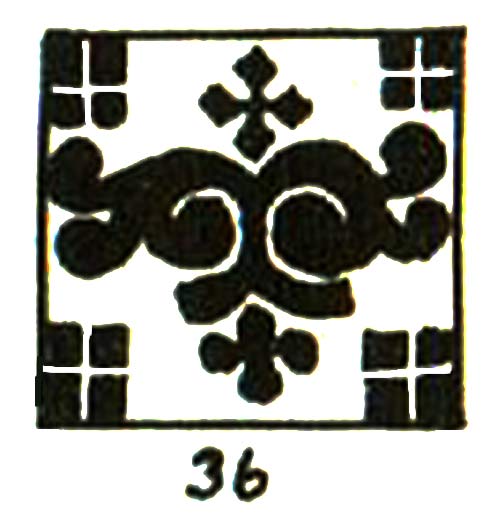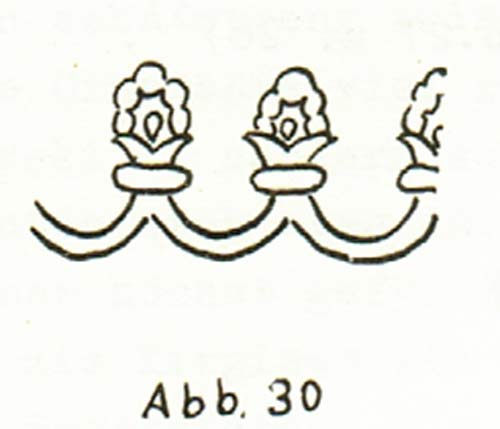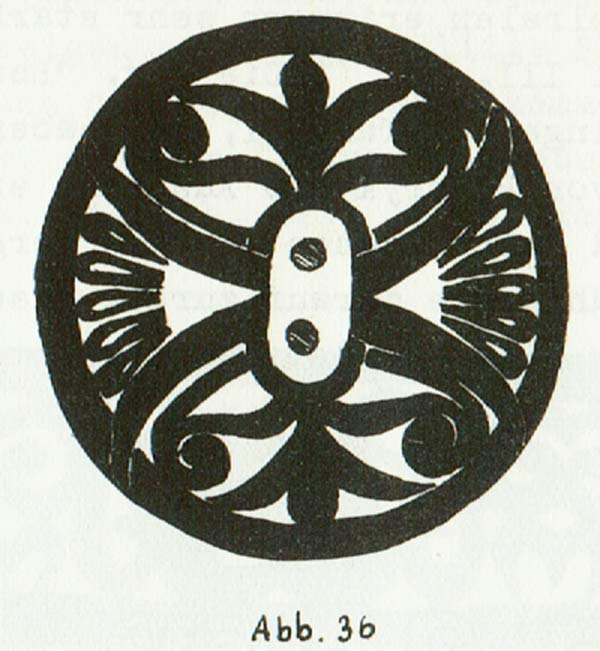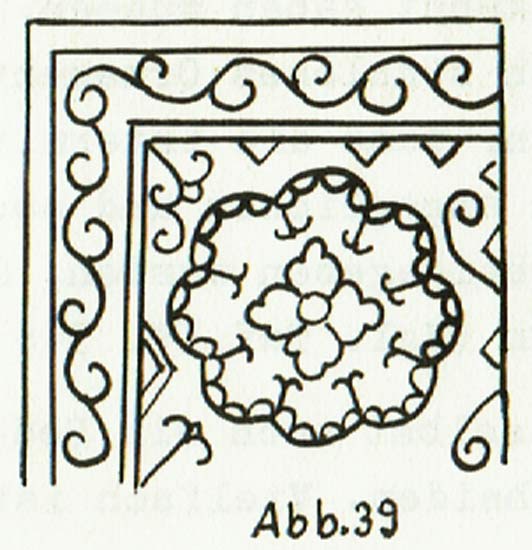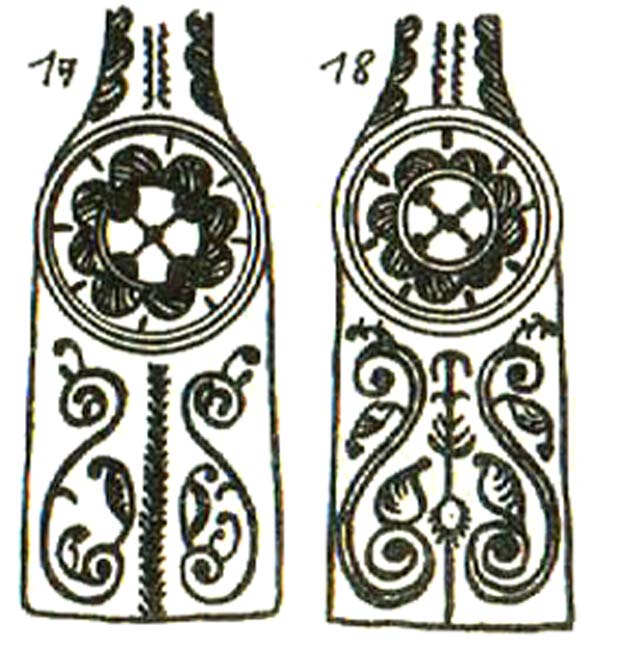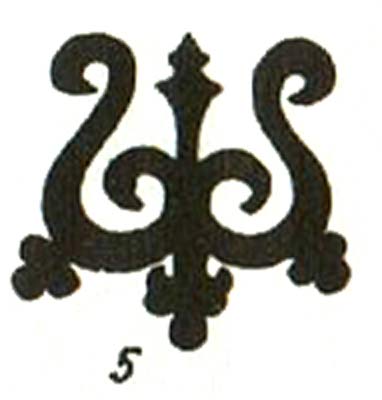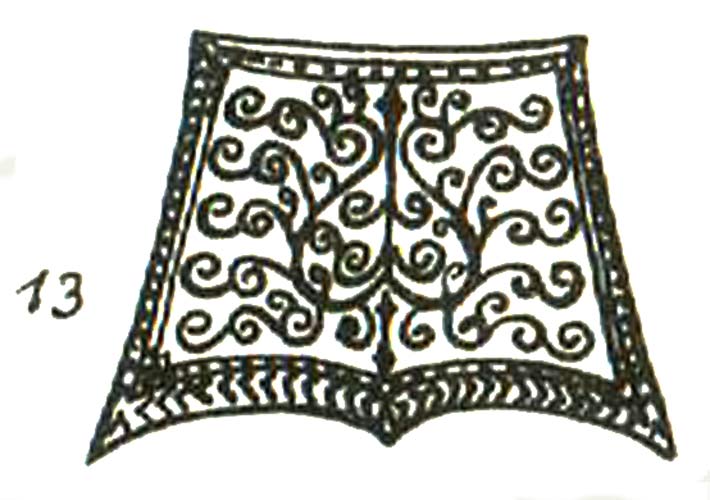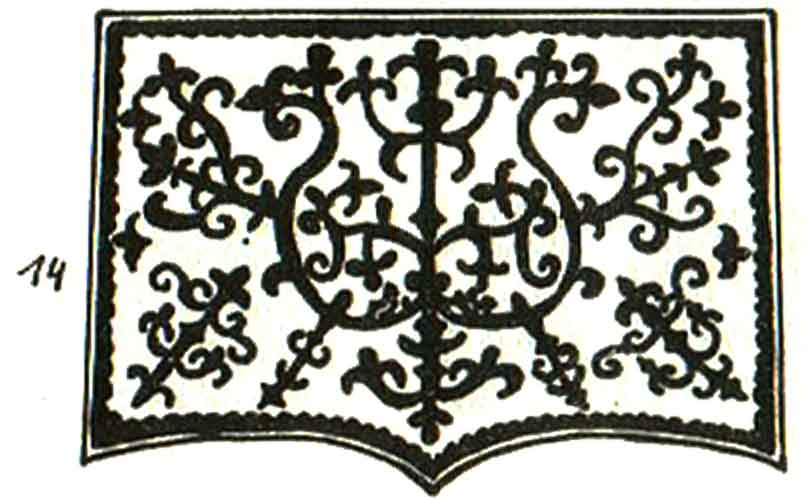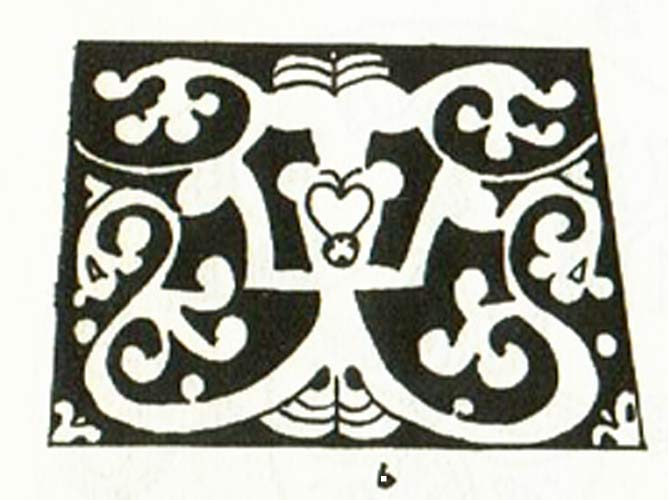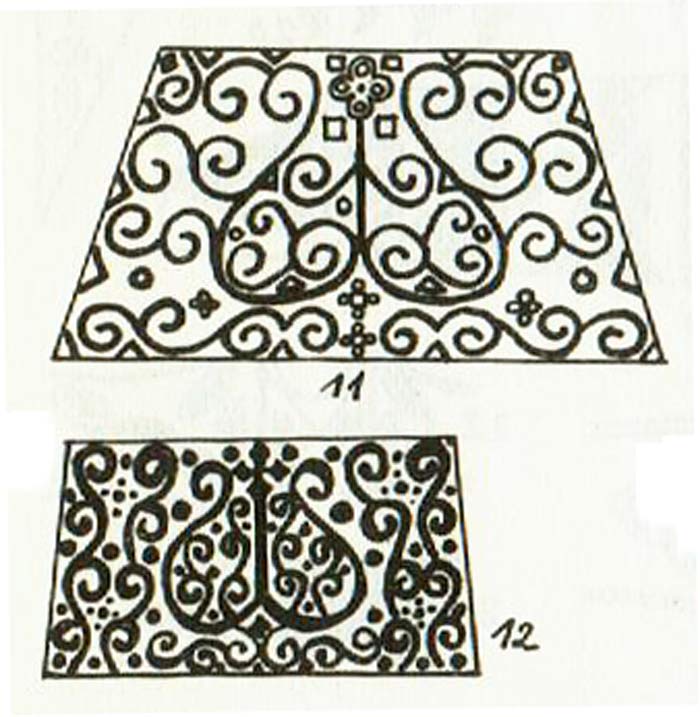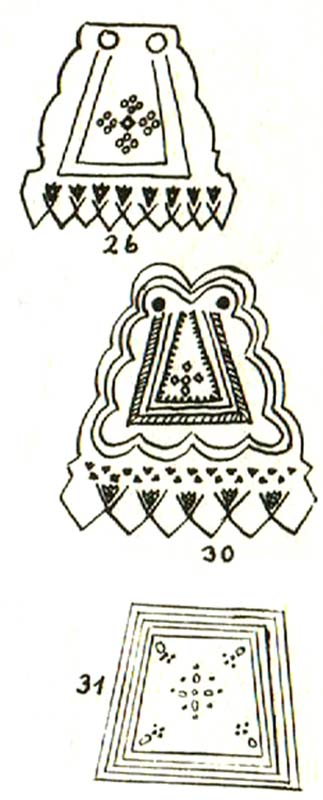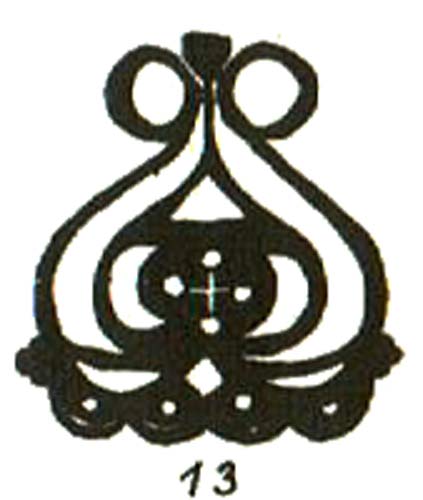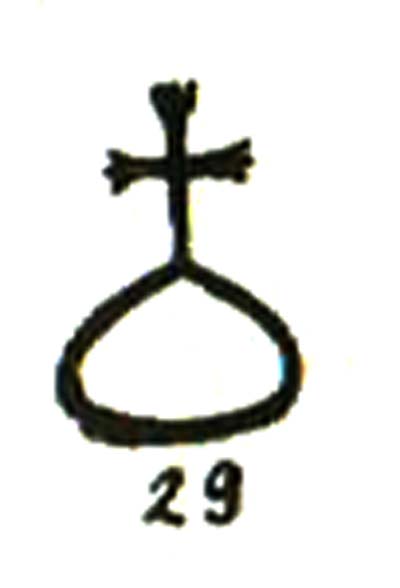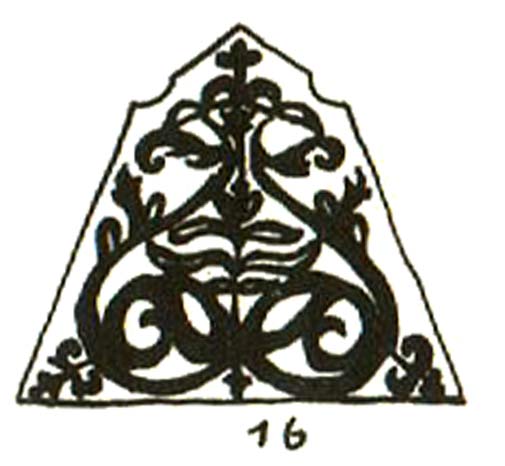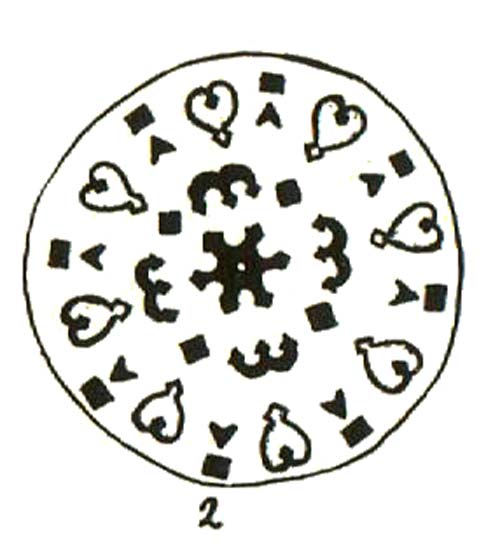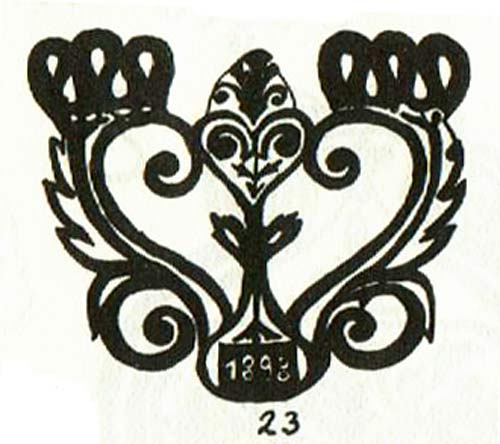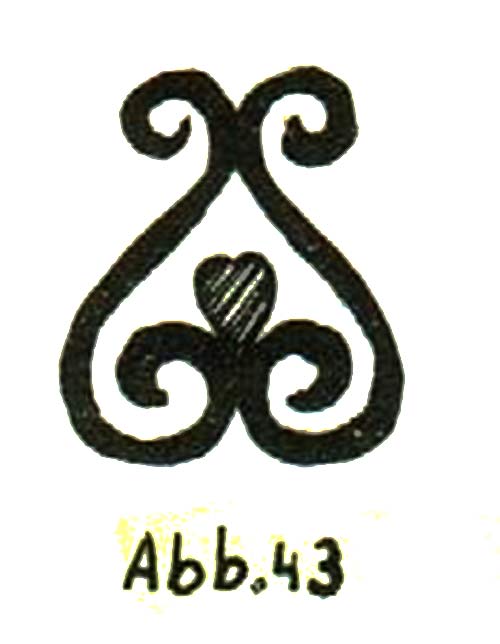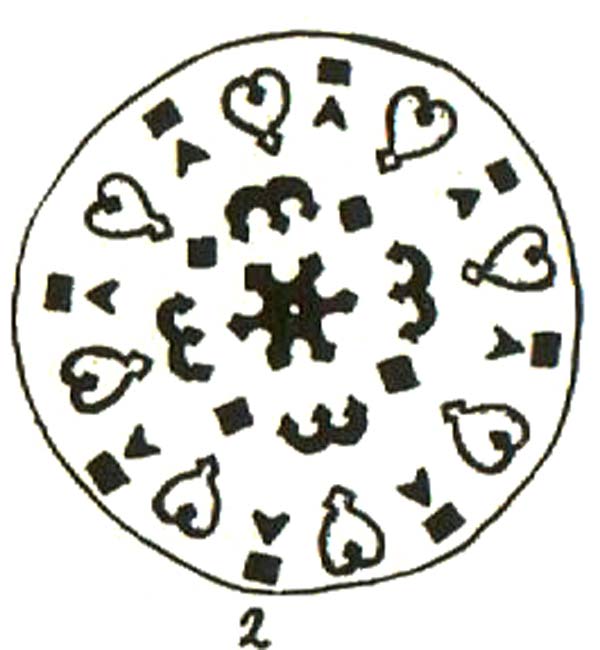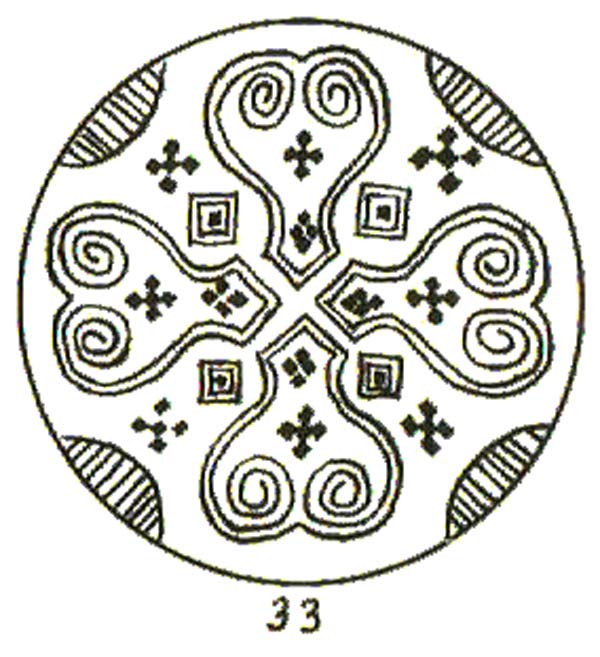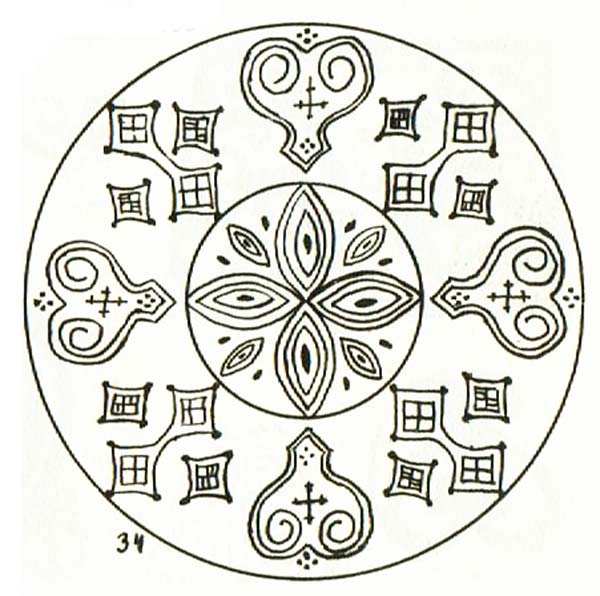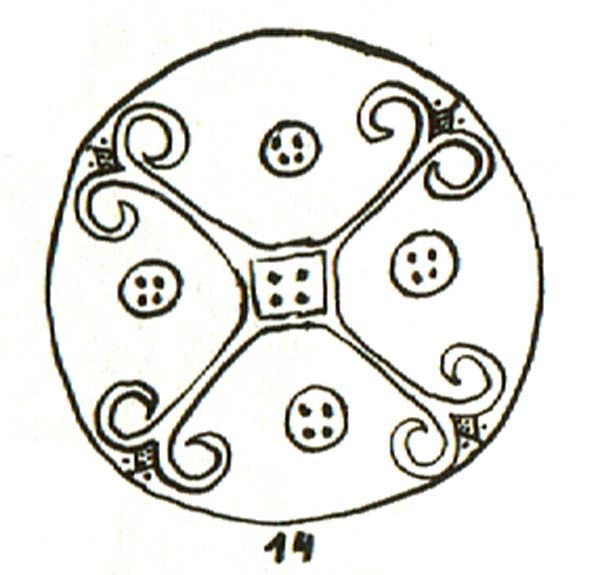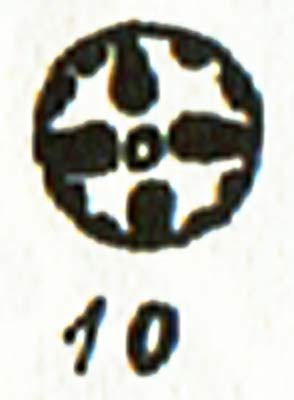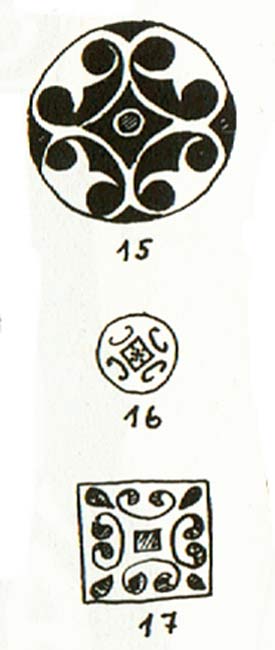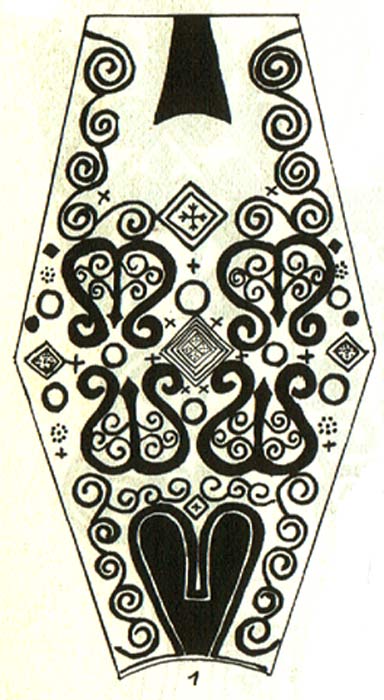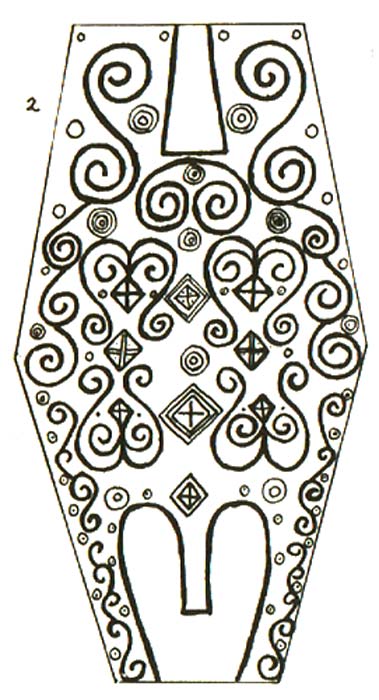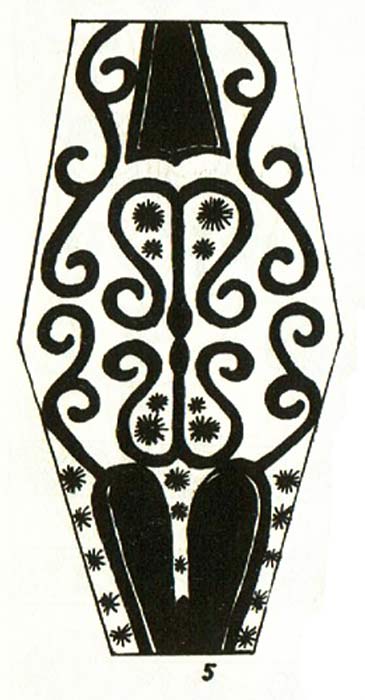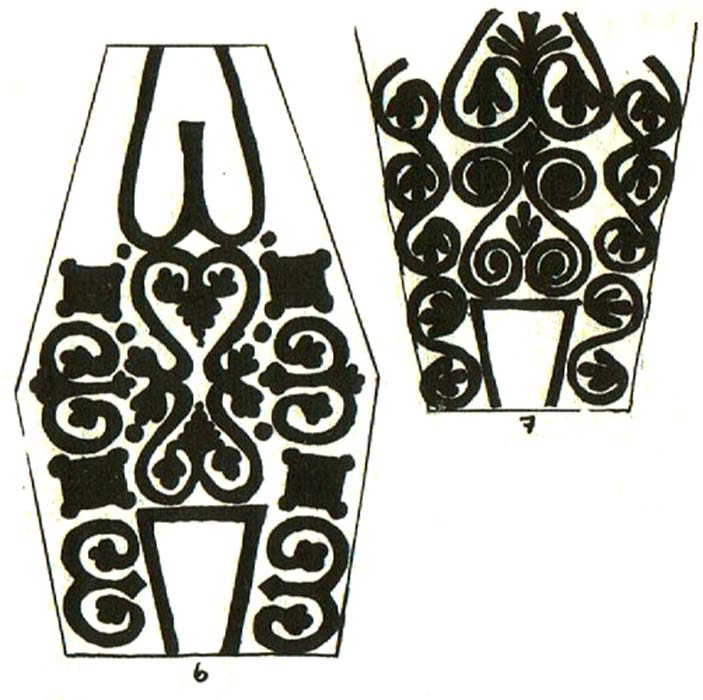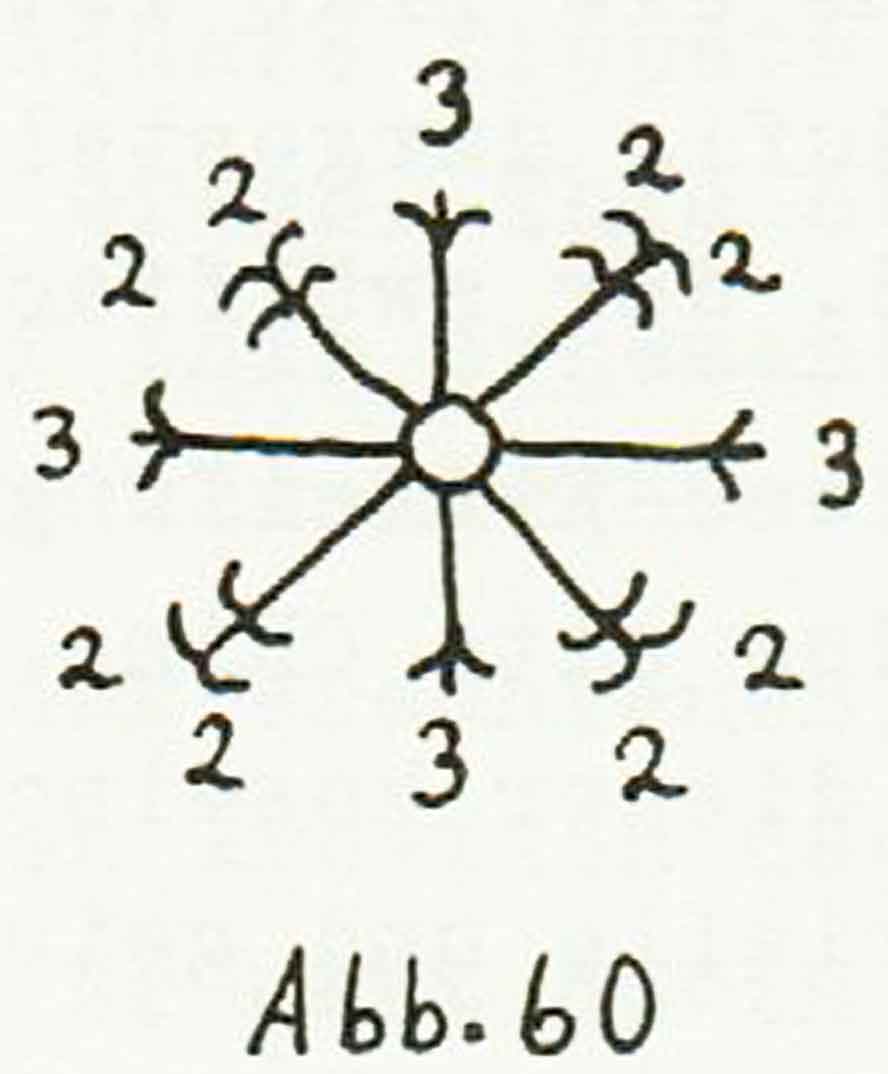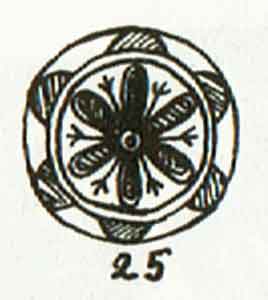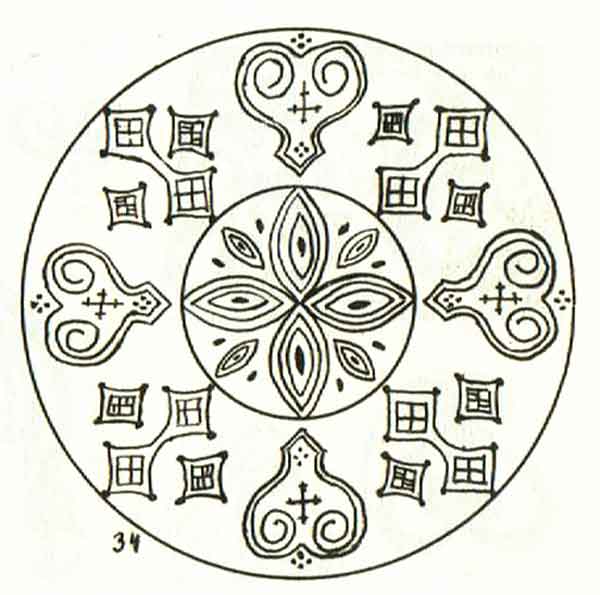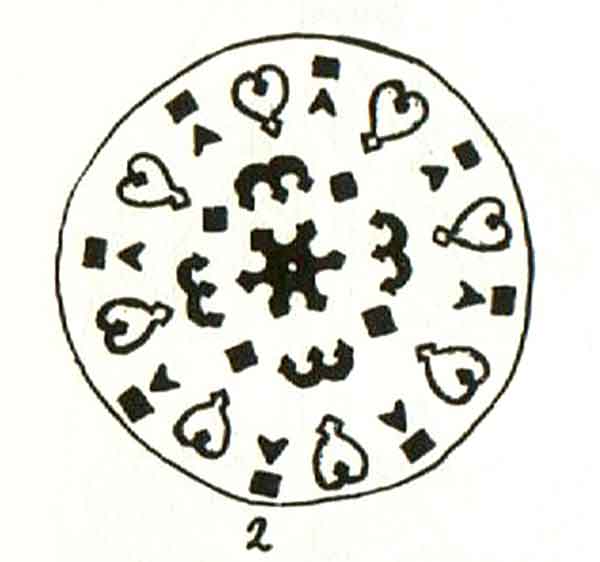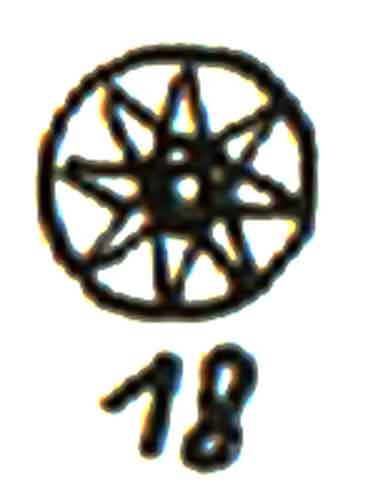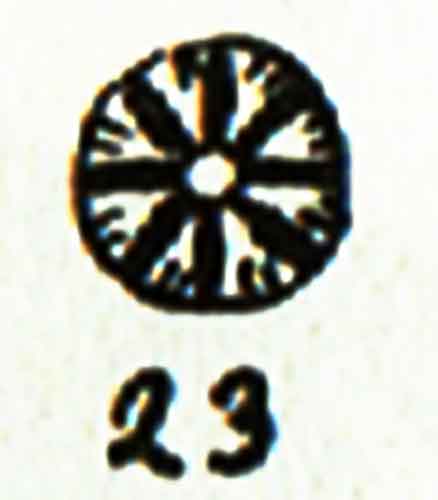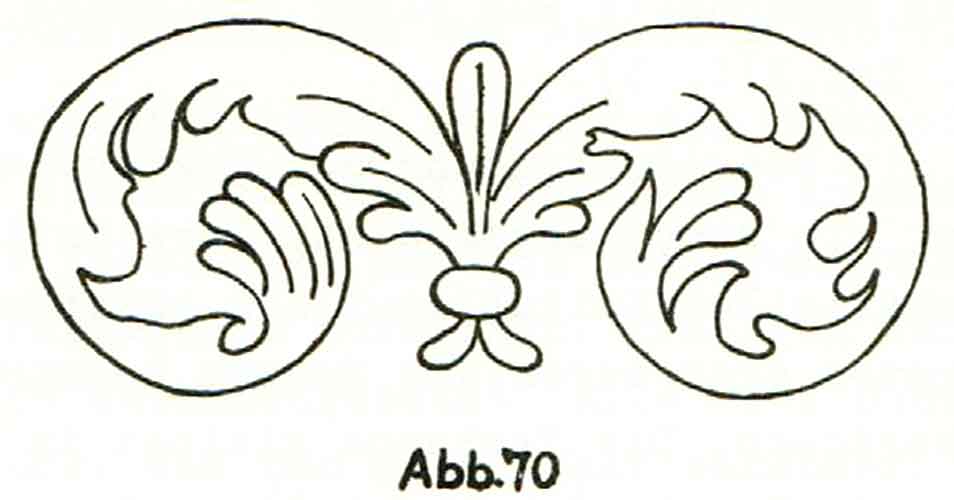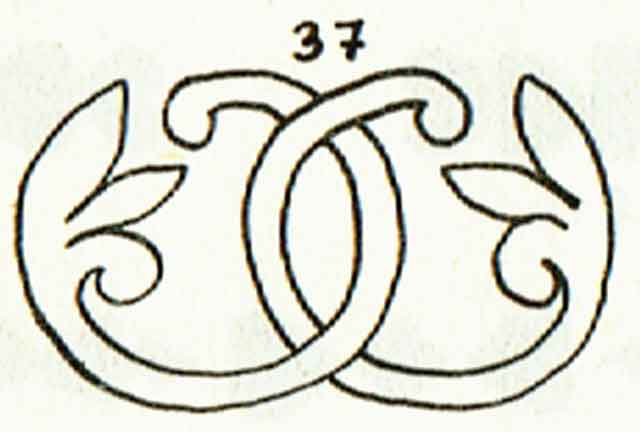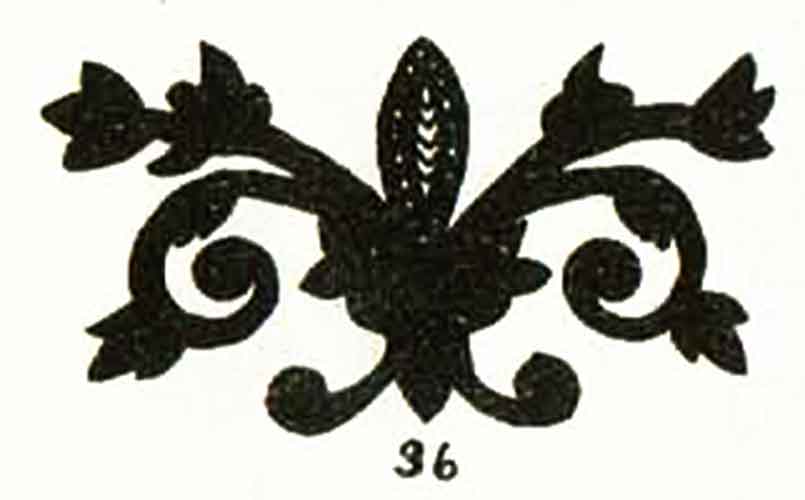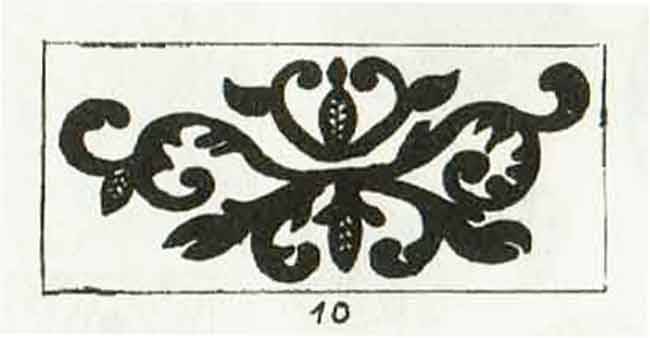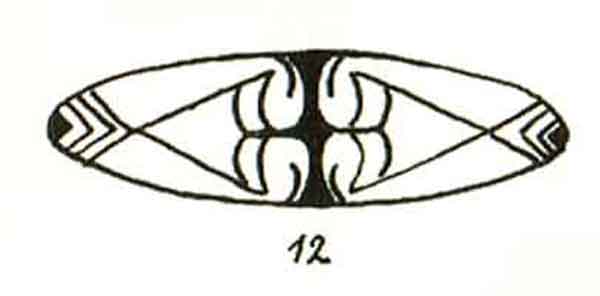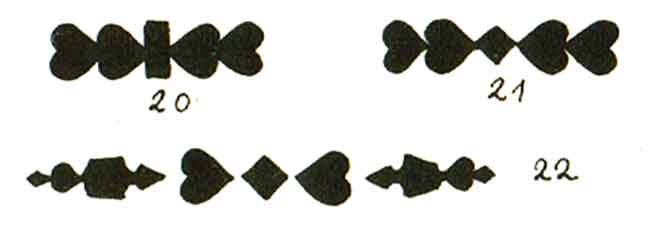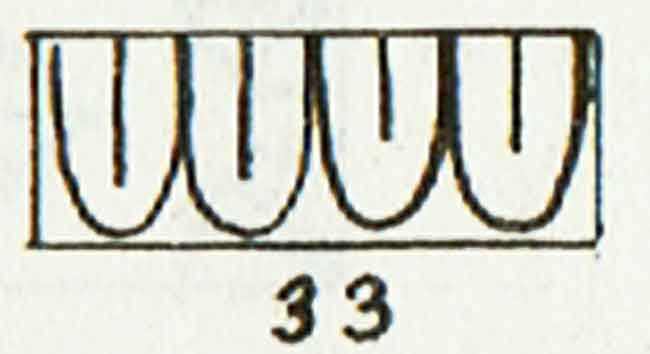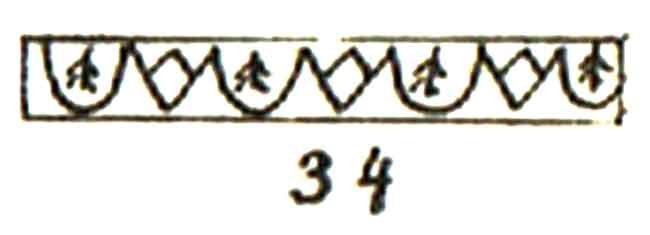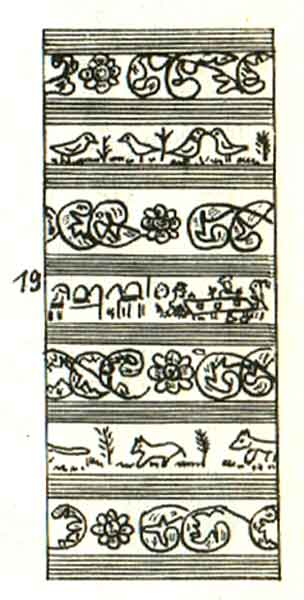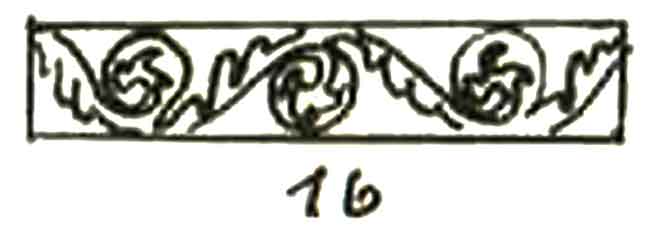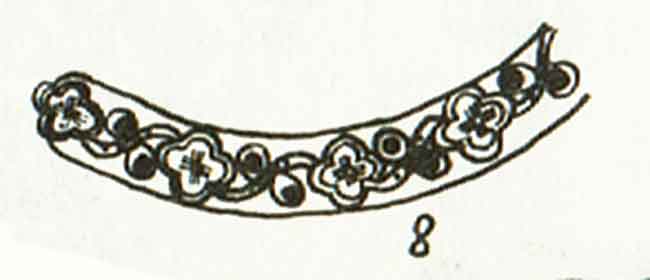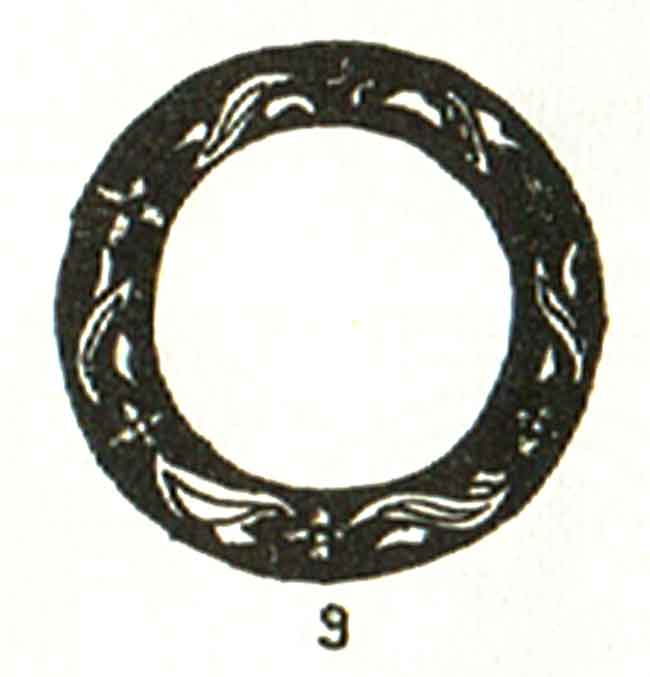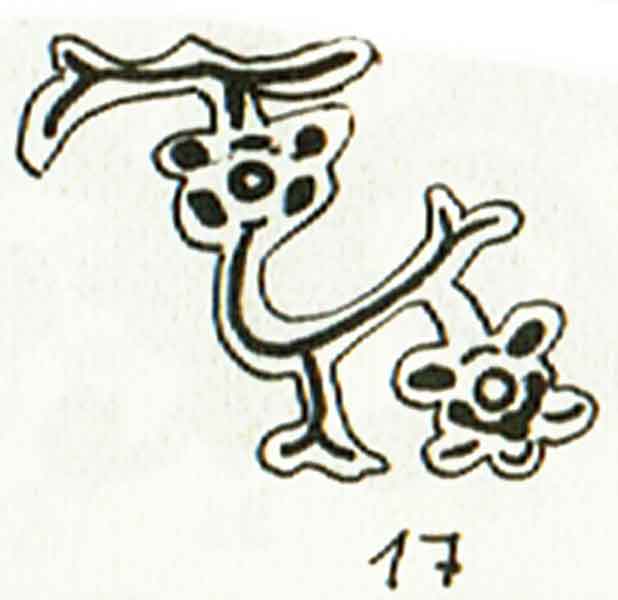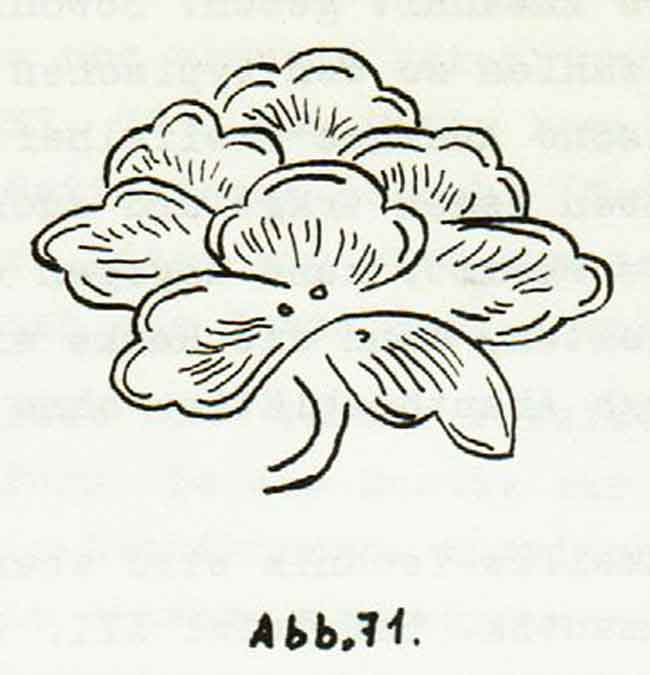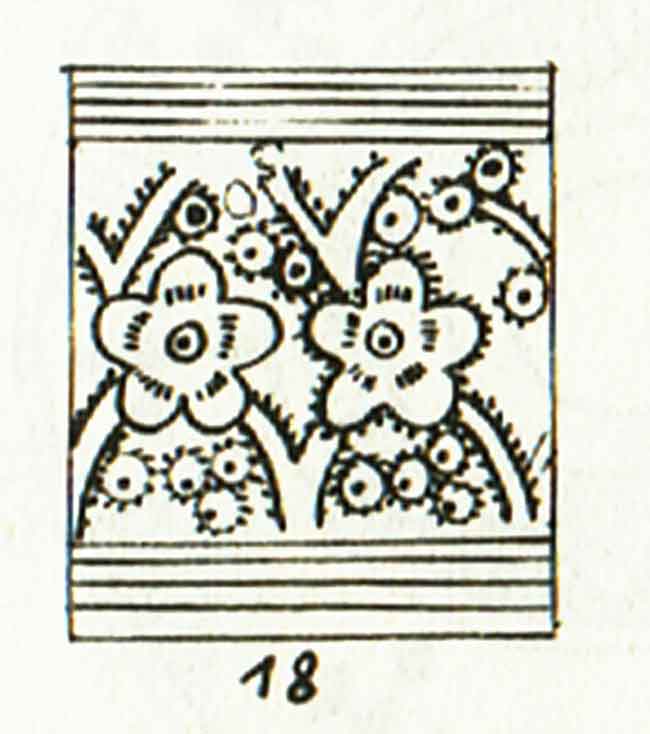|
- Catalog (in stock)
- Back-Catalog
- Mail Order
- Online Order
- Sounds
- Instruments
- Projects
- History Face
- ten years 87-97
- Review Face
- our friends
- Albis Face
- Albis - Photos
- Albis Work
- Links
- Home
- Contact
- Profil YouTube
- Overton Network
P & C December 1998
- Face Music / Albi
- last update 03-2016
|
|
|
|
Revised excerpt of a compilation by Dr. Ulla Johansen, „Die Ornamentik der Jakuten“, published in German in 1954
by the Hamburg Museum of Ethnology as an ethnological signpost; it is out of print today. |
|
|
Below you can see great examples - click on an icon (text) - Enjoy!
© Albi - Face Music 2012
|
|
|
|
|
Introduction
|
Many motives like this appear among finds from pre-Christian epochs of Siberian history (2000 to 3000 BC). Objects of the same kind were found that were manufactured using a similar technique. Thus, derivations seem possible.
Comparable pre-historic finds that came to the surface around Lake Baikal propably belonged to the Yakuts’ ancestors, the Quryqan (Ruan Ruan – Juan Juan), who settled at the same time as the Hsiung-nu in the Altai area. Remains of ceramics are particularly telling. The ornaments are applied to pots in the same way or a similar way using the same technique. These motives include the triangle, the zigzag pattern, the crest pattern and the arch ornament imprinted with fingernails. Regarding their shape and ornament, the Yakut kumis cups can be compared with so-called “Scythian kettles” from the epoch of the animal style, which are attributed to the Tagar and Pazyryk periods at the Yenisei (900 to 200 BC) and which also belong to the culture of the European Huns (the Black Huns). In the middle of the 1st millennium AD, this container was still used by the Kyrgyz, by the 5th to 9th millennium AC only in the Southern Altai.
|
- Hsiung-nu – Xiongnu – 3rd century BC to 4th century AD
- Find more information, including information about these Altai tribes, on - Hsiung-nu - Xiongnu
- Skythes (Sakas – Sarmatians – Massagetae): 8th to 3rd centuries AD
- Tagar culture from the 9th to the 6th centuries AD
- Pazyryk culture from the 6th to the 2nd centuries AD
- more information on the tribes see “History of the Equestrian Nomads“
|
The ornaments are mostly composed of geometric motives. The meaning they used to have is hard to determine today. However, there is no doubt the decorations had a connection to something, which suggests a religious origin.
|
The Yakuts
The largest portion is covered by taiga, but the tree population thins noticably towards the north and finally gives way to treeless tundra in the outermost east and north. In the southern territories, people conduct agriculture and partly animal husbandry. The animals used to be horses and cattle; and in the very north, there is some reindeer breeding as well. Resources found for processing in craftwork were wood and animal products, bog iron, fireclay, and silver brought in via coins.The Yakuts, a Turkic people, live in the contemporary independent Republic of Sakha (Yakutia) in far Eastern Siberia. Its territory extends from the south via the area around the Aldan river and the Central Siberian highland in the West, beyond the river Lena, across the Verkhojansk Range and the Chersky Range to the Kolyma Lowland in the northeast and finally the polar sea. The Yakuts’ living conditions are extraordinarily hard, as the growing season in their area lasts for a very short part of the year. During no more than 60 to 100 days they enjoy a short summer with temperatures above 5 degrees Celsius, which places their land, with the exception of a very small area in the south, in the zone of eternally frozen ground (permafrost).
In one of their legends, the Yakuts say that their creator, when he had made the Earth, sent a messenger over Siberia with a bag full of riches. When the messenger flew over the territory at the northern polar circle, his fingers stiffened, and he dropped everything. Riches like gold, silver and platinum landed on Earth. Irate about his loss, the creator is said to have punished this region with eternal winter. |
|
The immigration of the Yakuts into the Lena valley was among the last migrations of Turkic tribes from Central Asia. Unlike the other Turkic peoples, the Yakuts did not follow routes to the south or west but migrated to the northeast. Their movement began in the 12th century, and it lead them from the southern region of Lake Baikal in a northern direction, at a time when the Mongolian clans were just about to extend their sphere of control beyond the Altai. Their initial settlements are believed to have been at the upper Yenisei, as their craftwork has many parallels to the tribes there. Common life with other peoples already resident here did not always come easy. The Yakuts settled mainly on humid and fertile planes of the large Lena and Aldan arch, at the river Vilyui, and at the affluents of these major rivers. In the north, they first focussed on the humid, accessible river valleys. The indigenous Tungusic people (Evenks, Evens) were forced to retreat to the mountains, where they could still survive, as they almost exclusevily fed on reindeer breeding, just like remaining Yukaghirs in this territory, who are almost entirely extinct today. They are one of the oldest and today also the smallest people in this area. They settled here in the northeast as early as the Neolithic Era. The Taiga Yukaghirs at the upper section of the Kolyma river and the Tundra Yukaghirs north of the Polar Circle lived as reindeer breeders and hunters of fur-bearing animals.
Later, during the Iron Age, the Evens, followed by the Evenks, progressed into this area. Both are Tungusic peoples, and both were initially nomads. Up north, they bred reindeer and hunted fur-bearing animals. However, note that these areas were retreats these minorities were forced into by the heavily propagative Yakuts. Legends of the Yakuts and the Tungusic people involve fights that supposedly took place. Many of these peoples have been entirely “Yakutized” by today, like the Tungusic Dolgans. All Tungusic people had to retreat into the higher mountainous areas during the past two centuries, where they live together in peace today.
|
|
|
- Uralic group – Ugric people: Khants (Khantys), Mansis, Samoyedes (Nenets, Enets, Nganasans) and Yukaghirs
- Altaic group – Turkic: Yakuts (Sakha), Tuvinians, Khakas, Altaians (Oirates, Teleutes, Telengites),
Uyghurs, Mongolic and Tungusic people (Evenks - Evens)
- Paleosiberien group: Ainu, Koryaks, Itelmens (Kamchatkan), Chukchee (Tshuktshen)
|
|
- Work with the Aboriginal peoples of Siberia following - currently under construction!
|
New-age archeological finds show parallels between the Yakuts and the Buryats and Altaians. Although their vocabulary indicates earlier ethnological research, affiliation with the Tungusic (Evenkic) group is easier to back up. During the 14th century, a large part of them was “Turkized”. Today, the Yakut language is classified as a Turkic language. Comparison between the mitochondrial DNA of Yakuts and that of other Eurasian peoples shows high accordance with the Evenks, who partly settled in the same area, and the Turkic-speaking Tuvinians who live in Southern Siberia at the upper Yenisei river. The Yakut society was traditionally composed of the nobility (leaders), free citizens, and slaves. They lived as hunters, fishermen and, to a much smaller extent, as peasants, reindeer or horse breeders.
Ever since the period prior to World War II the population has shifted very much in favor of the Russians. Digging for the vast abundance of gold in the areas at the upper section of Kolyma river and in the areas of the rivers Aldan, Vitim and Patoma lured many workers into the region. This recent development does not have to be taken into consideration when talking about ornaments, as their materials are from earlier periods. However, for a better understanding of the Yakuts’ ornaments, their world view of earlier times has to be described, where many motives and symbols originate.
|
The cosmos as a whole is divided into an upper, a lower, and a middle world, the latter being inhabited by humans. In the upper world, which they imagine to have seven celestial layers, the white lord creator “Ürüng Ajy Tojon” resides, who is also simply called “Tangara”, sky or sky god. The underworld, on the other hand, is dominated by “Arsan Duolai”. The other spirits live in the middle or lower world, which are not separated by an exact line. A moral judgement on good or evil and eternal revenge were alien to the Yakut mind. Also, the spirits of the individual planes did not have any relationship to one another but they each ruled as independent lords in their respective territory. This can be compared to the animism of other peoples. Animism means nature having a soul and also includes certain practices of shamanism and curing. In this we can find parallels with Turkic peoples in the Sayan Altai Mountains and the Mongolians, as well as in the ornaments. Ever since pre-Christian times, culture is based on a dualism of Father Sky and Mother Earth, which is hardly different from the Chinese principle of Yin and Yang. Ying equals the Earth, while Yang corresponds to the sky.
|
- Find further information on the religion of the indigenous peoples of Siberia as well as on shamanism at: Religion of the indigenous people of Siberia und Shamanism (Tengerism) in Mongolia
|
The religion of the Yakuts has retained its animist world view. The Yakuts imagine nature, and partly the objects in it, to be inhabited by a soul, an owning spirit whose rights have to be respected. To insult this spirit would have the most terrible consequences. They were called “iggi” or “ongon” = spirit’s dwelling. They may live in rivers, on mountains, or in a blacksmith’s tools, or maybe in the fermented mare’s milk called “kumis”. People offer horse’s hair to the spirit of the mountains or the spirit of fire, while a small grey man is offered some drops of butter. Two spirits (souls) live in one person, one of which causes the procedures of the body, the other those of the mind. Following death, the latter turns into the spirit of death. In order to protect oneself from his persecution, people carve human-shaped figurines out of wood, then the shaman places the soul of the dead inside them by magic, and they are packed into a little birchbark bag. This bag is suspended in a corner of the house, and offerings are made to it. Very often, the shape of a former female shaman, “Makyny-Kysa-Tynyraxtax Kagai”, who turned into a kind of fury when she died, is depicted. It is carved from wood and clad in fur. Even if a shaman has placed her spirit into this doll, it is still dangerous to touch this idol, which is usually placed on the mantle above the fireplace. The wrath of this being who shall not be named, the wrath of “Kys-Tangara” the “virgin goddess”, could break out and do evil. The Yakuts say that the spirit that resides in every object shows itself via the shadow it casts.
The shamans act as mediators between these spiritual beings and humans. They cure their diseases, negotiate on the sin offering and perform the respective ritual. They are responsible for the balance of and compliance with all the rituals within the family or society. Totemism manifested itself in the belief that the shaman retains animal spirits who help him during his visits at the spirits’ dominions, in particular birds. Shamans are also protectors of certain individual families. Also, the shaman is accompanied by other, invisible animal spirits, such as a bull, stallion, bear, elk, or eagle, and he has to die together with them. Not all shamans were equally powerful and capable of communicating with all spirits. Those with a horse totem were considered the most powerful because apart from the eagle the horse was viewed as the noblest of animals. An earlier subdivision into black shamans for chthonic spirits (dark spirits who live underneath the earth) and white shamans for the beings of the sky no longer applies.
This religiosity accounts for the fact that the Yakuts avoided any kind of biomorphic representation (live, biomorphic shapes in sculpturing) in their art, in sculptures and drawings as well as in ornaments. Any realistic human or animal shape was capable of coming to life as an evil demon that would turn against its creator or its environment. Realistically shaped animals attached to the shamans’ clothes constituted an exception, as they were considered actually alive. Even toy cows were represented schematically and non-realistically, without legs, a tail or a head, so they could not be instantly identifed as cows. The Yakuts lacked the ability of drawing by nature. Still, it is amazing how simple their drawings appear compared to their highly developed ornaments.
|
| Note this depiction of a drawing of a shaman and his bird next to a seven-branched birch, which the Yakuts considered a ladder to heaven. |
|
|
The Yakuts were alien to realistic representation, even in decorative art.
However, they were fond of harmonious, evenly shaped, entirely abstract ornaments, which appeared to them to be the highest form of art. In this field, the Yakuts achieved absolute perfection. They felt an extraordinary need for symmetry, which is also found in other Siberian peoples. Still, only Paleosiberian peoples, like the Eskimos and Kets, produced rather vivid drawings at the Yenisei, but those are not of interest here.
|
- Kets (Keto) – Self-designation “ket” (“human”) or “deng” (“people”); historical designation: Yenisei Ostyaks – they speak a Paleosiberian language.
|
Objects designed of mammoth ivory in the New Age bearing figurative representations can therefore definitely be considered non-authentic. Apart from these products there were no other figures that served profane, unhallowed purposes.
Language: The Yakuts are the northernmost Turkic speaking people. They are referred to as Turkic because the construction of their language and their vocabulary equal a very old form of Turkish while part of it has Mongolian origins and incorporates Tungusic, Samoyedic, and Yukaghir expressions or expressions of entirely unknown origin. Their subsistence strategy as horse breeders seems as unusual as their language because to breed horses was not customary among their Tungusic and Paleosiberian neighbors.
Origin: The fact that the Yakuts immigrated from the South has never been doubted. They were forced into the Lena area from the Baikal region. This was irrevocably confirmed only by excavations showing extensive matches between pottery products of the population that inhabited this area until the end of the 1st millennium and Yakut products. The Yakut ornaments are part of a Sayan-Baikal-Lena art circle, which is expressly distinct from the art of the neighboring peoples. Differences are most significant in spiral and plant ornaments. Their migration into this northern area is believed to have happened in a time prior to the Mongolian expansion because in the Buryat folklore, many memories of Genghis Khan have remained, which the Yakuts had never heard of. The first historical information of the Buryats progressing to the Baikal region is in fact from the 12th century AD, which means, it was apparently associated with Genghis Khan’s entry into power, or it happened shortly before. Accordingly, a first wave of ousting the Yakuts from the Baikal region probably began in the 9th century AD. Originally, the Yakuts settled at the upper Yenisei. Proof of this view is found in the similarity between the very early “Tataric” and the Yakut languages, and the similarity of numerous cultural elements of these Altai peoples. Their self-designation “Sacha” is supposedly the result of remains of Turkic peoples at the upper Amur and the Selenge, which call themselves “Sagay”, “Sachaz” or “Socha”. It is for the same reasons that they are also viewed as inhabitants of Dzungaria, as a “Socha” tribe already existed at that time. However, the Yakuts were always a uniform ethnic tribe who was probably ousted from the Sayan-Altai Mountains.
|
Who were the ancestors of the Yakuts? Russian researchers believe they were the Quryqan (Ruan Ruan – Juan Juan), who resided west and south of Lake Baikal, who were referred to as “Ku-li-kann” in Chinese sources, a Turkic people who lived north of the Eastern-Turkish Kingdom from the 6th to the 9th centuries AD and whose name appears in the Orkhon runes of the 8th century AD as well. Russian scientists believe that by extending their area of power in the early 9th century, the majority of the Quryqan were forced to move north. This sudden emigration is proven by burial objects. A smaller part stayed in the country, being subject to a first Mongolization by the Kitan (1), and was incorporated by the Buryats after their invasion. This theory is rather plausible because the Buryats invaded their current territory in several smaller hordes. Had they encountered the still closed mass of Yakuts settling here, being fewer in number, they would have lost to them without any doubt. This slow takeover was only possible because the country has a relatively sparse inhabitation. The Kitan on the other hand, who progressed during the 9th century AD, were a war power who had to be capable of ousting the Yakuts. Certain similarities of the Buryat and Yakut cultures are explained by the fact that parts of them must have had the same ancestors. The Quryqan invasion is placed in the Iron Age, i.e. the beginning of our common era, as proved by pre-historical finds. Nothing certain is known about their whereabouts before this period. The above findings are convincing because the Buryats did not pursue pottery. The Quryqan, however, left remains of pottery behind that bear a striking resemblance with those of the Yakuts. This cultural element connects them to the other Turkic peoples of the Altai in the 6th and 8th centuries AD as well, who also produced rather coarse pottery (2), which is contrasted by their highly-developed metal works. Politically, the Quryqan belonged to a group of Turkic peoples in the Altai who shared the name “Tu-lu” or “Tu-lis”, under which they were referred to in the Orkhon documents. The first time they are mentioned is in Chinese sources due to their fight with the Turks (t'u-chüeh) another Turkic ethnic community of this area, in 552 or 553 AD. In cultural terms, these Quryqan and the peoples of the Altai area they were associated with resembled the Yakuts of today in many respects. The wore fur and wool garments. In their totemist symbolism, the horse was held in high esteem. They produced kumis from mares’ milk. Like the Altai peoples of today, they mounted the heads of offered sheep and horses on rods, and they worshipped the sky and the Earth. Their society was divided into classes. Moreover, they possessed a rich art of smithery, they pursued horse and cattle breeding, and agriculture.
|
- (1) Kitan or Khitan: a Protomongolian people from Manchuria that existed as early as the 6th century AD.
- (2) Pottery: During excavations conducted mainly by Petri around Irkutsk and at Lake Koso-gol after World War One, for the first time, pots of the same design and with the same ornaments were found, from which it was concluded that at least part of it was the work of the Yakuts, who must have lived in the area that is today classified as Buryat territory. These finds belong to the early Iron Age. In the Neolithic Age on the other hand, the pots were thinner and unsuitable for transportation, which allows the assumption that a settled population resided in this area at the time. Also, not a single geometrical ornament of these products shows parallels with the Yakut pottery. In contrast, its similarity to the pottery of the Iron Age is striking. Not only are materials, production method and ornaments similar, but ceramic production must have been left to women at that time, which is concluded from the strikingly small fingerprints. Pottery products of this kind were also found in the currently Buryat area of settlement at the upper section of the Lena river, in the Silka valley and at the Selenge, and they were common even in Mongolia. In the West, the area of these ceramics was extended beyond the Sayan Mountains to the eastern hillsides of Minusinsk Hollow and the area around Krasnoyarsk. Further south, in the Russian Altai, ceramic products of this kind were produced until the 8th century AD. This means that the Yakuts probably formed a group of pottering tribes of these territories around them.
Tokarev believes that the Quryqan could be ancestors to the Buryats, but he does not further comment on this hypothesis. It is generally doubted today.
|
Ethnical mix: Due to the Yakuts’ relatively late immigration, a mix of the peoples originally inhabiting the Lena areas must have taken place. There are two distinct types: Mongolids with a flat face and nose, and some who appear more Turganid having longitudinal faces and a narrower, further protruding nose. This express two-way division does not generally apply to the apparently Europid Dingling (1) ethnicities, as they mainly belonged to the upper class and the leaders (chiefs). The majority of the Mongolids were nomad shepherds (and subordinates). Until the Turks invaded, the Tungusic peoples were the leading class.
|
- (1) The Dingling were a South Siberian people. They initially lived at the upper section of the Lena river, west of Lake Baikal. In the 3rd century BC they began to expand in a western direction. They were part of the realm of the Xiongnu (Hsiung-nu)..
|
- Find further information on nomads on horses at: „History of the Equestrian Nomads“
|
The Ornaments
|
In general, a lot remains unclear when viewing the Yakut people historically. Much about their spiritual culture is still unproven. For the moment, only a description of their ornaments can be tackled, accompanied by references and comparisons to other Siberian peoples. If we manage to read the symbolic content correctly and to track it back to earlier times by means of archaeological finds their spiritual culture and their past can be identified. If a motif is considered holy or worthy of protection, it is reproduced many times, which in turn helps it to become a decorative element. Thus, the ornaments constitute one of the most independent elements in the culture of a people that is more difficult to change than objects of a purely material culture. The ornament thus becomes an important witness wherever written sources are absent. In ornaments, one can find indications of contact between peoples and of their mixes, and these signs are often more reliable and durable than anthropological or linguistic features.
- Ornament studies for Siberian peoples were conducted by Finns: Sierlus studied the ornaments of the Ostyaks and Voguls. Laufer’s object of study were the Amur peoples far east, Ryndin observed Kyrgyz decorations, while the Buryat ornaments, which are the most important, were analyzed by Petri. The Ket ornaments were studied by Anugin, those of the Altai people by Anochin.
- Jochelson visited the Yakuts in the years between 1884 and 1894 and between 1900 and 1902, while Sieroszewski also spent 12 years among them in about the same period.
Metal processing was left to professional blacksmiths. Other works on various kinds of materials were manufactured at home, especially during the winter. Men produced wood and bone carvings with their knives. Women were left to do all needle, fur and leather works as well as braiding, glueing and pottery. |
- see more information about – Ornaments of the Turk-Mongolian tribe (cloths, ceramics, handbags, tools etc.)
|
Beadwork: This technique has only been applied in recent times, as colored glass beads were introduced by the Russians. The technique is popular with both the Paleosiberian and the Ugric peoples. Mostly the beads decorated women’s fur pants, followed by knee-high fur boots and colored little hats. Decorative plates braided with beads are found as the fringes of saddlecloths and on bags.
Multi-color embroidery: The material used for multi-color embroidery, mostly only loosely twisted silk threads, was obtained from Russian or Chinese merchants. Imported wool cloth or chamois leather (leather produced by tanning with tanning materials based on oxidizable fats) were used as supports. Three kinds of ornamental stitches are known: the stem stitch, which looks like a single twisted thread, the Mosul and the Yanina stitches, better known as the herringbone stitch (fig. 2) and the satin stitch, respectively. The stem stitch mainly serves the purpose of re-bordering the patterns applied with the herringbone stitch, often in a different color (fig. 3). The colors of the accomplished patterns are kept very harmonious and restrained.
|
In satin stitching the silver thread introduced by the Russians is used. The figurines of the pattern, cut out of cardboard, are overstitched with yarn. Strangely enough, the Yakuts lack tambour embroidery, which is otherwise common and characteristic for Russian, Chinese, Kyrgyz and Buryat works (the embroidery hoop that the material to be stitched is tightened to is referred to as the tambour). It was very frequently employed in pre-Christian times, as confirmed by finds in Noin Ula in Mongolia (kurgans from the 3rd century BC). The backstitch was not a decorative stitch for the Yakuts either. On thick pieces of suede or fur the material was not pierced completely. Only specific objects were ornamented, such as large panniers, saddlecloths and parts of little summer hats, fur hats and fur gloves. Unlike the Kyrgyz, the Yakut women did not have coats decorated with embroidery.
Birchbark containers were overstitched with hoops made of birchwood using simple stitches (figs. 4 and 5). This rendered the containers more durable, and the seams made of horsehair yarn served decorative purposes at the same time.
The dark, interrupted bark streaks form geometrical patterns themselves. Another type, made of stamped metal foil obtained from teabags or colored paper have a decorative effect. These techniques, however, are probably not of indigenous origin. |
|
|
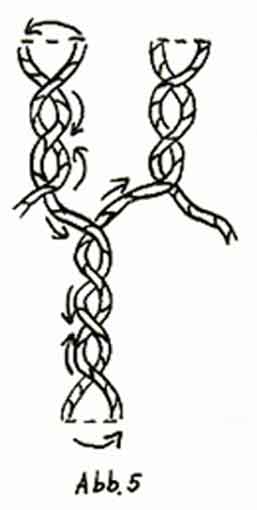 |
|
|
|
|
|
| Appliqués, textiles and fur mosaics: Certain shapes made of leather, fur or textiles were applied on a support of a different color. They are glued on, while the edges are fixated with stitches. This shape was not common with the Yakuts but found in Noin Ula and in Pazyryk kurgans. |
The Yakuts also used mosaic patterns. They are the result of small pieces of colored cloth being cut out with scissors and sewed onto one another. The patterns were rectangular, and in order to avoid showing the unsightly left side, the colored surfaces were sewed onto the edges on sackclotch in their entirety. Even more variety could be created by adding a narrow piece of cloth in a third color into the seam (fig. 6).
|
 |
|
|
|
Fur mosaics were produced exactly the same way, except without the decorative streak in the center of the seam. Solid hemp threads served as a stitching material. Small iron broaches with a wooden grip were used for working. These works correspond to the fully known patterns of Paleosiberian fur works.
Carpets, saddlecloths and small satchels mostly used for carrying tobacco are decorated with these patterns.
|
Braiding works and the production of straps: Weaving and basket weaving were unknown to the Yakuts. What they were good at is producing mats from grass and straps out of horse or reindeer hair. Straps were made of tightly twisted threads that were wound around one another. To retain patterns, dark and light cords were used (fig. 7).
Several of these straps put next to each other, running up and down, create a zigzag pattern (fig. 8). This is also the method by which the Yakuts produced mats out of reeds. Poorer people used furs as supports for sleeping. However, the individual straps were not threaded but braided like plaits.
|
 |
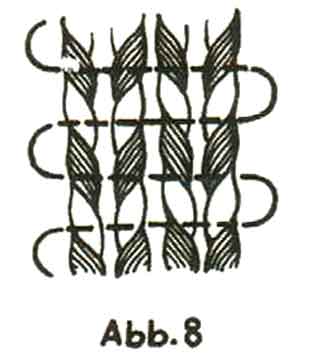 |
(fig. 9) The braiding technique was not applied by the Yakuts. |
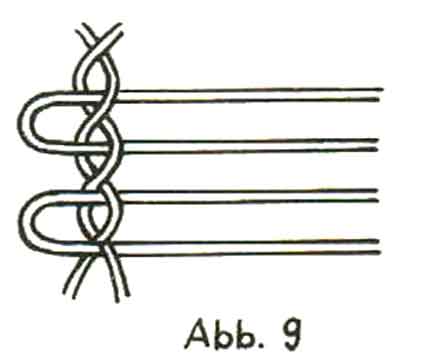 |
|
|
|
|
|
|
Pottery: Chamotte, which is frequently found, except in the north, is used as the raw material. Preparation includes mixing clay with finely struck shards of old containers. The potter’s wheel was unknown; for shaping the object a simple spheric or semi-spheric stone and a little modelling plate were used. To achieve a circular shape, several circles made of a type of purple willow were utilized. The pots were coated with wood and baked several times until they had a red glow. In order to cure them, hot water mixed with one or two tablespoons of milk were added when extracting them from the ashes in a heated condition. Glaze of any kind was not known. The ornaments were imprinted with wood stamps before the clay was baked. Very often they are found as additional decoration on draw beads. The clay containers were never painted; the ornaments were generated solely by stamps and fingerprints.
Mongolian and Tungusic ethnicities did not have their own pottery works.
Needless to say, there were numerous taboo regulations due to the fact that pottery was considered “impure” and that clay contained a type of earth spirits or chthonic possessors (chthonic spirits who bring life and fertility but also death). That is why, for example, it was avoided to leave the containers outside during natural events like storms, because it was not a good idea to allow them to break. The same fear arose when someone found a piece of a tree hit by lightning among the wood during the firing process. Sometimes the mere fact that the pure spirit of a domestic stove refused to unite with the impure spirit of pottery in the process of firing was reason enough for the pot to burst.
|
Ornaments on wood and bark
|
For more delicate objects, which were ornamented as well, birch wood was used almost exclusively. Birch wood was an extremely popular material, being more durable and easier to bend. Tools included axes, knives and hand drills. This small, relatively bendable knife is still used today for producing ornaments.
Ornaments were scored or carved as semi-reliefs using the so-called bevel cutting technique. The wood was not varnished. Fabricated objects, such as the kumys cup, were simply rubbed with butter or cream to prevent the wood from drying up or splitting. Painted ornaments were not found. Sometimes the wood would be painted dark brown in order to put special emphasis on the lighter cuts. Alder bark was used to obtain this dye. The black color was due to abnormal protrusions on the birch trunks, which form a deep black color in combination with ashes and cream. Protrusions of abnormal ulcers of horses beneath the fur of their armpits or at their groins were also used to obtain dyes simply by cutting them open. When the patterns were completed they were rubbed with cream in order for the bark to continue to be smooth and then glued on. This work was done by women, too, by way of exception. |
Chip carving was only used to decorate objects for storing kumys (the mares’ milk), cups used for beverages, and large scoops. The ornament consists of indented lines and broad oval immersions, which appear like leaves in the ornaments.
|
On wooden boxes, on the other hand, the ornament is generated by scored lines (scoring technique). When these are somewhat broader this technique can create the impression of a semi-relief.
|
| From birch bark as such, only the ornaments for wall hangings and doors or tents covered with birch bark and birch-bark cans were made. First they were soaked in water for a few days, then the top layer was scored off and they were painted. |
Manufacture of horn, bone and mammoth ivory: The same knife used for wood was also used for carvings of this kind. Since the Yakuts, as mentioned previously, did not create bimorphic representations because they did not want to disgruntle the spirits, it is more likely that carved figures made of mammoth ivory in semi-reliefs on little boxes and combs are from the New Age. For the Chukchi people, figurines like this one made of bone material were a much more common resource, and a tradition. This method of bone manufacturing was probably adopted from the Tungusic and Samoyedic peoples.
|
Smithery: When the Russians immigrated, the Yakuts were the only Northern Siberian people who had experience in recovering iron, brass, and copper. Silver, gold, and bronze had been used by these nomadic peoples in Southern Siberia for ages. The smiths themselves recovered ore from the resources they worked with. Other metals were imported. Manufacturing with cast iron was only introduced with the arrival of the Russians.
A large part of the silver was introduced in the form of coins that were reengineered into jewelry. Gold was less popular. Although an abundance of gold was present in the Lena area, it was not manufactured to a large extent. Instead, large amounts of ore and bog iron ore were smelted. To do so, holes in the ground that could be covered with a clay cap were used as stoves.
Ornamented iron objects hardly existed, with the exception of shamans’ jewelry, which it is more appropriate to refer to as sculptures than ornaments, as individual pieces were designed to represent certain objects. Important tools for the smiths were the bellows, hammers, pliers, anvils and rasps.
Sword-like weapons made of iron bear plain arch- or spiral-shaped ornaments on their blades. Individual objects were manufactured from brass. They include metal fittings on horse halters and shamans’ jewelry. Some products came to existence only under Russian influence, such as signets (hand marks and seals), crosses and tags. In a majority of cases the material was manufactured with ornaments made of silver. However, most pieces, even very thin coatings on wooden parts of decorative saddles were cast using the method of so-called “solid-shape adobe casting”.
|
The actual ornaments were subsequently constructed using templates (Panel IV, fig. 9, template). Plain drawings were scored directly. |
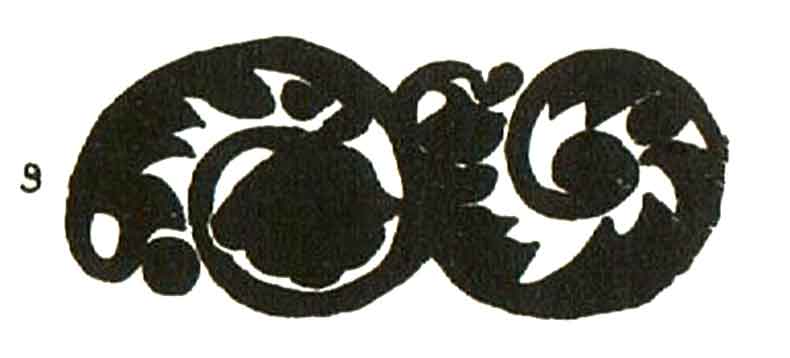 |
|
|
|
The ornament is either drawn with scored lines or by imitating a semi-relief technique by retaining the shiny surfaces as a pattern, very often bordered by a straight line, while hatching the ground with fine scored lines and filling it in with black. This creates a similar effect as chip carving, which is also the most popular technique for metal jewelry, especially in the Scythian world, where this animal style was produced. In contrast, the small decorative silver plates used like beads are really manufactured in semi-reliefs. The ornament was obviously stamped in. Smaller geometrical motifs were stamped on thinner metal plates. In addition, enamel was sometimes inserted into grooves that had previously been scored. The few enamel works that were found clearly indicate a Chinese influence. The material for enamel jewelry was tin beads and used shell casings, and it was brought in by the Russians. Wood and metal processing share very few common motifs. The complex patterns and the skill of its production culminated in stitchery, where flower motifs were made. The main motifs in processing metal were blossom, tendril and leaf motifs.
The art of smithery was handed down within families. As with the shamans, a differentiation was made between a blacksmith and a whitesmith. The smith was equally well respected in the eyes of the tribe members as the shaman because he too was equipped with magical powers over spirits. This power was based on the assumption that the spirits were afraid of metals. This explains rituals like that of removing all metal jewelry from the clothes of the dead. Fire must not be raked with an iron rod, or else its possessing spirit would be insulted. Evil spirits can be ousted by the sound of iron. Thus, the smith’s power was to restrain and release magical power. That way, his sphere encroached upon that of the shaman, which increased his position within the community. Smiths and shamans had a common patron: “Kytaj-Baxsy-Tojyn”. When he got irate about the smith, a red cow had to be offered to him. Also, the black shaman was offered a cow when he received the shaman garment at the beginning of his career. The female shaman “Makyny-Kysa-Tyny-Raxtax” received the same animal as a means of appeasement. Thus, cows were offered only to chthonic spirits (spirits of the earth). According to a Yakut saying, “shamans and smiths are from the same nest”.
Turkic smiths were already considered particularly skilled in early times, as reported by sources from the Tang period. Outstanding groups of smiths are said to have lived in the Altai of the 6th through 8th centuries AD, and the Yenisei-based Kyrgyz people of the 8th century AD are said to have been great masters of smithery. Jewelry was cast in silver before being adapted and subsequently engraved. At the Altai, this technique is very old, as demonstrated by finds of precious metal in kurgans from the Pazyryk time, probably from the 6th through 2nd centuries BC. |
The geometric ornaments
|
| Patterns that do not consist of spiral or plant ornaments will be referred to as geometric ornaments herein. No other ethnic group has as many motifs as the Yakuts, namely about 144, which are divided into ten different basic motifs. Figurative representation is unknown to the Yakuts, with the exeption of shaman jewelry. |
Basic motifs
|
| Lines and strokes: For the purpose of convenience we will make a distinction: Strokes are short strokes that are frequently repeated within a pattern, while lines continue for a long distance. A double line is found as a stand-alone ornament. |
The crest ornament: These plain ornaments are widely common even outside the Yakut world, for example, with the Paleosiberian peoples, the Buryats and the Tungusic people. Even the Chinese use this pattern on their metal mirrors. In the Baikal region such motifs were found dating to the 1st millennium AD.
| The Yakuts are known to call these patterns “crest ornaments”, “tarax”, “oju” and “rydh”. (Panel I, fig. 1 through 4 on kumys containters, carved in wood). This crest had been used in China and Europe in association with female fertility, as is the case with the cowry and the triangle. In India, there are links to the fertility goddess called “Yoni”, who carries a crest as a symbol originating in the times of the Arian immigration. “Rydh” is also found in previous ethnic customs: “The crest is put underneath the butter cup to shield the evil eye.” Typically, symbols of fertility like this one have developed into signs of defensive charms, such as talismans or the phalluses put on children in Italy or Spain. It is striking how many rules and customs relating to pregnancy and birth found in the old world are associated with crests. There is no doubt that the crest was viewed as a symbol of fertility. |
|
 |
|
|
|
The spring feast was celebrated in order to increase the fertility in the year to come. In contrast, at the autumn feast offerings were made to gain protection against the evil spirits.
| A different version of this pattern, the “spine ornament”, also known as “nail ridge”, “tynyraxtax torduja”, was found mainly on pottery but is not directly related to the crest ornament (panel I, fig. 8, kumys container, wood). |
 |
|
|
The chessboard: another ornament found mainly on kumys containers (panel I, fig. 11, carved in wood, and 12, wood, chip carving).. |
 |
|
|
The rope sign: The strokes can run angular to the borderlines, they were used for all techniques. The sign was called “ärijä oju”, meaning: “wound ornament” (panel I, 13, on a kumys container, wood, chip carving). |
  |
|
|
|
Fir-tree ornament: A very common version is the parallel run of two rope signs. It appears as early as in finds from Noin Ula and at the Yenisei, as well as in Kyrgyz finds from the 6th through 8th centuries AD (panel I, fig. 16 on a kumys container, wood, chip carving). |
 |
|
|
|
| It also appeared associated with the Voguls, who called it “saune kur”, which translates as “magpie leg”. This pattern did not appear on kumys containers, only on silver manufacturing. |
| Crosses: Though the erect cross often appears in connection with other motifs, it is hardly found as an individual motif as part of a serial ornament. In contrast, it is one of the oldest motifs of the Buryats. St. Andrew’s crosses are often found on kumys containers, compiled to one row; “ilim xaraha”, the net ornament (panel I, fig. 21, wood, chip carving). A spot at each center between two crosses was a means of depicting a fish (panel I, fig. 22, wood, chip carving). When the St. Andrew’s crosses are doubled in number and placed very close to one another, thus effectively overlapping, this pattern is obtained, just like in herringbone and satin stitchings (panel I, fig. 23, scored into wood). |
|
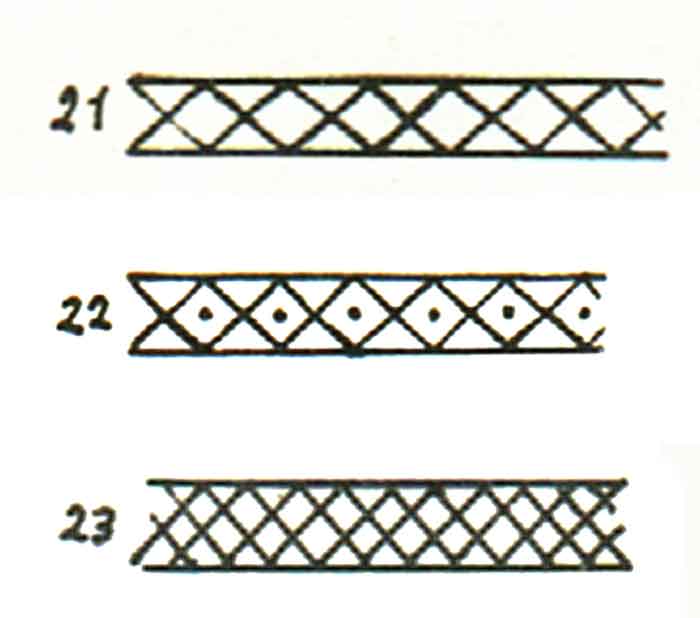 |
| . |
|
|
|
| The ornamental cross motifs have no connection whatsoever to the Christian cross. |
|
Zigzag and triangles: This is probably one of the most popular geometric serial ornaments. It is called “uasa oju” and depicts the large, conical Yakut summer tents on a kumys container. Another name they use for it is “biä miä oju”: mares’ teat pattern. Depictions of breasts are a globally common symbol of fertility and thriving. The Kets (Ostyaks) have yet a different name for this motif: “shadow of the yurt”.
(Panel I, 25 through 35) zigzag lines: ornaments continung perpendicularly in disrupted sequence (fig. 27, kumys container, wood) in the form of overlapping angles (figs. 28 and 29, pot, modelled clay).
The basis of the zigzag patterns were triangles whose bases alternately rest on the top and bottom band lines. A nail ornament (fig. 30, kumys container, wood, chip carving, and 31, can, scored into wood) represents fingernails. Normally such patterns are the result of a potter pressing her fingernails into the soft clay.
“Kärdis oju”, carved ornament (fig. 33, kumys container, wood, chip carving): Its appearance is similar to that of dents made in branches as memory aids.
|
|

zigzag lines
|
| The Buryats had similar shapes. |
|
| In braiding or simple lacing works, however, the technological bondage of the zigzag pattern is clearly visible (panel I, fig. 38, kumys container, wood, chip carving). |
|
The zigzag ornament is one of the most common ornaments on kumys containers, not only for the Yakuts. It is just as common for the Paleosiberian peoples, the Buryats and other peoples of Southern Siberia. The Chukchi people see rivers in them, while the Chinese are known to draw mountains as zigzag lines. In pre-historic finds, the pattern of a triangle appears on ceramics from as early as the 3rd to 2nd millennia BC, and it also occurs in more recent finds, such as from the Pazyryk culture at the Altai and on ceramics of the Tagar culture.
|
| The triangle is the only motif used in a serial ornament by simply putting several triangles in a row. (Panel I, fig. 36, chest jewelry, silver, engraved). The same was done by the Buryats, the Tungusic people, the Samoyedic people, the Kets (Ostyaks) and the Voguls. Sometimes a line of triangles suspended from the top edge of the pattern is placed opposite another line based on the bottom edge, with their tips almost touching (panel I, fig. 40, cup, bone, scored). |
|
|
A striking thing when comparing ceramic burial objects of early European and Chinese periods is that they were decorated with rows of triangles which resembled the Yakut pattern. As each death is associated with a rebirth, these triangles are related to the fertility symbol that represented womanhood. The Buryats are also familiar with this. These hobo signs indicate how many women live in a house. Similar examples are known from the Balkan and the Middle East, but these semantics were already known to the ancient Egyptians. It is striking that this motif very often appears together with the crest, which is also a symbol of fertility. This is also shown by examples from Indonesia, where the crest is decorated with triangular pattens in order to prevent disease. In India and China as well as in the Middle East, the triangle is a sign of womanhood. These patterns influenced Siberian peoples like the Yakuts. Among the Chuvashes, a Turkic people, graveposts were found that had such a triangle on it if a woman was buried beneath it. The other indentations represented their clothing. However, no one ever actually wore such triangles or zigzag patterns on their clothes.
An original meaning of these motifs cannot be interpreted with absolute certainty for the nomad peoples in Siberia, even though kumys containers produced for the spring feasts were decorated with such motifs. Other motifs were used, too, but they originated in the Chinese area and exhibited some similarities with those of the Indonesian population.
Triangle patterns decorated the pre-historical finds of Siberia at a very early time. In the closer and wider environment of today’s Yakutia, finds included applications among the finds from the Pazyryk culture at Altai and in the area around the southern end of Lake Baikal on ceramic products from the first centuries AD. Further west, in the Yenisei area at the time around the Nativity, these ornaments appeared on wood and clay.
| Squares, rhombi and rectangles: A square or rhombus can originate from a triangle pattern (panel I, fig. 42, saddlecloth, cloth mosaic). |
|
The use of squares or rectangles resting at one side is virtually limited to the chessboard pattern (panel I, fig. 48, knife handle, horn, immersed, 49, sewing box, wood, scored, and 50, carpet, fur mosaic). Patterns of this kind were found among all the neighboring peoples as well.
|
|
Two potter marks:
(Panel I, fig. 52, pot, stamped, and 53, potter mark, scored into wood).
|
|
|
| Arches: The arch form can have various shapes. It can be flatter or more arched, or the baseline for the ornament in pottery and beadwork can be omitted (panel I, fig. 59, kumys container, wood, chip carving). |
|
| The simplest version of this ornament is a doubling of the arch, where the two lines at the beginning and at the end either touch every single motif or run entirely separately (panel I, fig. 57, back jewelry, silver, engraved, and 58, sword, iron, engraved). |
|
Yet another variant is created by adding arches in certain distances to top and bottom edge lines in a way that every single arch protrudes into the space between two of the other sides (panel I, fig. 59 or 63, kumys containers, wood, chip carving). .
|

|
Circles and spots: Small circles like beads on a string border these patterns on silver. A row of circles was another popular mark ornament on pottery, named “türgüruk oju”, the “circular ornament” (panel I, fig. 64, pot, clay, stamped, and 65, decorative plate, silver, engraved). A difference between a circular pattern and a spot is that in the case of a spot the entire round area is impressed, not only the outer line. This is a pattern called “kövüör oju”, “kumys leather bag ornament” (panel I, fig. 66, kumys container, wood).
Yet another pattern (panel I, fig. 67, chest jewelry, silver, engraved) of several inscribed circles with a spot in their center. It was used by the Buryats and the Tungusic people as well. The same ornament is found with the Kets. For the Chukchi people, circles represented stars, while the sun was depicted by a much larger number of inscribed circles. On Buryat drawings, the sun is depicted in the form of 8 or 9 inscripted circles. To the Kyrgyz, a round disk means “new moon”. As explained by descriptions from China, these circles with a spot represented the “Eye of the Sun”. |
|
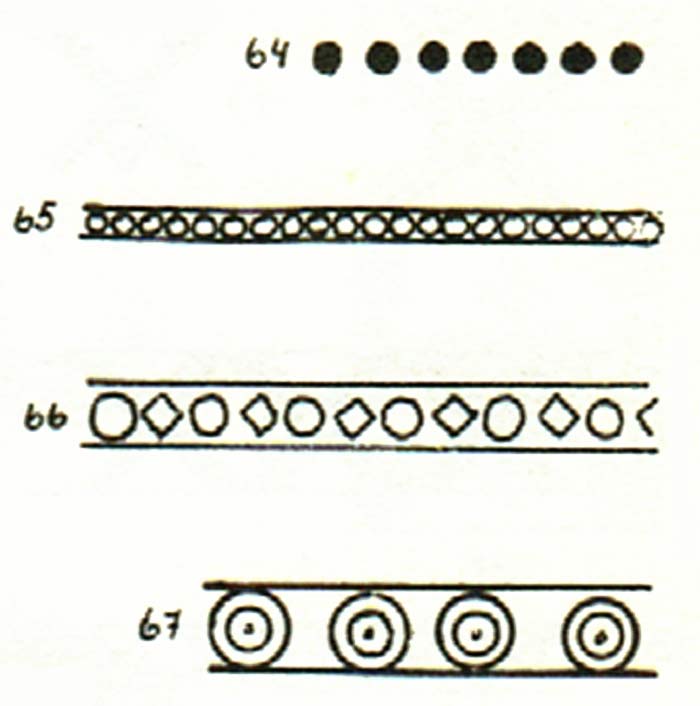
|
The Yakuts depicted the sun on the dresses of black shamans in the form a disk that had a small hole in its center. However, this symbol resembles the image of the Earth on the same costume. On ornaments whose meaning is known the sun ist symbolized in a different form, as will be explained below.
|
- Find more information on depictions of the Sun below in „Sun-sign Representations“
|
The Yakuts are comprised of two immigrated tribes, one of which arrived approx. 1000 years ago, while the other had already been resident for some time. Thus, it is perfectly plausible that the Yakuts, just like the Buryats, had two different types of sun representations. Sometimes they drew the sun as a curled shape, like the Altaians, the Kyrgyz and other Southern Siberian peoples do, and sometimes they expressed it by two or more concentric circles. For example, the round and shiny decorative disks women wore on their hats or above their coats that were decorated with concentric circles or concentrically designed patterned stripes were referred to as “the sun”. This is why, whenever women perform ceremonies men are not allowed to watch, they turn their hats around so that the disk looks rearwards, because the Yakuts imagine the sun to be male. These disks are also found riveted onto kumys containers. This form of depicting the sun was also common with the Chukchi people, the Koryaks and – judging from their shamans’ jewelry – the Yukaghirs.
A few motifs of this group are classified as rare basic motifs which are only rarely combined with others..
|
| The relief ornament: This ornament resembles the pinnacles of a tower. It is found exclusively on kumys containers, and the Yakuts call it relief ornament, or “tomtoryo oju” (panel I, fig. 68, wood, chip carving).. |
|

|
| The wedge motif: In this case a motif is simply wedged between two edges. Its appearance resembles a wedge for cleaving wood and is referred to as “kybyta oju” (wedge ornament) (panel I, fig. 69, kumys container, wood, chip carving). |
|

|
| The finger ornament: The pattern consists of hexagonal cells, which are arranged like honeycomb in a hive. Its name is “tarbax oju”, finger ornament (panel II, fig. 1, kumys container, wood, and 2, bead, tin, engraved). |
|
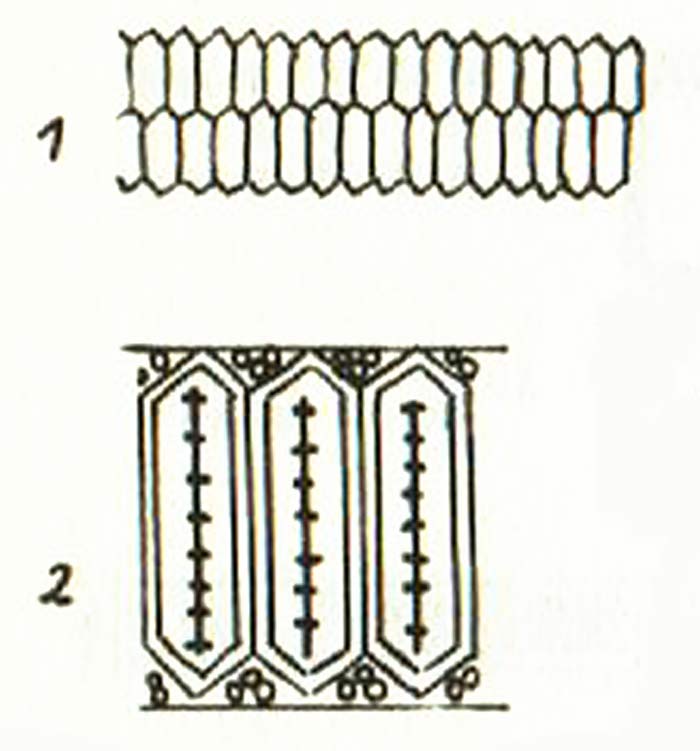
|
Silver stamp and pottery stamp: One of the stamps for silver ornaments has a near-triangular shape, with the exception that the base is not linear but has jags. A circular line is impinged in order to border an adjacent ornament, or it is impressed in a straight line. This pattern often alternates between the tip indicating upwards and downwards. Very often, a spot is omitted in the center of the triangle (panel II, fig. 7, shoe on male belt, silver, stamped, 8, decorative plate, silver, engraved, 9, shoe on horse halter, brass, stamped, 10, scoop for kumys, wood, chip carving, and 11, decorative plate, bronze, stamped).
|
|

|
Ornaments of this group were stamped on pottery. A two-jagged cane is used to impress them mostly into the coils of the pots. This motif is aptly called “bytasyt zamyta”, “the mouse walked” (panel II, fig. 3, pot, clay, stamped). Other ornaments also resemble trails of animals (panel II, figs. 4 and 5, potter mark, wood, carved).
|
|

|
|
The most common combinations in motifs are:
|
Cross figures: A minor change in the cross ornament is performed (panel II, fig. 14, tobacco box, scored into wood). These St. Andrew’s cross ornaments are identical to those of the Kets and the Buryats and serial ornaments very often shown on kumys containers (panel II, fig. 15, wood, chip carving).
A kumys container (panel II, 16, scored into wood) has interesting parallels to a Hunnic caldron found in Hungary. On this caldron, St. Andrew’s crosses and crest ornaments alternate. |
|
|
Among the Yakut ornaments, the plain cross in connection with circles or squares was very popular. These motifs occur on almost all kinds of everyday objects but not on silver.
Both triangles and squares are arranged around a St. Andrew’s cross that cannot be seen in the pattern as such because it is left out between the squares and the triangles. Patterns of this kind were stamped onto pottery. When the potter stamps are impressed the circular line is almost indiscernible, and the base of the original pattern becomes an ornament again.
| Four of these triangles appear on ceramics with a round base (panel II, fig. 24, kumys container, scored into wood). They are called “bultavir torduja”, “rounded ridge". |
|
|
Very often the pattern itself is depicted, as is the case on small, non-ornamented, square decorative plates, which are overstitched crosswise with two stitches, on bilayered works, were this form is cut out and stitched onto a base with a different color, or on wood works.
The cross patterns are particularly common. They are among the few ornaments which are found equally on kumys containers and objects manufactered at home. The principle was familiar to the Yakuts, so it was already applied in plainer forms (panel II, fig. 26, potter mark, scored into wood; 27, pot, clay, stamped, and 28, can, birch bark, bilayered work).
|
|
|
There is a motif where four squares are put together to form a single square (panel II, fig. 21, shaman’s jewelry of a black shaman, iron, engraved).
|
|
|
On bilayered works, very often the cross and the four squares between the arms of the cross are depicted (panel II, fig. 31, box, birch bark, bilayered work).
|
|
|
This pattern was found in Troya, for example, where it imitated female shapes. Instead of the genital, a swastika (an ancient Indian pattern, symbolizing the revolving sun) is applied on one of the urns, and a cross with four spots on another one (figs. 12 snd 13). On yet another square the swastika is found on a female shape from Romania (fig. 14).
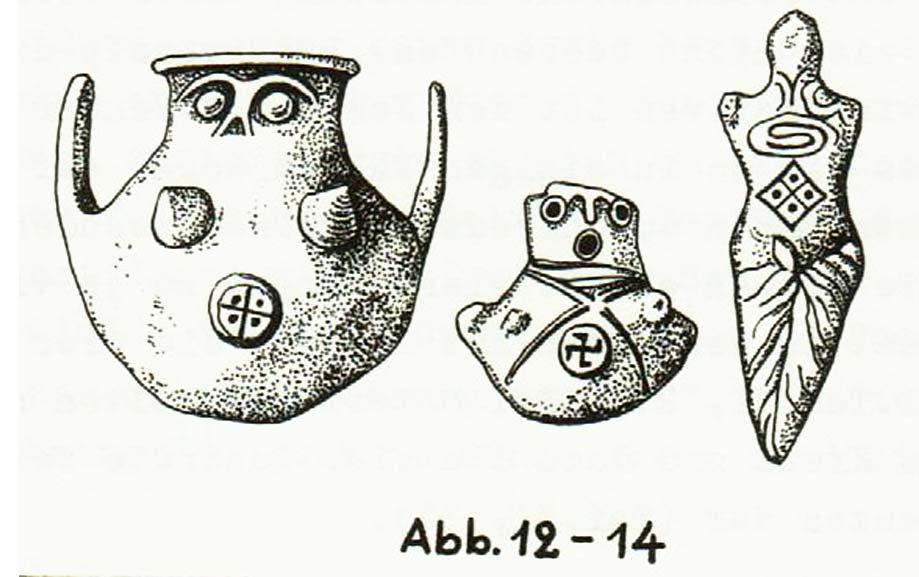
|
- Sun-sign Representations -
In Greece, the genital is also replaced by the swastika, a symbol of the sun. Wherever it occurs, it symbolizes the revolution of the sun and consequently, fertility and happiness.
The meaning of the motif discussed herein has to be similar. The patterns on a shaman drum on which it decorates the edge between zigzag lines and depictions of stars (fig. 15) demonstrate that a certain meaning of this ornament for the Altai Turks, whose material culture and religion were similar to those of the Yakuts in many respects, was preserved until the previous century, at least as far as their belief in a sacred being is concerned.
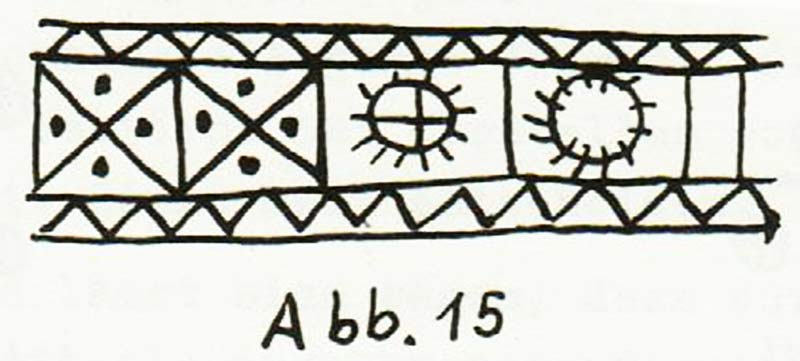
| This pattern is not very common in Yakut finds, appearing only on one can for wax candles (panel II, fig. 30, can, scored and carved into wood). Also, a ram-horn ornament was scored into the cap of the can, which must have had a cosmological meaning initially, and which was derived from China. The Buryats are familiar with this ornament, too, as revealed by finds from the upper Lena area. This shape is very old, as it was found belonging to the Pazyryk culture at the Altai. |
|
|
| Like with many other motifs, parallels to Chinese signs can be found here. The cross with the four spots appears on early Chinese ceramics, as does the crossed circle. A square crossed on half of its side represents the Chinese sign for “field”. The crossed circle is another very old sign. Repeated four times, it means thunder (fig. 16). It was considered a good sign because thunder usually appears after rain. |
|
|
The sign is also associated with the zigzag of thunder (fig. 17). The resulting sign, however, is considered a sun wheel, which is also known to be associated with the crossed circle. These motifs are found in Indonesia as well. It is therefore not unusual for the shamans in North Asia to depict the sun as a wheel.
|
|
|
As well, as do the Kets (fig. 18 – the sun on the left, the moon on the right, and the shape of the shaman and two assistants at the centre on the back of a shaman dress), the Ostyaks (fig. 19 – sun circle) or the Buryats (fig. 20 – representation of the moon on the left, the milky way in the middle and the sun on the right), where it crosses multiple concentric circles. The Altaians draw the stars the same way, sometimes but not always adding a halo around the motif (as previously in figs. 15, see above and 21 bottom right – representation of the sun, venus, the moon and other stars).
On Yakut drawings the crossed circle is also the symbol of a shaman drum.
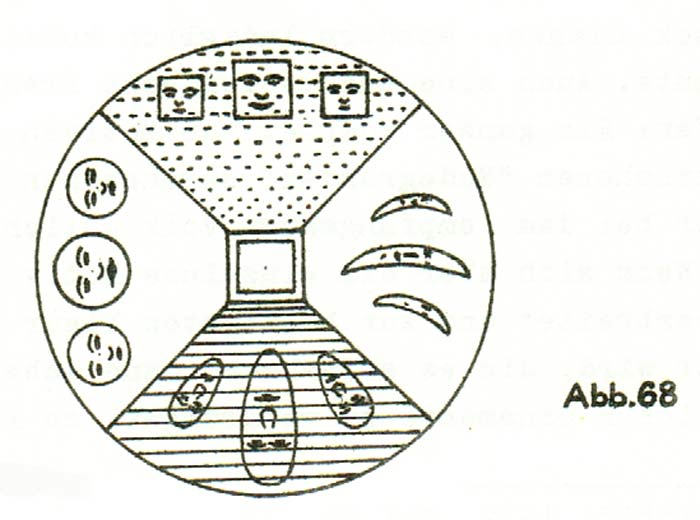
shaman drum
|
|
Probably this sign is used for the drum because the drumheads of round drums in North Asia and Lapland almost always have a cross drawn on them, representing the shaman’s journey. (Fig. 68 – cosmos on a drum of the Kalmyks). This cross is found throughout the drum. It shows a division into four directions and 12 different spots (the months). The Mongolian world view was influenced by Buddhism to a large extent. For them, the center of the world is the world-mountain surrounded by four continents. In summary it can be said that on drawings in the Altai the stars were often shown as crossed shapes. In North Asia the sun was sometimes also represented by circles or crosses. While the circular line can be derived from the visual idea people had of the stars, the cross goes on to express the revolution of the sun. This shape is common in all of Asia with a varying number of circles (as in fig. 21, see above). |
|
Another ornamental type of sun representation existing among the nomadic peoples of South Siberia, such as the Altaians, the Kyrgyz, the Buryats and the Yakuts, is shown in figs. 42 through 46. The beams of the sun begin to rotate, thus assuming a swastika shape. These revolving shapes are called the “sun” by the Altaians, the Kyrgyz and the Buryats. On a Yakut chest this ornament appears at the same position as on Buryat chests (panel II, fig. 45 and 46, wood, carved – 42 through 44, on a can, scored into wood). It can thus be imagined that the Yakuts and the Buryats associated the same idea with that ornament. In this context it cannot be decided for sure, whether it was adopted from Persia, where it symbolizes the sun, or maybe from China or Tibet.
|
|
|
The center of this motif usually features a circle with a spot in it in Yakut or Kyrgyz terms, which, as mentioned previously, is an ornamental expression the Buryats and some Paleosiberian peoples have for the sun.
The Buryats themselves usually draw a crossed circle in the center of this swastika symbol (a sun sign). The Altai peoples used, as a central motif, one or more spots, the cross with four spots (in this case surrounded by a circular line) or a crossed circle, which was probably used as a swastika sign as well having the ancient Indian meaning of the sun.
Cross signs or circles with a spot symbolize cosmic phenomena for the Altai peoples and the Kyrgyz, who are both related to the Yakuts, but also for the Buryats and other ethnic groups in Asia.
| At the center of the revolving sun symbol as a stamped ornament but also as a singular motif on silver and wood we encounter the crossed circle on which the base of the ornament is specially emphasized by four spherical triangles. This means that we see not only the pattern, which is created by a mark incised in the form of a crossed circle on pottery but also the pattern of the mark itself (panel II, figs. 40 through 42, cans, scored into wood). |
|

(40-42) sun symbols
|
This motif (fig. 40) corresponds to the Buddhist “pearl of enlightenment”. Buddhists are wearing on their foreheads or chests, like on the wall paintings in Khocho (Turfan), for example, where it already appears as a textile pattern. This motif is found in the art of non-Buddhist Asian peoples as well. As an example let there be named a magic pendand of the Ossetes (fig. 22).
This motif can be traced back to very early periods in Siberia. The ceramics of the Andronovo period (1700 to 1200 BC – Bronze Age) showed it in the Altai already. This is why it has not been determined, whether it is actually a Buddhist motif or a special form of the crossed circle. |
|
|
| Doubtless the cross made of five squares (panel II, fig. 32, decorative plate, silver, engraved) is also part of the group of the old cross motifs, as it appears in the Ostyak sun circle (see above in fig. 19). The Ugrics have been using this motif since the Bronze Age (1700 through 1200 BC). As a decorative motif it is found belonging to the Samoyedic people, the Nenets, the Kets, the Altaians, Tungusic tribes, Buryats and Kyrgyz. |
|

cross motif
|
Ornaments on decorative leaflets represent ancient Siberian culture (figs. 35 and 36, decorative leaflet, silver, stamped). In a similar shape they are found in the Yenisei area and the Sarmatian territory east of the Black Sea. Here in the Altai they were used up to the 5th through 8th centuries AD.
|
|

decorative leaflets
|
| Among contemporary Siberian peoples the Ostyaks are the last ones to produce patterns like this the same way the Yakuts did (panel II, fig. 26, potter mark, wood, carved). |
|

four crosses
|
| In the Ordos area the stitched decorative plates looked different during the period of the Han dynasty. Their pattern was a fox’s head with two rosettas. The decorative plate (panel II, fig. 38, silver, stamped), in which the smith stamped two nooks and a spot, resemble this kind of stylization. |
|

fox's head
|
A very common serial ornament consists of the base of a cross pattern in the form of four squares and alternately a crossed circle with a size nine times as large (panel II, fig. 49, can, scored into wood).
|
|

squares
|
Another variant is “timäx tördö oju”, the button base ornament (panel II, figs. 47 and 48, kumys container, scored into wood). The motif, consisting of inscribed rhombi, has been stitched as a base onto the coats in order to avoid the buttons being torn off too easily.
The singular square standing on its tip, sometimes contorted to form a rhomb, seems to be used as a sign of hallowness or blessing on ancient Chinese bronzes of the Chow culture between the beaks of animal heads. It is often replaced by two inscribed rhombi. This is just the same shape the inhabitants of Celebes (now known as the Indonesian island of Sulawesi) still use today to decorate their carved buffalo heads. The rhomb motif is not only present in Eastern Asia but also in the Middle East and in Southern Siberia.
|
|

(47+48) avoid the buttons
|
The crest pattern is also often associated with various cross ornaments (panel II, fig. 51, saddlecloth, cloth mosaic). For example, on a wooden container (panel II, fig. 53, tin, scored into wood), plain squares were connected by the crest pattern (panel II, fig. 52, cup, wood, carved), and a zigzag pattern was added as a third element..
|
|
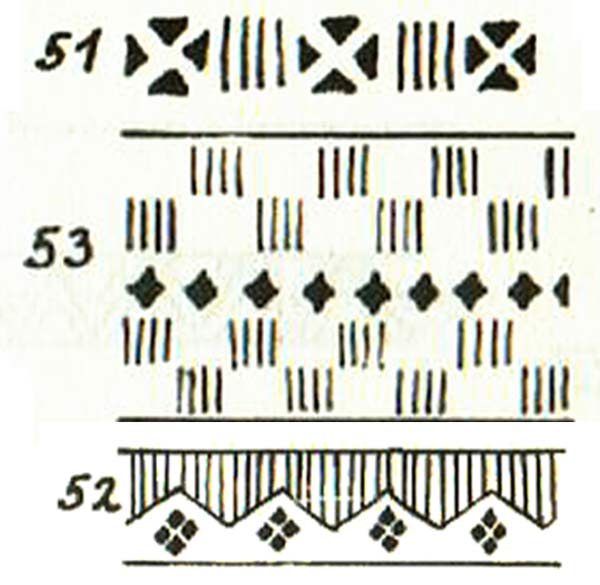
cross-crest pattern
|
|
The sky ornament:
One of the most common ornaments in wood is the linking part of double arches connecting and potentially touching each other. It is called “sarbynnax oju”, “suspended ornament”. The pattern is always the same, consisting of an arch and a cross figure (panel II, fig. 54, box, scored into wood, and 55 through 58, kumys container, scored into wood).
This sky ornaments occurs as an imitation of the round dome. The shapes derived from the cross, which, as mentioned above, represent stars, confirm that these shapes probably had an astronomic meaning.
|
|
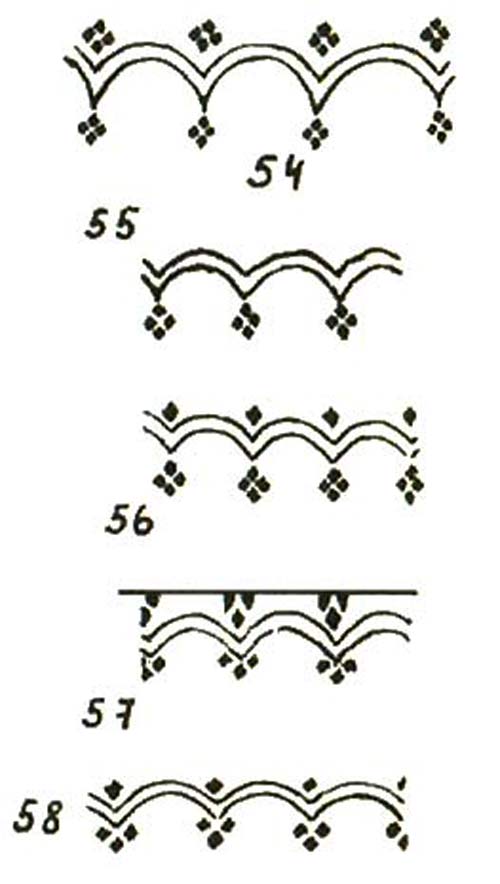
sky ornaments
|
In a few cases not only the base but the pattern itself, the cross, connects to the arch line (panel III, fig. 12, wall hnging, bark piece, stitched, and 14, tin, scored into wood).
|
|

(12+14) wall hanging and tin
|
Another work on silver has two circles scored into the round shapes (panel III, fig. 1, braid ornament, engraved).
In many cases the group of four squares is replaced by a single square, which is placed on the top side directly within the gussets of the arches but seems to be suspended on a rope or hanging on a string on the bottom side (panel III, figs. 2, 5, kumys container, scored into wood, and 3, kumys container, wood, chip carving).
|
|
|
When an outline is drawn around this ornament, this creates one of the characteristic ornaments of the Tungusic people (fig. 23).
|
|
|
| The Yakuts themselves liked to decorate many objects of their personal belongings or clothes with this ornament (panel III, fig. 6, kumys container, wood, chip carving, and 7, coat with silver plates stitched on it). |
|

sky ornament
|
Judging from the material at hand, which was probably collected earlier, the ornament is in some way associated with the Tungusic people. We have reason to believe that this ornament was common among the Tungusic and Yakut peoples, or, more specifically, among their ancestors, who lived in the Lena area around the Nativity. The Yakuts changed the ornament multiple times; no other Northern Siberian people was more enthusiastic about variation than they were.
The variant from which it is easiest to discern the basic shape, is a plain arch element with a single square (panel III, figs. 3 and 4, kumys container, wood, chip carving).
|
|
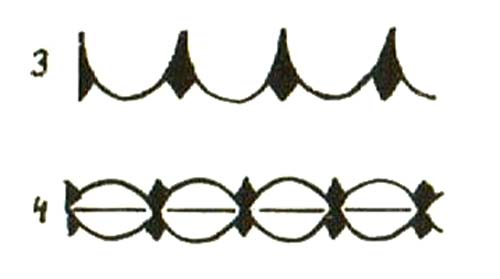
sky ornament
|
|
Things are somewhat more complicated when it comes to the pattern (panel III, fig. 8, kumys container, wood, chip carving, and 9, cup, wood, chip carving).
|
|

sky ornament
|
A form of the sky ornament that was common among the Tungusic people has been duplicated here, as shown in figure 24.
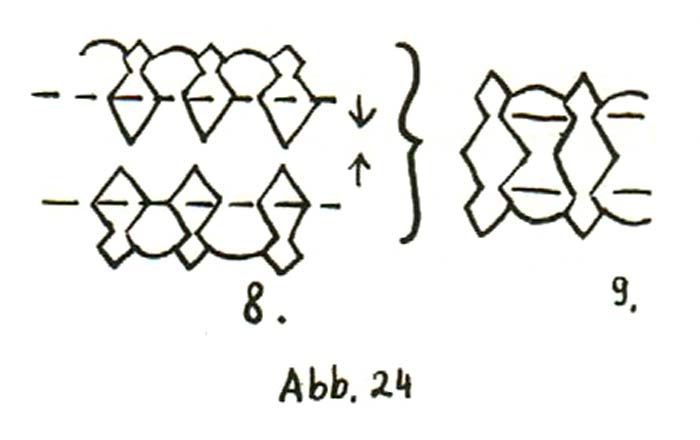
Apart from the Tungusics, there is only one more parallel to the Yakut sky ornaments (panel III, fig. 12, wall hanging, bark piece, stitched). It was found on an urn from the Sille period in North Korea (57 BC to 935 AD), which is approximately the same area that is also regarded the original home of the Tungusic people.
|
|
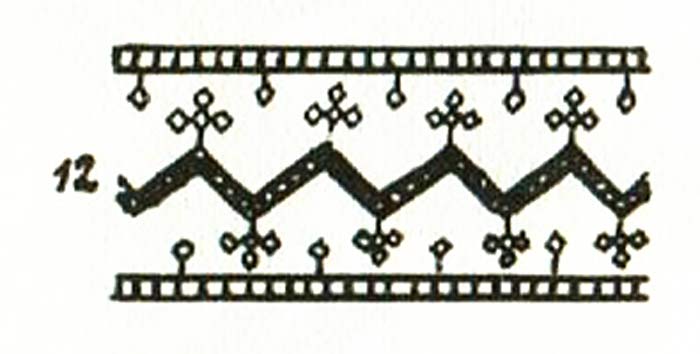
wall hanging
|
The Yakuts received many inspirations from China, especially from the north. Among these are rams’ beaks, which are proven to be mediated by the Tungusics. Unfortunately, it is not always possible to find out the exact place of origin or acquisition. However, motifs similar to the Yakut sky ornament are very common in Asia.
In fact, jag patterns are a popular lace among the Buryats. They are applied on the inside of a yurt where the vertical rods reach those of the roof. The Yakuts always use the zigzag or the arch with crosses, i.e. some kind of sky pattern (panel III, fig. 5, kumys container, scored into wood, and 12), on old wall hangings from birch bark, which used to be suspended inside tents of that time.

borte
|
|
Small round silver disks (left side), each having a rosetta with eight leaves in their center attached to short bead strings in the center of each arch, representing the sun, demonstrate how vividly the Yakuts imagined the sky.
The patterns described above can be summarized as one group. Their basic shape is the cross. The Yakuts are by far not the only people who use these ornaments. The Ostyaks at the Yugan use exactly the same stamp made of reindeer horn to press patterns onto the soft birch bark or onto tins.
|
Squares with an inscribed cross represent stars. Crossed circles on the other hand are often considered to be representations of the shaman drum. As we know, the crossed circle is a symbol of the sun almost everywhere, and has been for a long time, just like the crest and the triangle ornaments. It was already there in times when the use of metals was not yet known to these ethnic groups. Many peoples of today still depict the sun and the stars the same way. Crosses are still found with a double arch line, these are “sky ornaments” with the crosses representing the stars in the sky.
The ornament made up by a group of four triangles is even more common. Among the Finno-Ugric peoples it is the Komi people and the Udmurts, and in the European part the Russians who call this motif their own. In Siberia it belongs to the jewelry of the Samoyedic, the Yurak, the Ket, the Yenisei-based Tungusic, the Dolgan, the Tuvan, the Shor, the Altaian, the Kyrgyz, the Karakyrgyz (Mountain Kasakh) and the Mountain Tadjik peoples, and it is found even with the Mongolian Buryats). .
|
The Geometric Surface Ornaments
|
As for their set of motifs, the geometric surface ornaments are no different from the serial ornaments. Also the borderline between surface and serial composition cannot be determined for sure because a surface very often is covered with serial ornaments (panel III, fig. 17, carpet, fur mosaic). The geometric surface ornaments, however, are fairly rare. Only a single ornament (panel III, fig. 13, saddlecloth, textile mosaic) has a surface character, being cut off entirely by the delimitation of the surface and not having an organic ending. Works like this were found at the Yenisei, originating in the 3rd century BC, and in the Altai area, dated to the 2nd century AD.
Their outlines are accompanied by a variant of the sky ornament (panel III, fig. 5, as on kumys containers, scored into wood). The execution of the squares seems to be not particularly thorough. The shape of the following ornament (panel III, fig. 7, like on coats, having silver plates stitched on) is located on the left short side. The sky ornament is emphasized by two of the figures cut out in rhomb-like shapes bearing four spots, which are derived from cross motifs.
The ornaments on one chest (fig. 15) are completely out of the ordinary.
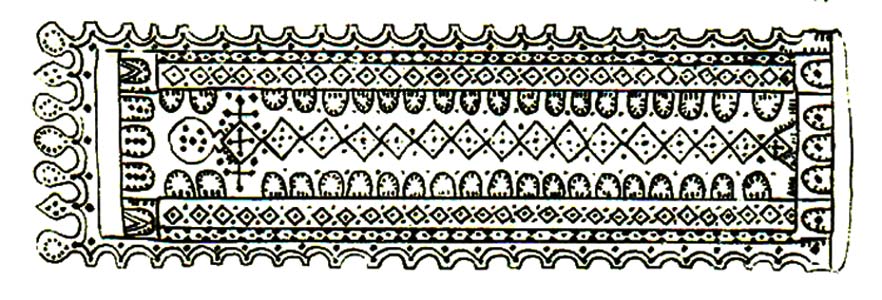
This decoration seems alien among the remaining Yakut patterns. Maybe it is a calendrical representation, as its central part shows 15 squares (15 being half the number of days of one month), supplemented by the circular “head” and the largest of the squares. The number 15 is very important for the Yakut calendar because the Yakuts break their months into a dark and a light half. The second half, which is considered dark or “old”, was numbered backwards (i.e. the 15th, 14th, 13th day, etc.). In this but also in other details, the Yakut calculation of times bears resemblance to that of the Indians, the Persians and the Tibetans. The seven carved figures on the left short side represent the weekdays.
With the exception of a few metal works, the material for geometric ornaments is always wood, clay, cloth or fur. Smiths had their own patterns. It is virtually impossible to identify the exact origin of these plain geometric motifs. Triangles, zigzags, arches, squares, etc. occur among all neighbouring groups, and they belong to the ornamental art of various peoples.
Many of these motifs appear in finds of very early periods of Siberian history (2000 until 3000 BC).
|
The Spiral and Plant Ornaments
This type of decoration is found less frequently in connection with Paleosiberian, Tungusic, Samoyedic or Ugric tribes.
Among the Paleosiberian tribes the Amur peoples, i.e. the Gilyaks and the Ainu, and among the Tungusic tribes the Golds, the Orok and the Oroch people constitute an exception in using the spiral to a great extent. These patterns, however, are clearly different from the Yakut ones, in that they are never intertwined but each part is fully visible, though of course, two spirals may touch. In these drawings (the plant ornaments) it is easy to identify Mongolian, Russian, or even Chinese influence, and also a relation to the Kyrgyz or other Turkic peoples of Southern Siberia. In particular, many Russian tendril and baroque ornaments were adopted. The Yakuts were the masters of spreading imitations. In contrast, the Amur peoples presented their spiral ornaments as woven ribbons, in which individual ribbons are intertwined. These motifs, again, are entirely different from those of the Yakuts. Various transformations of the animal head, the so called Taotie (fig. 109, bottom) of a fish or a bird do not exist as such on Yakut objects. So, no closer relation is to be discovered between the two areas where spiral ornaments used to appear.
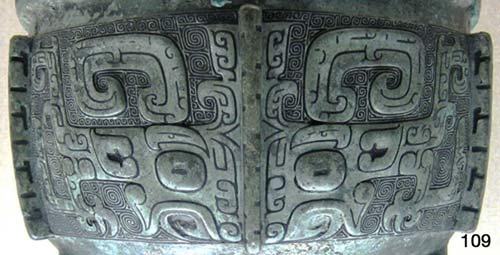
Taotie
|
The spiral: The simple unbonded spiral is very rare among the Yakuts. On one pair of tweezers and one decorative disk (panel III, fig. 18, silver, engraved; 20 and 21, tweezers, silver, engraved) the spirals are arranged in a horizontal or vertical line, each completely detached from the other, while on a different decorative disk (panel III, fig. 24, shoe on male belt, silver), the spirals touch to form a serial ornament.
The spiral is a popular motif on saddlecloths. Each spiral has a different color (panel VI, figs. 4, 8 and 10, cloth, embroidery, 6 and 13, cloth, stitched, and 14, leather, stitched)..
|
A double curl on both ends of a line is much more common than these plain spirals (panel III, figs. 25, 37, on a belt buckle, silver, semi-relief, and 39, probably depiction of a cow, carved). They extend either in two different directions, forming the so called S-shaped spiral, or both in the same direction (panel III, fig. 26, shoe on harness, silver, engraved). |
|
spirals
|
| In most cases, the S-shaped spirals are located not individually between the other motifs but combined to form rows together (panel III, fig. 28, lancet, iron, engraved, 29 through 31, decorative plate, silver, engraved, 32, box, scored, and 33). |
|
|
The members of a silver chain are sometimes forged the same way (panel III, fig. 38, glove, leather, stitched, panel X, 23 and 24, box, scored into wood).
This motif is found on both wood and metal works.
|
|

spirals

spirals
|
|
The tendrils:
A good example of tendril and spiral is this pattern on a wooden box (panel III, fig. 35, box, scored into wood).
tendril 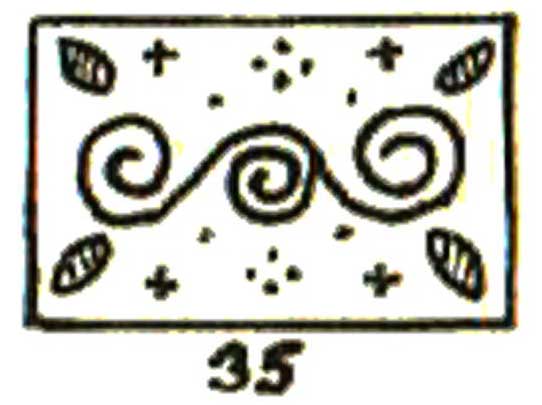
The intermittent curling tendril (figs. 3 through 7) is composed of S-shaped spirals.
In the art of Greece and the Middle East, the term “curling tendril” has been established in various languages. One differentiates between a simple and an “intermittent” curling tendril, which is also relevant for the Yakut ornaments (panel IV, figs. 3 through 6, box, scored into wood, and 7, decorative plate, silver, engraved). |
|
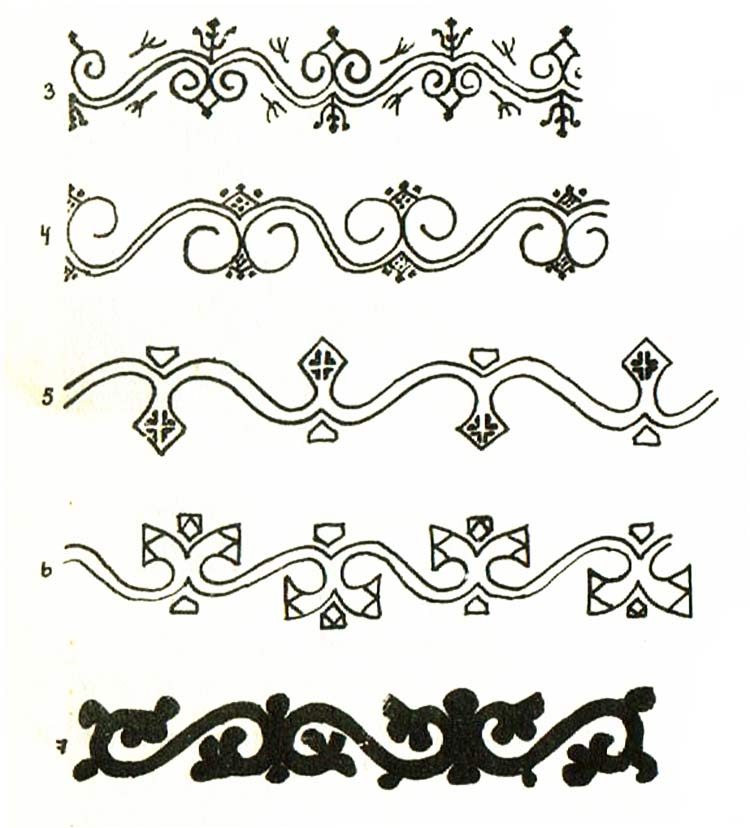
(3-7) intermittent curling tendril
|
On the other hand, the simple curling tendril is more similar to a natural stem of a plant (panel IV, fig. 10, box, scored into wood). The stem of the curling tendril was drawn with a double line.
|
|
 
simple curling tendril
|
The Yakuts always designed their intermittent curling tendrils with two lines. However, if the ends of the spiral curl very extensively, they ceased to continue the double line. They viewed these tendril ornaments mostly as plant patterns, so they rarely designed them in a different manner.
One wooden chest bears a very unusual version of the plain curling tendril (panel IV, fig. 13, kumys container, wood, chip carving).
|
|

curling tendril
|
On one wooden can, the intermittent curling tendril has four spots, with squares serving as fillers (panel IV, fig. 4, scored in wood).
|
|
|
In this image we see very clearly that the motif has been incorporated into the pattern (panel IV, fig. 5, box, scored into wood). The spirals are absent altogether.
Another variant of the pattern has the fillers of the sky ornaments evened out (panel IV, fig. 6, box, scored into wood).
|
|
|
| (Panel IV, fig. 24, bracelet, silver, engraved): an example of the third form of the Yakut tendril. It is based on the double spiral, in which both curls are facing in the same direction, and are connected by plant motifs. |
|
|
| Parts of the pattern can be viewed in more detail in the ornament on this bracelet (panel IV, fig. 25, silver, engraved). |
|
|
|
The individual double spirals do not coalesce directly. This form of tendril is used for more complex plant ornaments on smithery work, whereas it is never found on domestic products.
There is one pattern where the tendril ornament is comprised of double spirals facing only in one direction (panel IV, fig. 11, on calendar, silver, engraved)..
|

double spiral
|
The rounding of every double spiral is cut through twice (panel IV, fig. 12, saddle, silver, engraved).
|

double spiral
|
Plant motifs: The Yakuts did not include a single plant from their indigenous flora into their traditional set of motifs, altough more than half of the objects they processed are decorated with various plant ornaments. Authentic imitation was not common in their art. The primitive people were mostly satisfied with depicting those objects by geometric shapes that strongly influenced their way of thinking, i.e. mainly dangerous things like demons, spirits or human beings who had specific powers. This raises the question of how much religious content these ornaments contained. A plant will not appear in a simple person’s mindset unless it symbolizes some kind of power or is used for cultic purposes. This might explain why some plant motifs are virtually absent from the Yakut culture. The plant motifs often include the basic shapes of spirals or tendrils. They are not indigenous motifs but assumed from the high cultures of Asia.
The blossom: Again, the blossom on the ornaments in no way resembles actual flowers. Instead it displays the characteristic features of a lotus viewed in profile, as derived from the Middle East or the Mediterranean universe.
| Here, in contrast, we have two spiral curls that do not match this idea of the lotus at all (panel IV, fig. 29, shoe on saddle, silver, engraved, and fig. 25). |
|

|
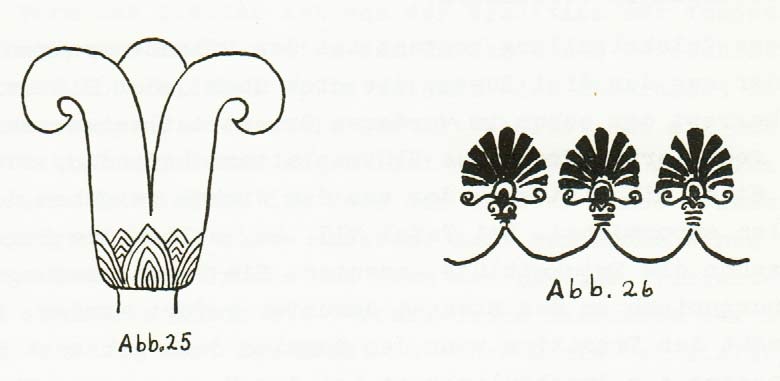
blossom motifs
|
|
The three arches above the little jags in the petal crown are more similar to the lotus representations of the Middle East (fig. 26). |
|
A horizontally striped center piece of the ornamental motif is perceived as the actual blossom by the Yakuts, whereas the curls represent the calyx. This can be seen from the fact that the filler appears detached from the curls or connected to them merely by a stem (panel IV, fig. 28, shoe on harness, silver, engraved, and panel V, 4, bracelet, silver, engraved).
|
|

blossom
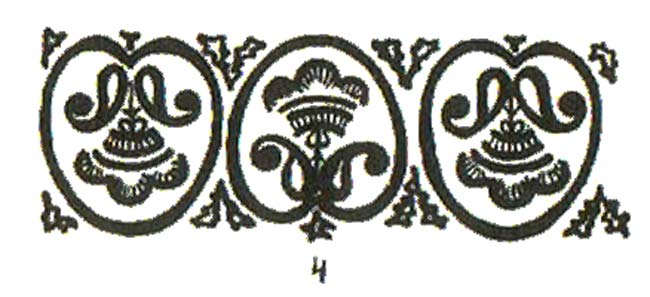
(4) blossom
|
Finally, the distance between the blossom and the calyx can increase to a point where the two curls no longer appear like sepals. Instead, other, more natural sepals surround the blossom (panel V, fig. 7, saddle, silver, engraved, and 8, shoe on men’s belt, silver, engraved).
Of course, if you view the curled calyx as being merely two leaves on the stem of the blossom, many of them can be arranged above one another because though one blossom has only one calyx, an infinite number of leaves can grow out of one stem. This development is exemplified by this silver shoe on a men’s belt (panel IX, fig. 4, shoe on men’s belt, silver, engraved, and panel VII, 28, decorative plate, silver, engraved). It cannot be determined with absolute certainty whether the smith wanted to depict a leaf or a bud at the tip of the stem. However, what seems clear is that a filler belongs between all these pairs of spirals that bend in opposite directions resembling curls. This becomes evident when you look at the following intermittent curling tendril, whose filler turns out to be the most important part of the ornament, more and more dwarfing the spiral branches (fig. 28).
|
|
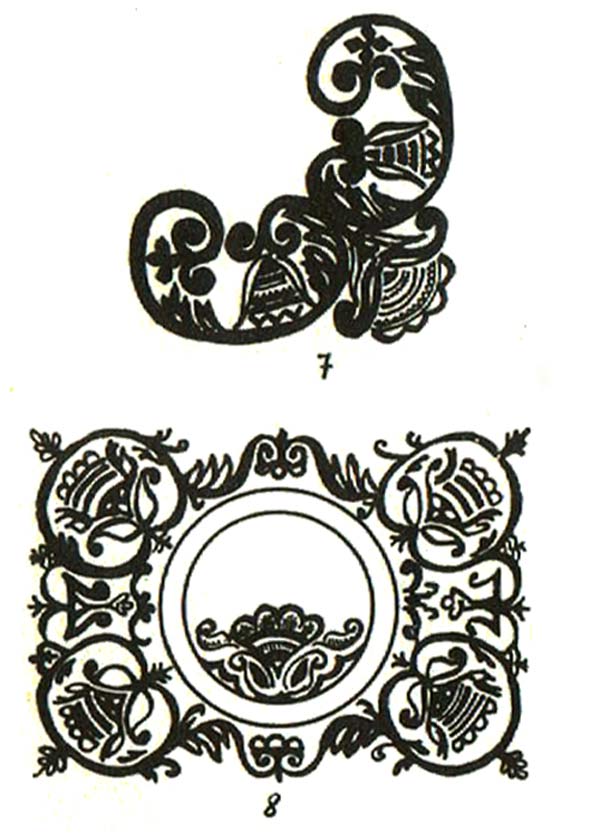
(7+8) blossom
|
In the case of plant ornaments the filler either consists of three arches located above every blossom shape as a remnant of the petal crown, which had been increasingly reduced in the Middle East at that time, or a stem with leaves growing from the angle formed by the spiral. Their construction is a clear parallel to the Middle Eastern “palmette tree”.
|
The leaf:
Leaves are the motifs that most resemble their natural archetypes. The Yakuts usually portrayed them as a round or conical lobular outgrowth on the stem, the stem retaining the basic shape of the ornament, which is either spirals or tendrils. Leaves are never more than additional attachments (panel IV, fig. 20, necklace, silver, engraved, and 21, bracelet).
|
Traditionally, the only rule for the shape of the leaf is that it has to have the outlines of, say, a willow leaf. Apart from that, it is left to the individual artist whether it is conical or rounded, curled or oval in shape or shown with or without leaf stems or veins. That way, the leaf becomes a line in brass-wire marquetry, while on scoops for kumys containers it is expressed as an indentation and so has a conically oval shape (panel V, figs. 21 through 24, spoon handle, wood, indented, and panel VI, fig. 1, spoon handle, wood, indented).
|
|
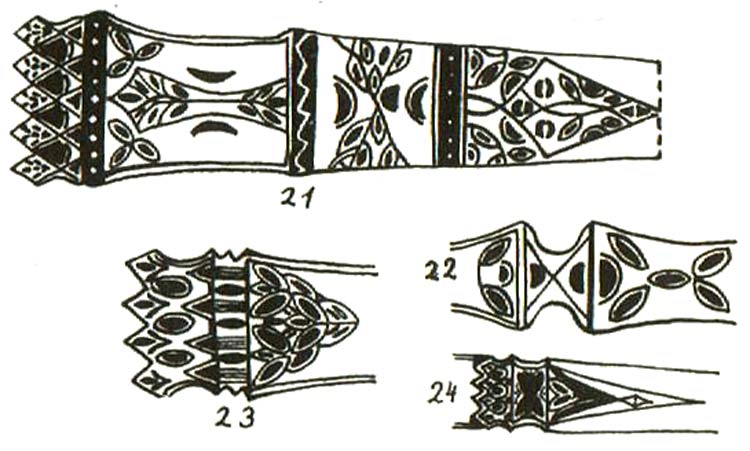
(21.24) leaves
|
 |
|
On very small objects, however, the outline is slightly blurred and resembles the fir-tree pattern (fig. 16).
Leaves are not always connected to the spiral or tendril ornament by a stem, sometimes they serve to fill otherwise empty spaces on the decorated surface (panel III, fig. 35, box, scored into wood).
However, this does not apply for the works of silversmiths but only for the rare products of domestic production.
This kind of shape consists of three oval leaves (panel III, fig. 19, women’s hat, textile, stitched).
This way, the Yakuts combine three leaves that have an entirely circular shape, like this tendril ornament (panel IV, fig. 7, decorative plate, silver, engraved).
|

fire-tree pattern

tendril

leaves

(7) leaves
|
This trillium is used particularly often on saddlecloths, where the spiral and the leaf cannot be told apart.
|
The Origin of Serial Ornaments with Spiral and Plant Motifs
The Yakuts stick to three types of tendrils or a specific arrangement of spirals defined by tradition. Accordingly, the basic shape of the blossom is specified. Either it is similar to the lotus in its profile, as observed on archeological finds in the area of Iraq, or it looks like a rosetta, when shown in front view.
Russian ornaments often use spirals and tendrils, always in assocation with plant motifs. Animal and human shapes are the most common. The Yakuts, however, do not know these biomorphic shapes.
While the tendril, derived from the double spiral, is entirely absent from Russian ornaments, a few examples, works from as early as the 17th and 18th centuries, provide the basic principle of these intermittent or plain curled tendrils. Sometimes, mere jagged acanthus leaves make up the tendril, with the actual stem missing altogether. These changes in Middle Eastern and Greek tendril ornaments began to take place no sooner than the Roman Iron Age and reached their apex in the Bzyantine period. The shapes of Russian plant ornaments overlap the same way the tangling ribbons of pre-Christian Germanic art do. The Russians assumed and developed the later Byzantine form of the tendril ornaments, the idea of which can be traced back to the Egyptians. The fact that plants are depicted shows the influence of the Mediterranean world. This type of development was utterly alien to the ornaments of the Yakuts, the Buryats and the Mongolians, who lived even further south.
The peoples of the Altai and Sayan areas ceased to use the old patterns after the advent of the Lamaist religion. The old signs can be found only on a few shaman drums. Objects of everyday use got painted with motifs copied from Chinese textiles. Other objects, like chests or enamel boxes, were imported directly. No similiarities to the Yakut examples have been found.
Also, no parallels are found to the Kyrgyz and the Karakyrgyz (Mountain Kazakhs), with the exception of a few examples of plain curled tendrils, even though they do use plant and spiral ornaments. Furthermore, the Kyrgyz ornaments are clearly different from Yakut ornaments in terms of their entirely different senses of style. In difference to the Kyrgyz or other Southern Siberian nomad peoples the Yakuts make a clear distinction between pattern and base, which makes their ornaments much calmer. So, while the Yakuts are satisfied with dispersing ornaments in a sparse but attractive way, the Kyrgyz and their neighbours, the Sarts (an Iranian ethnicity) and Uzbeks love to overload all objects they attribute a certain value to with decorations and fill all areas with them entirely. Even regarding their coloring, the Kyrgyz ornaments appear completely different. Their colors tend to be pastel shades, and the color blue is more common, while the Yakuts use only black and the colors red, yellow and green, blue is rarely found.
As there are no parallels whatsoever to the Southern Siberia of today, such motifs can be observed in connection with the prehistoric influence on Yakut ornaments or the influence of their Turkic ancestors.
The spiral first appears in the ornaments of Southern Siberia in the period of the animal style starting in the second half of the 1st millennium BC. Their local formation is traced back to a schematic representation of a ram’s head (fig. 27). As a ram’s head was not easy to draw, it was subsequently simplified as two double spirals (fig. 28). In the time after that, the double spiral appeared not only on knife handles but also as decorations on other objects. The Kyrgyz liked to use double spirals in their ornaments, yet without arranging them alternately facing up and down like the Yakuts did.
The finds of the early Pazyryk culture are particularly impressive. Spirals on which the coils of the ram’s horn are still depicted are found next to totally abstract spiral patterns on several saddles from the late Pazyryk culture (fig. 29).

spiral pattern
Textiles or other pieces of jewelry were not only decorated with animal motifs in the form of this largely simplified ram’s horn representation but also with plant ornaments. These motifs (figs. 30 and 31) are comparable to applications on tapestry from the Pazyryk period with the pattern of enameled bricks in Nebuchadnezzar’s palace in Babylon. These Pazyryk graves date back to the 6th through 2nd centuries BC. The Middle Eastern motifs appeared very early here. In other areas further east, such as at the Yenisei area and Mongolia, they were accepted much later, as judged from the previous finds. This is backed up by the fact that the Yenisei-based Kyrgyz and the Mongolians had ties primarily with China, while at the Altai, being located further west, relevant influences came mainly from the West, South and Southwest, i.e. from Achaemenid Persia, the realms of Mesopotamia and the western Scythians, from the Saka between the Caspian Sea and Lake Aral and the Massagetae, though parallels to later finds in Mongolia are also attestable. Finds in the area of Amudarya (a river originating at the Pamir) bear witness of how these motifs migrated.
The unbelievable splendor in the Middle Eastern realms of that period were admired not only by the Greek, who praised the hanging gardens of Nebuchadnezzar’s wife as a Wonder of the World. The nomad tribes must have been pretty impressed by all the riches as well, because they were featured on numerous imitations in their own art. Under these circumstances the patterns were obviously not adopted in terms of their religious symbolism but in order to depict extensive wealth. In a way, they had become “prestige objects”.
When you compare these motifs, which are owed to influences from the Middle East, to the Yakut forms of jewelry, some parallels are striking. Both the single and the double spiral are found not only in the Yenisei area but also often in the graves from the Pazyryk culture (fig. 32).
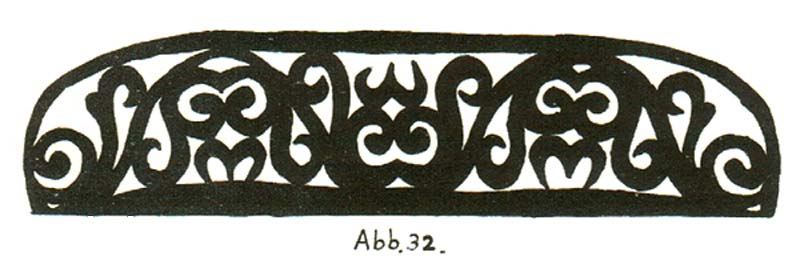
double spiral
|
On another find the pattern of the single curled tendril is partly cut out of gold foil and sewed as well as partly stitched onto a leather belt (fig. 33).
|
|

curler tendril – spiral
|
An application (panel IV, fig. 11, box, scored into wood) resembles this pattern.
On a different one, the motif is an S-shaped spiral (panel III, fig. 38, glove, leather, stitched). |
|

spiral

spiral
|
|
However, a so called Yakut “adaptation” with S-shaped spirals does not parallel the finds from the Pazyryk culture at all (panel VII, fig. 14, decorative plates, silver, engraved).
|

decorative plate
|
It can be compared to Chinese “adaptations”. This is due to the fact that the Chinese patterns are derived from the meander. A decorative plate from the Pazyryk culture (fig. 35 – bottom) also bears striking resemblance to one Yakut counterpart (panel III, fig. 36, shoe on harness, silver, engraved).
The meander is an orthogonal (perpendicular) ornament that has been used since the Neolithic era (fig. 34 – above).
These spiral basic shapes parallel details of plant ornaments in many respects (fig. 30). A blossom depicted on a wall hanging from the Pazyryk period looked exactly the way inhabitants of the Altai from the 5th to 3rd centuries BC used to depict them.
One Yakut ornament clearly displays parallels to the above (panel VII, fig. 14, decorative plate, silver, engraved).
The shape of a calyx on a decorative plate (fig. 36) bears striking resemblance to the Yakut pattern or a pattern of a decorative plate (panel IX, fig. 4, shoe on men’s belt, silver, engraved).
Further parallels are found between the bottom part of a blanket from the Pazyryk period (fig. 37) and a Yakut ornament (panel III, fig. 19, women’s cap, textile, stitched).
Back to the so-called “palmette tree”, and it can be compared to a Yakut representation on a belt shoe (panel IV, fig. 26, bracelet, silver, engraved, compare to fig. 38). It is from the kurgan at Cuja river (in today’s Altai Republic) from the 6th to 8th centuries AD, and it has been forged from gilded silver. .
Two felt carpets from the 6th century AD, found in Northern Mongolia at the central section of Tola (Tuul) River, are decorated with a plain curled tendril in the way known from the Yakuts. Their patterns are considered to be influenced by Sassanid sources (fig. 39).
The central pattern resembles the following carpet structure (panel VI, figs. 17 and 18, tweezers, silver, engraved).
Research on the Prehistory of the Altai area has been utterly incomplete so far. At least comparisons between Yakut ornaments with patterns of the Altai population in the last century BC and partly in the 6th and 8th centuries AD as well as a few motifs from Northern Mongolia from the 6th century prove that plant ornaments must have been part of the cultural heritage of the Turkic groups among the Yakuts. They had to have been passed down to Southern Siberia as mere decoration without any religious meaning. However, it cannot be determined who these cultures were passed down by in kurgans of the Pazyryk. A Europid woman lies buried next to a Mongolid man, so they must originate in the time when the two elements mixed in this zone. There are considerable time intervals between the individual finds.
As it seems, the Yakuts did not see any deeper meaning in the tendril ornaments. Yet, as almost all other ornaments in woodwork have some kind of meaning they had to be aware of up until the past century, as they were also aware of the meaning of the sky ornament, it would have been highly unusual for a Yakut to carve an ornament with no meaning at all. This might explain how the intermittent curled tendril was assimilated with the sky ornament and how other elements that possessed a meaning of any kind for the Yakuts were added to the spiral ornaments (panel IV, figs. 3 through 6, box, scored into wood).
|
|
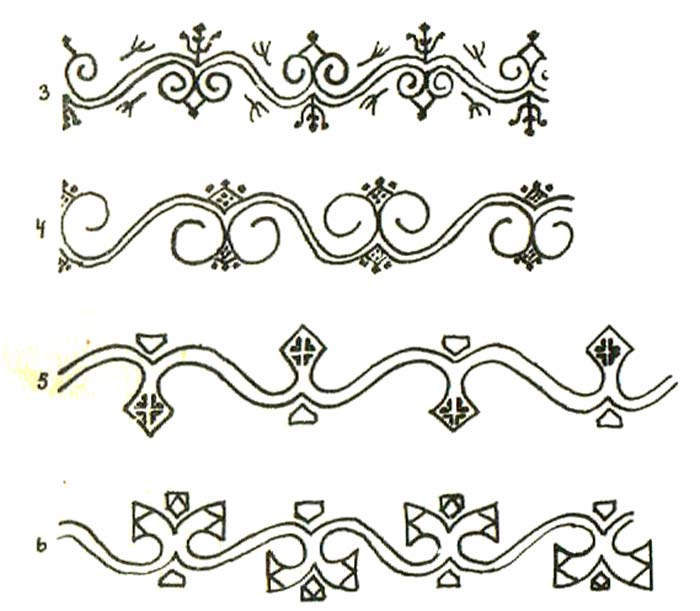
(3-6) curled tendril and sky ornaments
|
It has not been determined whether there is a meaning behind these S-shaped spirals, but it has been pointed out several times that they could be construed as animals in agony, especially in the areas that once practiced the animal style. In fight scenes these mammals were displayed with the rear parts of their bodies twisted in a way that resembled the outlines of the letter S. Many of these S-shaped spirals were found in the kurgans from the Pazyryk culture. The motif itself was depicted rather frequently in the Altai even in the previous century.
The main valuable material goods the Yakuts owned were thus jewelry made of precious metals decorated with spiral and plant ornaments. Apart from some arch shapes and the rope signs, motifs of this kind are found solely on the works of silversmiths. Even shapes that should not as such be rounded were given the beginnings of a spiral, such as, for example, the crossed bones under the skull, a sign adopted from the Russians. The bones could be either slightly bent or reinterpreted as an entire spiral (fig. 40).
|
|

spirals
|
|
|
The lyra motif:

|
(Fig. left-hand side) The most common motif among the spiral and plant ornaments has a basic shape that resembles, for instance, a lyra or a Latin letter W.
An alternation of spirals, as illustrated here (fig. 41), in reversely arranged representations, like they occur on archeological finds in Tibet or among the Kazym Ostyaks, is not known by the Yakuts (panel IX, fig. 5, women’s hat, textile, stitched – right-hand side). This particular motif proves how much the Yakuts enjoyed variation. |
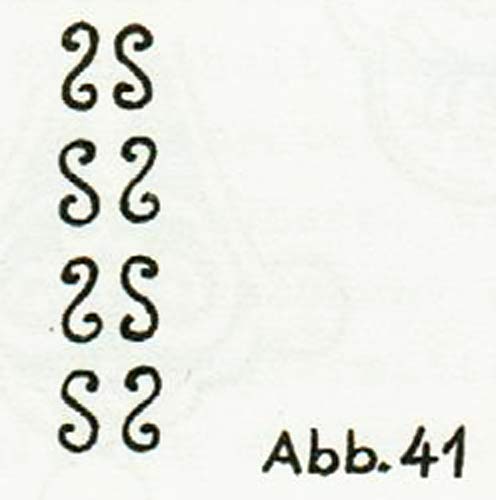
spirals
|
|
|
Lyra motifs often communicate with spirals to form a single pattern (panel VI, fig. 3, bag, buckskin, stitched, and 5, bag, textile, stitched).
|
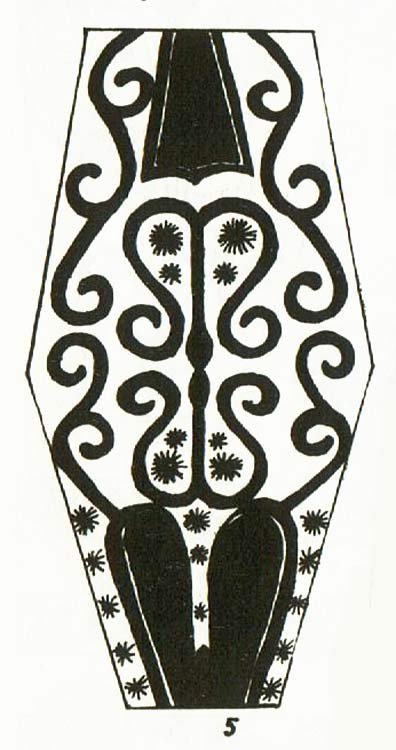
|
|

(2) textile, stiched
|
|
Sometimes they form variations of a more complex kind (panel VI. figs. 6 and 13, saddlecloth, textile, stitched, 14, saddlecloth, leather, stitched, panel VII, 11, tag, silver, engraved, and panel X, 2, women’s hat, cloth with embroidery – left-hand side).
|

shoe on a belt
|
|
Despite the limited number of plant ornaments and the unflexible basic shape the same mode of decoration is repeated very seldom on identical pieces. This is shown on these four silver belt shoes, all derived from the same belt (panel VII, figs. 1 through 4, shoe on men’s belt, silver, engraved).
|
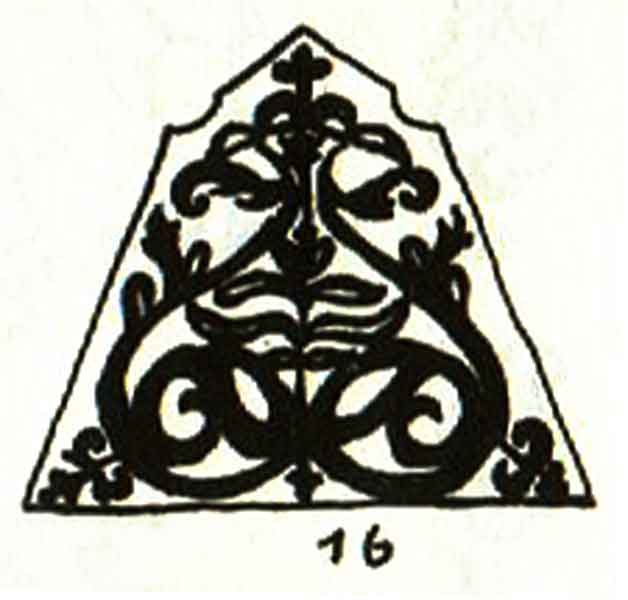
decorative plate
|
|
Apart from its occurrence on stitched saddlecloths or on harnesses and men’s belts, the lyra motif is also found on decorative tags of Yakut women, either in the plain form as a specifically S-shaped spiral or, as previously described, as voluptuous plant ornaments (panel VII, 16, on a decorative plate, silver, engraved). |
| Very often, several smaller decorative tags are attached to the larger and more thoroughly ornamented ones (panel VII, fig. 28, decorative plate, silver, engraved). |
|

(28) decorative plate
|
Examples of tendril ornaments:
(panel V, fig. 1, chest jewelry disk, silver, engraved, 2, shoe on knife sheath, silver, engraved, 3, 6, 7 and 9, saddle, silver, engraved, 4 and 10, bracelet, silver, engraved, 5, decorative plate, silver, engraved, 8, shoe on men’s belt, silver, engraved, and panel IV, 29, saddle, silver, engraved).
|
|
 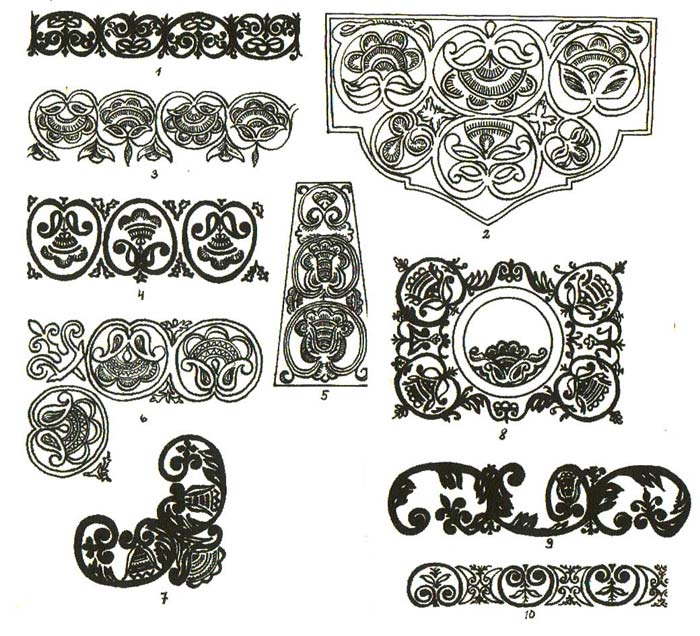
(1-10) tendril ornaments
|
| It is hard to recognize the original shape of the lyra motif on this jewelry. |
|
|
|
|
|
 |
Apart from sprawling forms of such ornaments, to which any number of additional spirals or plant motifs can be added, dwarfed forms appear as well, for example in more coarsely processed cast forms of decorative plates.
The outlines of the pattern are hard to discern (panel VIII, fig. 1, tag, cast from made of lead, 2 and 3, tag at an earring, tin, cast, 4 and 6, decorative tag, lead, cast form, 5, tag, cast lead, 7, glove, leather, stitched, 8, tag at an earring, cast brass). |
|

tag plates
|
In some ornament plates, only a characteristic contour shows that these originally belonged to the lyra motif (figure 42).
|
|

decorative plate
|
|
|
Contours, however, are frequently only indicated as a sequence of bows (panel VII, figs. 15 and 30, decorative plates, silver, engraved).
|

decorative plate
|
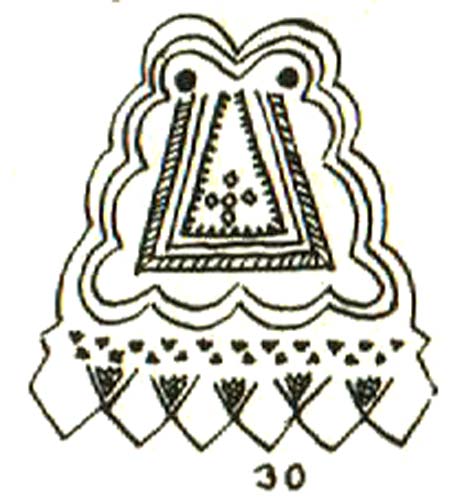
decorative plate
|
|
|
The silver smiths have used even simpler patterns, similar to a trapezoid.
(Panel VII, figs.9, 12 und 31, decorative plates, silver, engraved). |

decorative plates
|
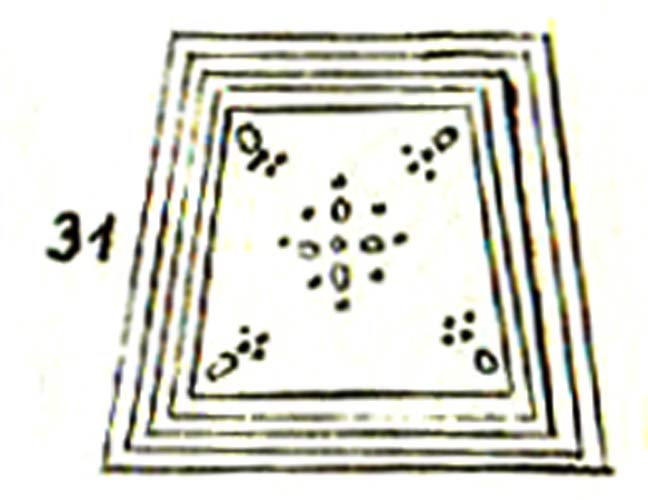
decorative plate
|
|
Many decorative plates formed according to the outlines of the lyra motif have a blossom or a petiole in their profile (panel VIII, fig. 13, decorative plate, silver, engraved, 15 and 20, earring, silver, engraved).
The original lyra motif, however, can no longer be identified.
|
|
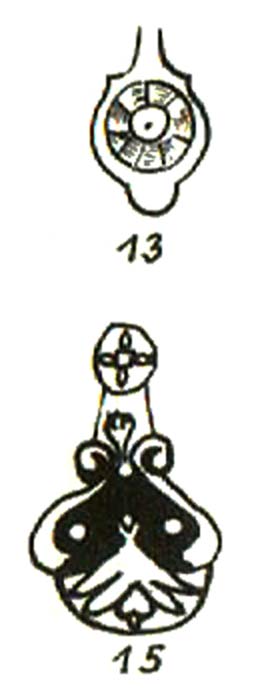
earring
|

earring
|
|
On wood, the lyra motif appears only in a dwarfed version. The outlines are completely adjusted (panel VIII, fig. 31, box, scored into wood).
The patterns are harder to create on wood than on silver, which is why crosses above the lyra pattern are often found in a slightly adjusted version (panel VI, figs. 4, 11, 12, saddlecloth, textile, beadwork – panel VII, 13, decorative plate, silver, interrupted, 15, 16 and 23, decorative plates, silver, engraved, panel VIII, 15, earring, silver, painted – below right-hand).
|
|

(31) wood box
|
Sometimes the pair of spirals is replaced by the nook, so that the final result is a W shape (panel IX, fig. 2, box, wood with bone inlets, 3, door of a birch-bark tent, glued, 4, shoe of a men’s belt, silver, engraved, and panel VIII, 27, box, birch bark, glued, and 28, wall hanging, birch bark, glued).
|
|
(2) woodenbox
|
|
|
|
|
(4) shoe of a men's belt
|
|
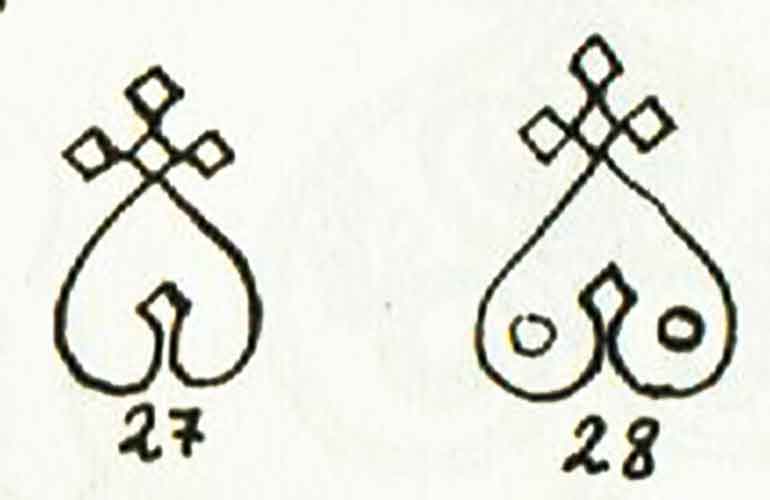 
birch boxes
|
Tags in cast shapes: (panels VIII, fig. 23, tag, silver, cast, 24, tag, lead, cast, and 25, tag, brass, cast).
These patterns can be found on metal or on stitched cloths.
The smiths to use simpler patterns that resembled a trapezoid. |
|
(23) tag
|
|

(24+25) tag
|
|
The Origin of the Lyra Motif
No parallels whatsoever to this motif can be found in connection with the Yakuts’ neighboring peoples. In fact, the Kyrgyz have one they call “Two dogs fighting over a bone” (fig. 43).
|
|
lyra motif
|
This of course indicates that the name “lyra motif” does by far miss the orginal meaning of this ornament. It is possible that older motifs were assigned their names at a later point in time. Even the Kyrgyz were not excessively using the lyra motif, and it was in no way varied or redesigned as it was by the Yakuts.
From such representations of the animal head that were found in the first kurgans of Pazyryrk and have become a traditional shape by now, a more sophisticated motif developed that is found in a considerable number in the second kurgan (fig. 32, the ornament here is cout from gold foil, 44, on a women’s boot, 45 and 46, on a leather bottle).

double spiral
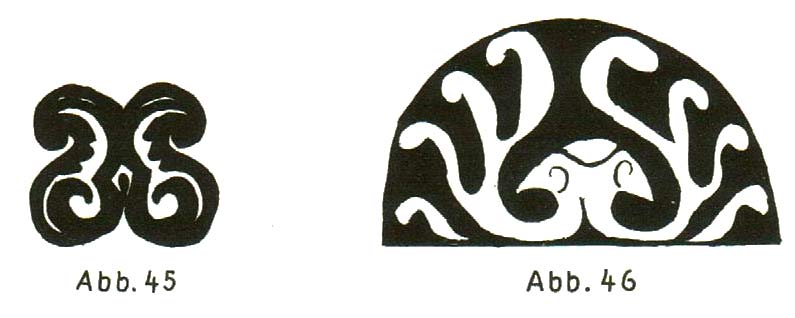
leather bottle
|
|
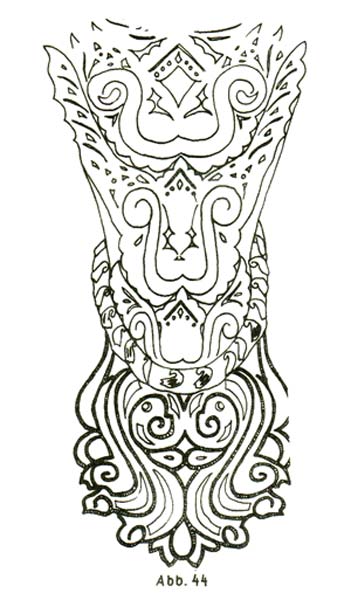
women's boot
|
Among the prehistoric finds the motif appears as a form of jewelry the Quryqans used to have (that is a Turkic tribe also known as Ruan Ruan or Juan Juan). Apart from that, comparisons with the prehistoric evidence in Siberia indicate the same direction already known from other spiral and plant ornaments: Parallels are found only among the objects that were excavated in Pazyryk.
|
Comparison of ornaments on a gold foil (fig. 32), on a women’s boot (fig. 44) and (fig. 45) on a leather bottle.
(Panel VI, figs. 6 and 13, saddlecloth, textile, stitched, panel VII, 11, tag on a cross, silver, engraved, and panel VIII, 26, chest, scored into wood).
Yakut motifs on wooden objects (fig. 46, above, panel VI, 15 and 16, shoe on men’s belt, silver, engraved – below).
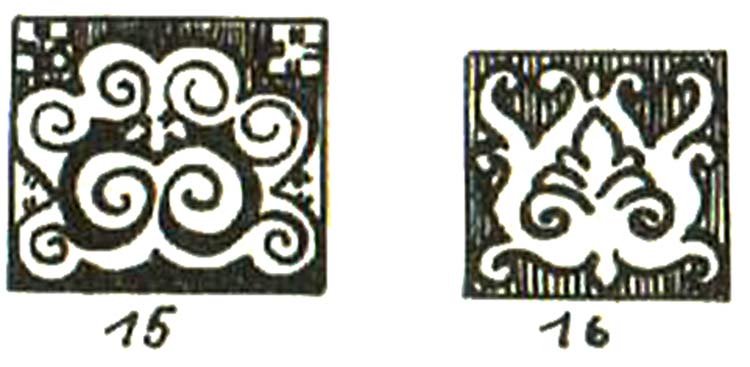
shoes on men's belts
|
|
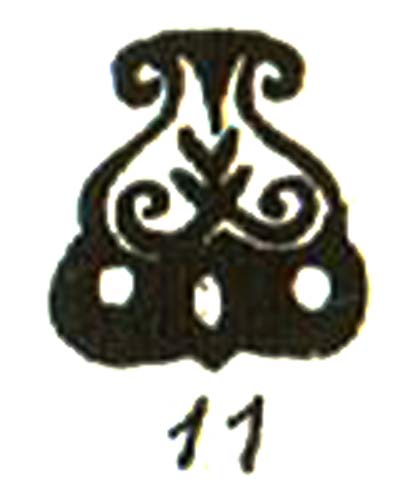
|
Previous forms of these patterns are found in the first kurgan of Pazyryk. For these patterns the head of an argali was obviously imitated. The ram was already being variied like this, with its horns, to become a regular shape depicted, as tradition dictates, without imitating nature.
| Argali |
 |
|
(fig. 50) shows a ram’s head alone.
|
This might explain derivations like this (figs. 47 through 49). It seems as if from reasons of tradition these representations were of relevance, and they adjusted to the shape of the Middle Eastern palmette (this little palmette tree is a symmetrical abstraction of a palm tree top as a basic ornamental shape).
One step towards the development of a mere decorative shape whose meaning the artists were unaware of must have taken place by that time. The logical consequence of this is that a certain period of time must have passed between the erection of the first and the second kurgans of Pazyryk. While jewelry and the finds from the first kurgan consist only of animal motifs, i.e. almost exclusively of the head of an argali, which would provide evidence of first traces of a certain development towards the spiral pattern, finds from the second kurgan have processed these beginnings into an abundant set of spiral ornaments. Its extensive development was aided by influences that originate in the Middle East. The two kurgans cannot be attributed to two different peoples of the same period, as they lived in relative geographical proximity to each other. One and the same burial site very often housed many generations.
|
(fig. 51): Ornaments from a somewhat later period show this type of development of the representation of an animal head. The horns now resemble two S-shaped spirals.
|
|

animal head
|
What made the inhabitants of the Altai area depict the argali’s head again and again? Why was this motif considered so important that, even when its meaning was forgotten, it continued to be one of the most popular decorative shapes? The archeological finds as such are the only sources on the religion of the Altai inhabitants. In order to understand what is expressed by them, there is no other way than to consult the old ideas that have survived among their descendants. Sheep, even wild sheep, are the most commonly sacrificed animals, like in many areas of the Old World. As reported, when the gods of the Altai people were sacrificed to, they were initially satisfied with just a picture of what was promised or a proxy offering of a very small animal. This could have been an incentive to illustrate sheep more often.
A Yakut rule defined which gods were to receive sheep sacrifices. It says that the spirits of the sky had to be offered hoofed animals, while lower spirits were to receive horned animals because hoofed animals are masculine and horned ones feminine. The distinction between horns and hoofs is not easily understood as according to the European concept, horned animals also have hoofs. As it seems, the Yakuts did not regard all artiodactyls as hoofed animals but only horses, which have a closed hoof.
In their former area of residence further south, the Yakuts must been familiar with the argali. In the northern, more humid area sheep breeding was no longer profitable. Therefore, the only available horned animal was the cow. At the spring feast some horses that were of a coloar that was as light as possible were dedicated to the sky, while Mother Earth was offered a cow. The shamans of this region used to address the “mighty bull of the Earth”. The cow as a sacrificial offering has been mentioned before. Embracing the contrast of feminine vs. masculine with the man representing the upper world and the woman the lower realms, is consistent with the practice from Christian times that involved giving deceased men their favorite horse to take with them, while women were given a cow on their way. This explains the frequence of highly schematic cow representations, which had been considered toys, just like until not so long ago dolls were thought to represent Yakut spirits.
The Buryats used sheep and horses as the main sacrificial animals. Unfortunately it has not been identified who they were offered to. The skin of the horse is flayed, like with all Altai peoples, and suspended on a high rod with the head on top. The Altai peoples themselves dedicate a horse (as light-colored as possible) to a sky god namend Ulgan (Creator). However, he must never receive it from a female shaman; it has to be a male one. During the New Age, only certain priests were allowed to perform this practice. Female shamans were only able to communicate with Erlik, the lord of the underworld, or other earthly spirits. What is more, when offering to Ulgan, women were strictly forbidden to even be present. Even when the horse was not slaughtered but simply dedicated to Ulgan and subsequently set free, women were banned from touching that horse ever again. When offering sheep and goats, however, women were involved. The same rule has been observed for the people of the Yellow Uighurs, who live in the northern foothills of Nanshan (Northwest Chinese Mountains), where women are not allowed to eat the meat of sacrificed horses.
|
In Inner Mongolia stag and cattle are worshiped, both also “horned animals” epitomizing earthly deities. In parades they accompany “Yama”, the Lord of Hell (today an important character of Buddhist mask dances), who is often portrayed as a bull-headed monster. A certain ideological connection between women and rams is seen in the somewhat unusual headdress that is known by almost every Mongolian tribe and that imitates the horns of the argali, i.e. the wild sheep. This headdress is worn by married women only. In earlier times not only Mongolian women but also the wives of rich Kyrgyz men wore it. The Yakut women then used to own hats with two horns on them. This decoration, called “the horns” by most peoples, was already known by the peripheral ethnic groups of China and by the Red Huns (Xionites) in the Chinese Middle Ages. A little later, in the 5th century AD, this headdress appears to be common among the Persians, too, as seen on one silver dish (fig. 52).
|
|
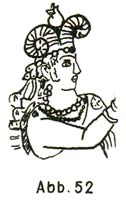
plaster head
|
The Turkic groups at the Orkhon mainly sacrificed sheep and horses. Considering the fact that the Turks at that time used to worship the sky and the earth, the choice of these sacrificial animals can be explained only by assuming that the horse, as it was common for all other peoples of the Old World, was dedicated to the sky, while the sheep was sacrificed to the earth. Even in China cattle and sheep were attributed to the element of earth, and the horse was associated with the sky. The horse is part of the yang principle, while cattle and sheep belong to the principle of yin. The Uighurs are observed to follow similar structures. One inscription mentions the blue sky – “Kök tengri”, and next to it: “javizjir”, or the stag earth.
A song played by the Altaians on the harp explains why the horse was not depicted as often: “Rarely do we sacrifice to the Ulgan because he is good anyway.” The carriers of culture in the Altai probably preferred to offer to the lower, more evil-minded spirits in order to protect themselves. When showing the ram’s head on garments or harnesses, it was in fact an amulet. This stylized depiction of the ram’s head can therefore be traced back to the finds in the Altai of the 5th century BC until the 8th century AD. Chinese and Lamaistic symbols had considerable influence on the ornaments of the Altaians of today. Many objects were imported. The Altaians, Tuvans, Telengits, Shors, Karagas people, Khakas people, Kysyl people, Kumandins and Teleuts produced only few idiosyncratic ornaments, as far as the material at hand tells us. The motif discussed here was unknown to these people, with the exception of the Kyrgyz, and it occurs among the finds that are attributed to the Avars in Hungary, who also came from Central Asia. The only people that grant this motif the same high relevance is the Yakuts. As all the other motifs found on Yakut ornaments in Pazyryk are repeated, it should be proven that the Yakut lyra motif has developed from the Pazyryk ram’s head. The lyra motifs scored into wood are called “köküör” – “large kumys bellows” or, with reference to the cross in the upper part, “kirikäs” – “cross”.
|
The motif of the Yakut representation of cows could also have been generated from this: (fig. 53). The depiction of toy animals is very rare. Most of the time, two horns were simply carved out of a branch, which was enough for the children to imagine it to be a cow.
|
|
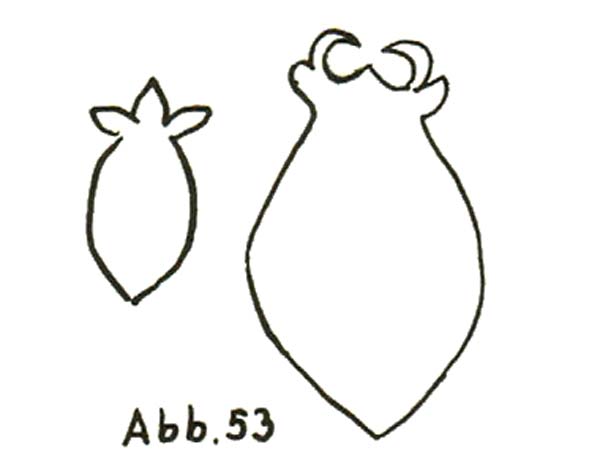
cow imagines
|
One circular carving work has at its center the Yakut sign for the sun, including four lyra motifs (panel IX, fig.1, on wood) as well as four small blossom motifs. The arrangement of four lyra motifs around one central shape is rather common (panel IX, fig. 2, box, wood with bone inlets, panel VIII, 33 and 34, box, scored into wood).
|
These ornaments are boxes prepared from wood.
See a wooden Buryat can here for comparison (panel VIII, fig. 32, box, scored into wood).
|
|
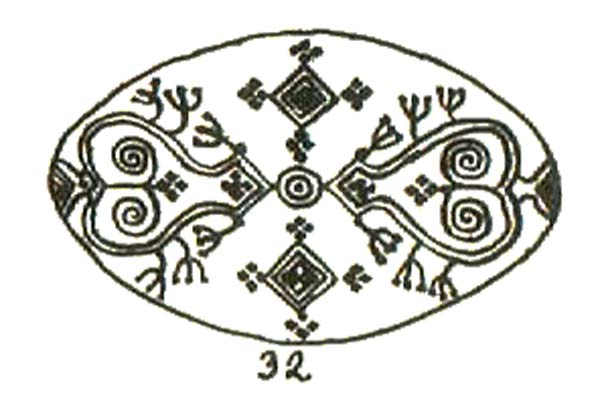
box
|
One can assume that the symbol of the earthly gods was attributed to the sign for the sun or another celestial body. The Yakuts divided the Earth into four or eight geographic directions, and one stylized ram’s head has been inserted here for each of them. Just as the shaman bows towards each of the four directions before a ceremony, thus saluting all spiritual beings around, this quadruple repetition of the motif serves as a means of juxtaposing the whole Earth with the sun in the center. The motif represents the universe in its entirety.
|
Here might be another method of expressing this idea (panel IX, fig. 3, door of a birch-bark tent, birch bark with glued-on patterns, and panel VIII, tag at an earring, lead, cast), where above each lyra motif there is one section of the celestial arch ornament. The pattern represents a serial ornament, like all other forms of the celestial arch ornament.
|
|

door of a tent
|
|
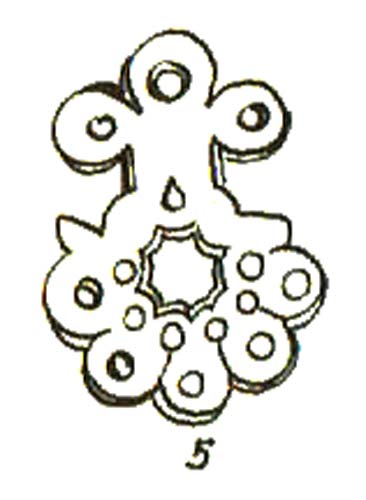
earring
|
Wooden box (panel VIII, figs. 31 and 32, wooden box, engraved by the Buryats).
It is, however, even imaginable that the rather frequent connection of cross and lyra motives symbolizes the idea of displaying the cosmos in its entity.

woodenbox
|
|

woodenbox
|
.
|
The Ram’s Horns
Another very common motif is found on wooden cans and silver jewelry as frequently as the lyra motif, although unlike the lyra motif, no specific shapes have developed on the objects of said first material. In the treatment of the two materials no significant difference can be observed. The basic shape is that which is expressed most clearly (panel X, fig. 14, on a box, scored into wood). It consists of a cross, the four arms of which end in two spirals each. The center of the cross is emphasized by a quadrangular panel but can also be depicted as a circle (panel X, fig. 10, button, silver, engraved).
This also applies when the pattern is very small, like on the skirts of two chests (panel X, figs. 21 through 23, scored into wood).
|
|

(21-23) ram's horn motifs
|
| This cross has a circular top (panel X, fig. 4, box, scored into wood).
|
|
(4) woodenbox
|
|
In this case the spirals and the ends of each cross arm were polished to form a trident (panel X, fig. 10, button, silver, engraved).
|
|
|
Again, the basic shape is not easy to discern (panel X, fig. 20, box, scored into wood).
|
|
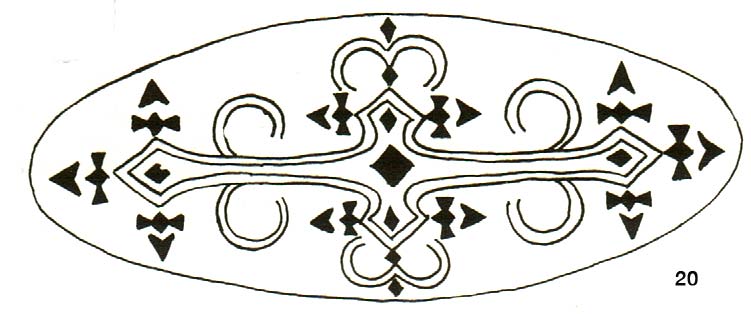
(20) woodenbox
|
| In this central motif of a circular piece of breast jewelry (panel XI, fig. 6, decorative breast disk, silver, engraved) four blossom motifs replace the spirals. |
|
decorative breast disk
|
| It is even harder to see the basic shapes of the following patterns (panel XI, figs. 1 through 5, shoe on harness, silver, engraved, and panel X, 15, shoe on men’s belt, silver, engraved, 16, earring, silver, engraved, 17, decorative plate, silver, engraved).
|
|

(1-4) shoe of harness
|
If the lyra motif is derived from the horns of the argali of the Pazyryk culture this would also explain why the motif is never absent from the summer hats of Yakut women (panel X, figs. 1 through 3, women’s cap, textile, beadwork, and panel IX, 5 through 7, women’s cap, textile, stitched). It was part of Yakut women’s headdress.
The development that lead to this variant is illustrated in fig. 54.
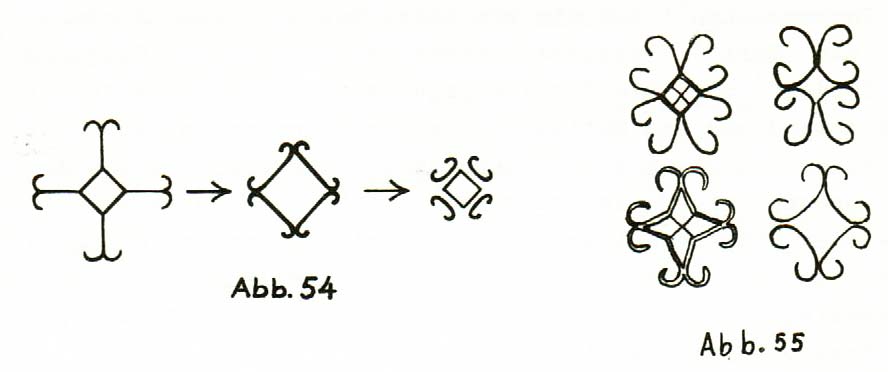
Phenomena parallel to the development of this motif can be found in the ornaments of the population of Central Celebes. In fact, the key member of this series of developments is found there (fig. 55). That is to say, the same cross pattern also prevails in many parts of Indonesia.
|
The origin of the ram’s horns
In contrast to the lyra motif, one need not search for long to find this pattern in the art of other peoples. It may also be found in the northern areas of Siberia, but all the South Siberian nomads use it: the Kyrgyz, the Kara-Kyrgyz (mountain Kazakhs), all Mongolian peoples, the Altaians, the Turkmen, even the Bulgarians and the Chuvash that had emigrated from Asia and were already settled for a long time and the Finno-Ugrian groups of Mordvins and Mari influenced by them. It is also sometimes found among the Ostyaks and the Golden.
The variation of the motif, in which it is changed to four double spirals, is not common among all the named peoples. Instead, the pattern has been change slightly. I.e. if it is used in weaving or knotting techniques, it becomes more angular (Fig. 56). In a Turkmen carpet, the basic shape of the Ersary, the „Temirdschin göl“, appears.
|
|

Turkmen carpet
|
The basic shape of the pattern is not to be misjudged. To our knowledge, the name of the four arms of the cross is the same among the Kyrgyz, the Kara-Kyrghyz and the Mongols: ram’s horn. The Bulgarian Shopi from close to Sofia that are known to be very conservative, call it “little horns”.
(Fig. 57) An old Kyrgyz ram horn pattern. This relates to the story of an “old master”: In the evening, at the birth of the new month, the people sat in their yurt and ate exclusively the meat of the sheep.
The petering crossarms in the spirals represent the horns of the Argali, the sickle thereon represents the new month and the thick cross represents the grate of a yurt. The oval contour of the pattern represents the spoons used for eating.
Many stories may seem a little far-fetched: We know for a fact of the ram’s horn ornament, pointing to the four compass points, and the crescent moon of the Kyrgyz. |
|

carpet
|
Even in ancient China, the sign for sheep was written in such a manner (see the following sketch).

| The origin of the pattern is not to be found among the Kyrgyz or the Chinese as previously assumed. Grave findings in the old city of Lo-lang (Naknang in Japanese), today’s Pyongyang (North Korea), have shown that the pattern already existed in North Korea (Fig. 58). |
|
pattern
|
| It resembles the presented motif in an astonishing degree (Panel X, Fig. 4, box, carved in wood). There is no date but it can be assumed that it stems from the period from 108 BC until 313 AD. |
|
boxes
|
Taney interprets these symbols as simple symbolic representations of the three Chinese dimensions of the Cosmos:
|
1. The separation into the five elements, four of which correspond to the seasons and compass points (wood – east – spring, fire – south – summer, metal – west – autumn, water – north – winter) whereas the fifth is the centrally located earth. |
|
2. The separation into eight segments that is also often used in China, for instance in the case of the eight trigrams*.
|
|
3. The separation into twelve segments that are months or double hours. |
|
* The eight trigrams (eight signs of the oracle) are used for fortune-telling and are the foundation of the old Chinese “I Ging” (Book of Changes). They consist either of three continuously drawn lines (yang) or discontinued lines (yin). It follows that there are 23 = 8 possible combinations that are often displayed in a circle. Two trigrams equal one of the 64 (26 = 82 = 64) hexagrams, whose meanings are described in the Book of Changes. |
These classifications were extremely important for ancienct China because the Chinese organized their government according to this cosmic order, it influenced the material and spiritual culture, even the daily lives. Everyone knew it and it was considered infinite and holy, because according to Chinese belief, the cosmic order had to be instituted on earth as well for humanity to be able to enjoy peace and happiness. Changes in the night sky were accounted to events on earth and could also be rebalanced by such events. It is truly easy to find a five-part, eight-part or even twelve-part order in this sign. In addition, it is possible to find the division into 28 lunar outposts on this symbol as it is common in China, if one counts all the ends. The Chinese separate the realm of the stars, which they believe turns within one year, into 28 “stations”. The north star in the center that represents the emperor of the sky is the stable core. The sun is in seven stations or constellations during one season. The ends of the sign are organized precisely in the rhythm of the lunar stations, which are 4 (2 + 2 + 3).
There is also the rhythm of 4 (2 + 3 + 2) that is depicted in accordance with Saussure without paying close attention to the actual distance of the stars that are the stations for the moon’s orbit: (fig. 59).
|
|
|
| The other organization 4 (2 + 2 + 3) is not further explained by Saussure. However, it cannot be symbolized in any other way than on the ornament from Lo-lang if one follows Saussure’s pattern (fig. 60). |
|
Lo-lang
|
Neither can one agree with Tanev’s explanation. Yet the main concept that the ornament found in Lo-lang contains a cosmological meaning, seems very likely despite all misgivings.
The proof for the correctness of the assumption that the sign from Lo-lang and other cross ornaments are an allegory for a cosmic order is in a Chinese mirror (fig. 61) from the Han Dynasty (206 BC until 220 AD) that was made by a master of the Wang family that knew very much about the traditions and cosmological knowledge of his time.
mirror 
The outermost ring of patterns was obviously created because of the Chinese cloud ornament and symbolizes clouds. The hatched border and the outward-facing spikes are a very typical kind of decoration for all of these mirrors. It is followed, continuing inwards, by a row of characters that include the name of the master and several congratulations and these are in turn followed by an ornately decorated field that contains among other things depictions of the symbolic animals of the four seasons: in the bottom of the picture the phoenix representing the south, on top the snake and the tortoise for the north, on the left the tiger representing the west, and on the right finally one can find two unicorns instead of the dragons that normally represent the east.
On each side of the mirror, each of which is marked by an animal symbolizing a point of the compass, there are two round buttons. The border of the center square is filled with twelve animal symbols of the double hours and months in alternation with round heads. In the center lies the interesting figure, whose arms point with ram’s horns to the symbolic animals of the seasons and also to the round button that separates two seasons within the square. The smaller four arms of the double cross each point to the middle month sign within a season. The month signs for fall (autumn) lie to the left, where the tiger is in the outer field, below those for summer, followed by the ones for spring and winter. In this manner not only the separation of earth’s time but also the whole universe is portrayed. (Figs. 62 and 63) show further examples of mirrors from the Han Dynasty that have this figure in their center. In (fig. 62) the similarity of these signs with the ram’s horn pattern become especially clear. Here this early ornament is upheld next to the ram’s horns as a decorative border.
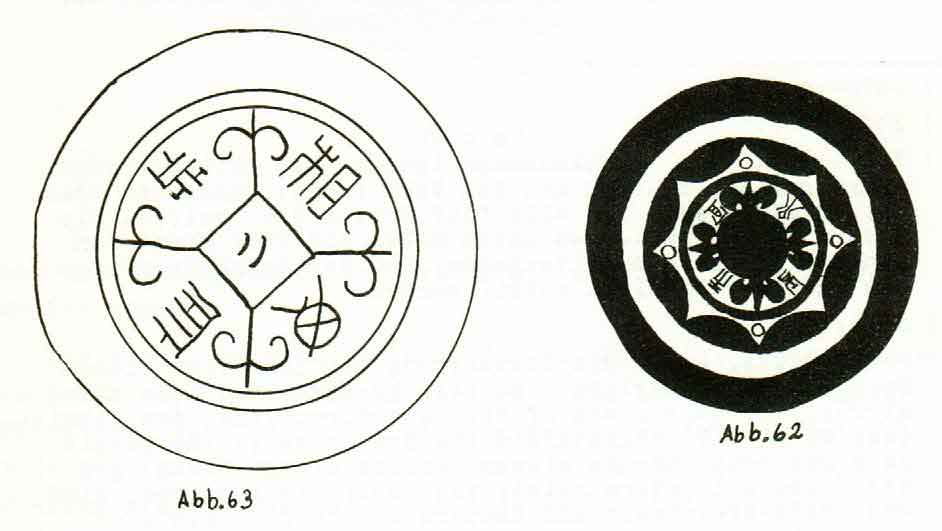 |
|
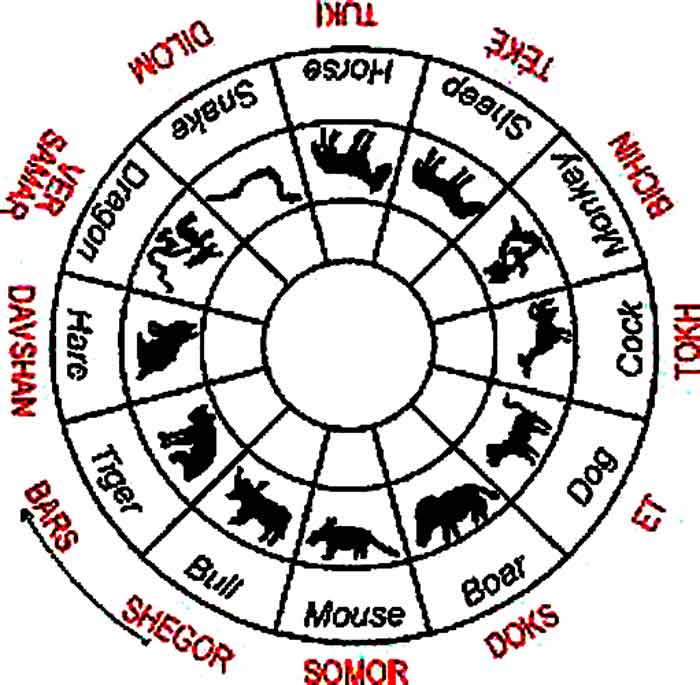 |
|
|
|
|
The existence of these magical mirrors date back at least to the Zhou-Dynasty (ca. 1050 until 256 BC). They appear as belt decorations. They were not only used to get oneself ready but also played an important role for many cults. By using them as a burning glass, the holy fire was lit by sunbeams. One could also collect “water from the moon” by leaving a mirror outside over night with the moon reflecting itself in it: in the morning it would be covered in dew. This water was used for cultic purposes. The fine dust of ground metal mirrors was used as medicine. Most frequently, they were used as protection from evil demons. This worked in such a way that the invisible spirits became visible in the mirror and like all spirits were afraid of seeing their own face. This is why a bride wears a mirror on a chain over her heart and also why a mirror is placed on the chest of the dead to protect them on their journey through the dark region.
On the development of the pattern: It is derived from an archaic motif, that consists of four pairs of feathers that are considered to be birds after the principle of “pars pro toto” and of the sun motif in the center (fig. 64). The same sun symbol, surrounded by four crescent moons that already appears on bronzes from the time of the Shang dynasty (ca. 1450 until 1050 BC) is similar to the ram’s horn (fig. 65). These motifs were never used on mirrors.
In fact, the central motif of the mirrors developed from a pattern that consisted of four leaves and a central circle that was used in the form of a flat relief on the mirrors since the 5th century BC but not after the 3rd century BC. It is reminiscent in several pieces of the pattern of the round jewelry plaque for women and the buttons that were decorated in the same manner (panel XI, fig. 9, dangling earring, silver, engraved, 10, button, silver, engraved, 14 and 16, jewelry plaque, silver, engraved).
This can also be seen in several examples in (fig. 66).
It was also preserved in other parts of Siberia. For example it creates the pattern in a glazed drinking bowl from Turkestan. The figure that is the most interesting in this context apparently developed from the previously described central figures of mirrors or buttons and so decorated the greater part of all Chinese bronze mirrors during the Han Dynasty together with symbolic animals for the four compass points or other symbols for the classification of time or world view. Finally, with the invasion of western influences, these figures were displaced by tendril ornaments in the late Han Dynasty. The mirrors from this era are known as “grape mirrors” because the most prominent decoration on them was a grapevine.
These magical mirrors have been an important export article for China since early times. In Siberia they are first found among the findings from the 6th century BC. They are also found in graves that do not contain any other Chinese import articles. They appear in the kurgans of apparently not noble, free shepherds that lived close to the Orkhon River in the 6th until 8th centuries AD.
On the other hand, mirrors that imitated the Chinese versions were also made very early on in Siberia. Mirrors with similar ram’s horns can also be found among the objects in finds that can be ascribed with certainty to the Red Huns of Hungary.
The appreciation of the mirror has been sustained equally in China and in Siberia until today. It can be traced from the peoples from China’s periphery all the way to North Siberian clans.
The Tibetan and Mongolian priests often carry a round mirror on their chest. This should not be confused with a representation of a wheel, since both often appear next to each other on a costume like on the masks of the god of riches “Namsrai” and the god of death “Yama” in Mongolia (dance masks for Buddhist ceremonies). Mongolian shamans in Inner South Mongolia also wore a typical emblem on their costumes: a silver mirror. The 12-months animals of the Chinese decorate the Mongolian mirrors.
Mirrors that are common until today outside of China don’t have the ornament on one side and the shiny field on the other as was common with the old Chinese bronze mirrors, instead the smooth and the decorated part are on the same front side. Among the Buryat shamans north of Lamaist Mongolia, the same metal mirrors decorated with the Chinese Animal Cycle are sown above the breast on a coat or worn on a chain around the neck. The shamans of the Yakuts are said to have also worn the same metal mirrors on their chests in old times like the Mongolian magical priests. The same is true for the Tungusic people.
Among the Mongolian and Tungusic peoples as among the Yakuts and Yukagirs, the round mirror is also used as breast jewelery by the women, for example in (panel XI, fig. 5, silver, engraved) by a Yakut woman and in (fig. 67) by a Tungusic woman. In this case one can recognize the ram’s horn pattern.
|
 |
|
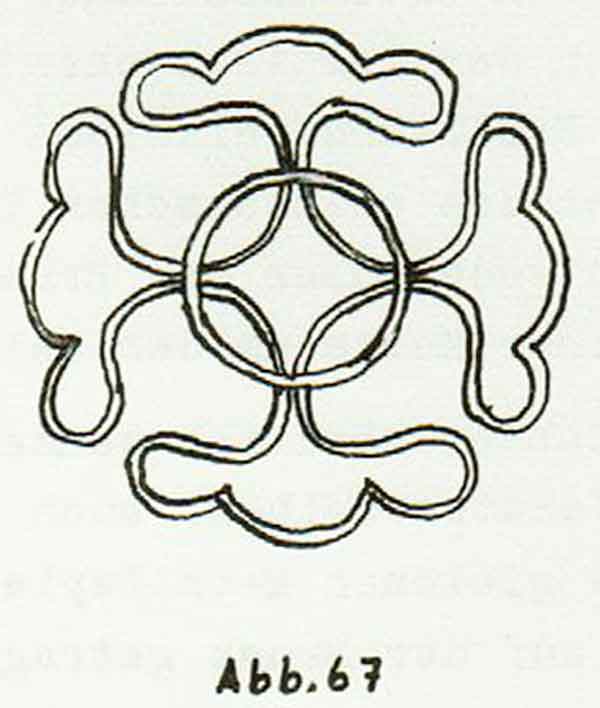 |
|
|
|
|
Patterns on Yakutian jewelry plaques (panel XI, fig. 4, metal fittings on horse bridle, silver, engraved, 6, breast plate, silver, engraved, 11 and 16, jewelry plaque on a woman’s hat, silver, engraved, 24, breast plate on a woman’s hat, silver with enamel) show a further developed kind of ram’s horns and are also present on buttons. They are decorated with a pattern that is surprisingly similar to the mirrors with central motifs from the pre-Han era. As part of the technique, a half-relief with patterns from the Chinese, Mongolian and Tibetan motifs is imitated. Patterns from imported mirrors were quickly absorbed by the South Siberian ornament art. While they do not appear in the Pazyryk that was erected before the Han era in China, they are first found on other objects than mirrors in the kurgan “Shibe” at the Ursul (ca. 1st until 2nd centuries BC) and later probably also in Kudyrge in a kurgan that must have been erected around the year 200 AD.
Among these Hunnic finds (among the Red Huns) in Hungary and partly in today’s Russia, where an ethnic probing was especially successful, the pattern appears on different metal objects. Oddly it later takes on the shape of the double spiral that out of today’s peoples is only characteristic for this motif among the Yakuts and the Chuva.
|
This shows that several of the central motifs of Yakut silver women’s breast jewelry was derived from the central figure of Chinese mirrors that are an important import article.
It is very probable that the ornament was a pattern borrowed from the Chinese (panel XI, fig. 7, box, carved in wood). For the Chinese these ram patterns held more than one meaning |
|
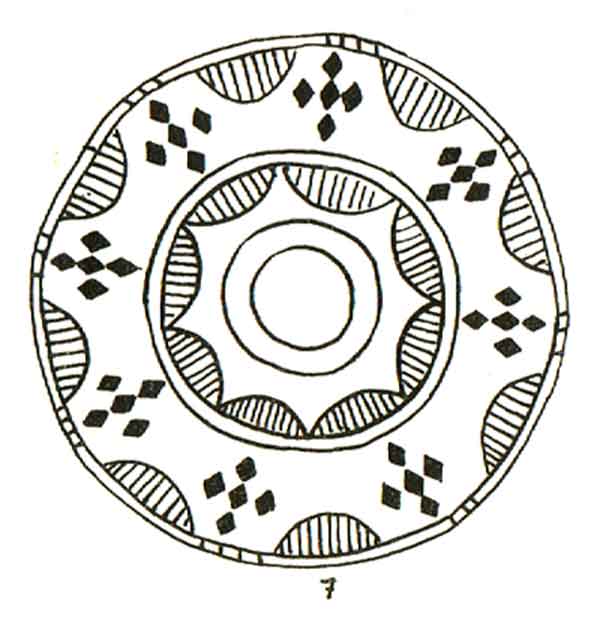
(7) box
|
This is why a similar thought process occurred among the Siberian peoples. Or was this pattern merely adopted for fashion reasons like the plant patterns? The fact that these mirrors were used not only as items for personal use but also as jewelry for shamans and other people makes this unlikely. They were, and are, worn on the chest and on headdresses above the forehead.
A corpse buried in the second kurgan of Pazyryk even carried the mirror in a leather bag above the heart, which means it may have had a cultic meaning in addition to its decorative function. A whole complex of motifs can not only prevail for fashion reasons and supplant ornaments that were previously common among the receiving peoples. But if a single motif spreads over a whole section of the earth and becomes the most often used figure in art among all the peoples that assimilate it, this leads to the assumption that the pattern came with a concept, especially if the ornaments don’t have further similarities. One example is the Christian cross.
The meaning of the pattern in Siberia can only be derived from the name itself. Among the Kyrgyz the idea of the months is connected with it. The time and world subdivision of the Yakuts and other nomadic people is similar to the Chinese presentation. But the 28 lunar stations are missing, the ram’s horn pattern with 28 endings in shapes that appeared on the clay seal from Lo-lang (fig. 58) can’t be found in Siberia either. In this case only the division into twelve, eight or four sections could be seen in the sign. The division into four or eight compass points and twelve months is a commonplace portrayal in Siberia that was already known before the Russians. According to this concept, the “Mother Earth Circle” is eight-sided according to the Yakuts.
The Tungusic peoples painted their shamans’ drums with a circle in the center drawn with a double line, from which eight lines led to the rim of the drum. They represented the eight legs on which the earth stood in the sea.
The world map of the Kalmucks (fig. 68) shows a division into four directions and twelve points.
|

|
|
 |
|
|
|
|
|
The Mongolian world view was of course strongly influenced by Buddhism. They believed the centrail mountain lies at the center of the Earth surrounded by the four earthly realms.
The importance of this arrangement for the spiritual life of the Siberian nomads must not be underestimated. They build houses facing a suitable direction, which leads to the meanings of the Yakutian “hin” – “front part” for east, “arva” – “back part” for west, “xotu” or “xanas” – “left side” für north and “schuru” or “unuo” – “right side” for south. In every direction lie the seats of certain gods. The housing is open to the side on which the good spirits live, either the south or the east, as can be derived from their previously mentioned names. Among the Mongolians it is the south. Here in the northeast, at the point of the sunrise in the summer, the good creator “Ürüng Ajy Tojo” lives that also sometimes has his seat on the zenith. "Ulutujar Ulu Tojon", the terrible lord, lives in the west whereas the gruesome "Arsan Duolai" is in the south or the northwest. Of the lower demons, the god "Aju" (spirits of production and forthbringing) and the equally not evil "Ichi" (possessive spirits) live in the east while the "Abasy", the terrible squeezing or devouring spirits, live in the west.
When the shaman bows in a certain direction, he does so to the spirits that live there, which is why only an obeisance to the east or the south is auspicious. If the shaman bows in all four directions, this is an act of politeness towards all spirits. The same ideas exists among the nomadic peoples of South Siberia, all of which know the ram’s horn pattern. Thus, the Telengits hang the head of a sacrificial animal facing the east if it is for the good spirits and towards the west if it is for the evil spirits.
The Yakuts make prophecies by drawing two concentric circles and marking north, northeast, east, southeast, south, southwest and west on the outer circle. The northwest is not mentioned in this compilation. They then hold a string with a weight above the drawing. After some time the pendulum begins to move. The direction in which it is pulled decides the prophecy. The compass points have the following meanings:
|
North and south are defined by the Yakuts merely as the “main path”. |
|
Northeast, the direction in which the sun rises during the summer solstice, brings horned cattle. |
|
The east is a path of good fortune. |
|
The southeast is the direction in which the sun rises during the winter solstice, which means that one will receive a horse. |
|
The southwest is called the “path into the woods” and means death.
|
|
The due west direction is the path of evil spirits. |
The calendar also decides on which day and in which direction travels should be embarked upon. If it is the wrong direction one embarks in the direction that is favorable for the beginning of a journey and then walks in a circle to go into the direction that one had planned.
Because of these observations from other researchers one can see that the Yakuts accorded the same meaning to the cardinal directions. Also, the classification of the west as the evil and the east as the good direction matches the notion of the Chinese. Then again, this does not mean much since all peoples of Central and East Asia share the same conviction that probably corresponds to the estimation of the sun among peoples living in polar regions and temperate zones that happily greet the arrival of the sun and are sad to see it go.
It can therefore be determined that the distinction between four main and in total eight points of compass was known and that these even played an important part in the culture of the Yakuts and all the peoples among whom the ram’s horns were an often used ornamental motif. It is therefore very probable that the meaning of the ornament, as it was passed on from the Chinese, was passed on along with the ornament and the object. The unusually frequent use of the pattern is explained by the fact that it contained a meaning important to the lives of the Yakuts and related peoples.
Only these facts can explain several variations of such patterns.
In (fig. 1) the ram’s horns are joined in the center by four lyra moifs, that point into the four cardinal directions instead of the sun symbol as in (fig. 1a). This symbol requires the ability to discern between the heavenly bodies and map out the cosmos, this can hardly be called coincidence. If in the same manner an inner circle with four ram’s horns is surrounded by a circle with six, this can only be considered to be half the number of months in a year (fig. 2), as they are also depicted on Buryat ram’s horn patterns (fig. 69). It is of course rather difficult to portray twelve ram’s horns in the manner that is characteristic for the Yakuts. Even the Chinese mirrors of the Han Dynasty already displayed an outer ring of twelve or six symbolic animals and an inner circle of eight or four.
On the other hand, the center of a ram’s horn pattern often contains a cross whose meaning is considered to be a representation of a celestial body (fig. 4). Here the spot is filled with a swirling sun sign. The constellation in the middle corresponds to a depiction of the North Star as it is often found in China.
Among the Kyrgyz, the same sign can be observed along with roses or even more clearly drawn stars in the middle of the ram’s horn motifs. The central motif of the Turkmen is also formed by crosses (fig. 56). The Buryats also often draw the sun and the moon in the center of their patterns.
The Huns practiced an astral religion with a sky cult, spring and fall festivals (autumn) with horseshows, horse races and horse sacrifices. They knew of the kumys.
They divided the year into a twelve-part and a 28-part cycle. They had a considerable influence on the region of the Altai and Sayan Mountains. They may therefore have played an important role in the spread of the symbol. But it was also brought to the attention of the Chinese culture via other relationships within Central Asian peoples, as other finds show.
The ram’s horns spread south from China. In Indonesia the same motif is a common jewelry among the indigenous people, it even surfaces in Polynesia and Malanesia where it appears in a certain variation on the "kpa-kape" of Santa Cruz that are generally described as sun symbols. There, the Asian ram’s horns are considered to be the footsteps of a kind of nightjar, a man-of-war bird or the horns of a water buffalo. Clans that don’t breed cattle also call the symbol “horns of the water buffalo”. This is why the name is considered to be the meaning of a much older pattern. In China, the buffalo is associated with the moon. Whether this points to an originally lunar meaning of the ram and therefore of the depiction of his horns can not be said for certain. The Indonesian version of the symbol, “snelteken”, points to the fact that it was originally jewelry reserved for the „koppensnellers“, the bounty hunters. Today it is deconsecrated. The buffalo tends to the dead warriors in the Otherworld. Buffalo horns are used as war ornaments among the Naga people of Sulawesi, Flores and Timur. In all of East Europe and parts of North Africa, the ram’s horn motifs appear as in Indonesia. But today it has been deconsecrated. The buffalo watches over the fallen warriors in the netherworld. Among the Naga people of Celebes, Flores and Timur, the buffalo horns also serve as war decorations. The basic shape of the ram’s horn motif appears not only in Indonesia but also in all of Eastern Europe and in parts of North Africa. Connections and proof of the probable origin of the ornament being in Asia can not be found.
The Yakuts do not display the ram’s horn in a different manner than arranged in a cross. In contrast, the Kyrgyz and the Buryats often display the arms of the cross with the spirals separately. A similar motif has been turned into a serial ornament on a jewelry plaque of a braided decoration (fig. 21).
The arrangement is also similar to a Han-era mirror ornament. The single motif is also used as a sign for a special day on the Yakut monthly calendars. We know that the Turkmen ancestors of the Yakuts already used it as a sign in the rock art at their previous home in the Baikal and that it originated in a Turkish runic script.

- Old Turk-Alphabet
|
|
The Rosette
The Yakuts used a typical surface ornament, the rosette, to decorate small objects. Silver buttons are decorated with it especially often. In some cases the rosette was also combined to form a serial ornament.
The number of petals on the rosette varied from four to thirteen but most rosettes were shaped with four or six petals. The shape of these petals also varied: It is pointed (panel XI, fig. 20, box, carved in wood), or round (panel XI, fig. 25, button, silver, engraved) and sometimes almost circular (panel XI, fig. 10, button, silver, engraved). In other cases the pattern resembles a star (panel XI, fig. 19, button, silver, engraved).
The rosettes also differ in the way the center is shaped. In all but a few cases the rosettes with more than four petals have a round center, that in some cases is even accentuated by several circular lines or a dot in the middle. The four-leafed rosette often does not have this part.
The rosette is also a widely used ornament among the cattle-breeding nomads of South Siberia. The Tungusic peoples also sometimes use it, whereas the Paleosiberian clans and the peoples of Amur only know few examples of it. The discovered ornaments that have a strong Chinese influence only contain the four-leafed rosette. It fills the center of the ram’s horns that first became known to the peoples in the north of the Chinese empire as the central pattern of the magical mirror. The four-leafed rosette is itself an earlier form of the central ornament of the mirrors and apparently reached Amur from China. The four-leafed rosette of the Yakut jewelry plaques is also traceable with certainty to the Chinese influences of an early time (figs. 64 and 65).
The Chinese did not use rosettes with more than four petals on their rosettes. It can be assumed that this is why the four-petaled rosette became a frequent motif among the Yakuts. In two cases it is arranged into a serial ornament (panel XI, fig. 17, metal fittings on a bridle, silver, engraved and 22, kumys container, wood, chip carving), in the first pattern one of the four petals is always omitted.
|
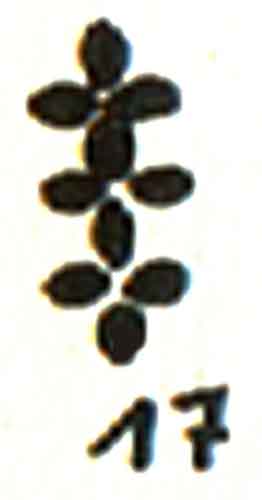 |
|
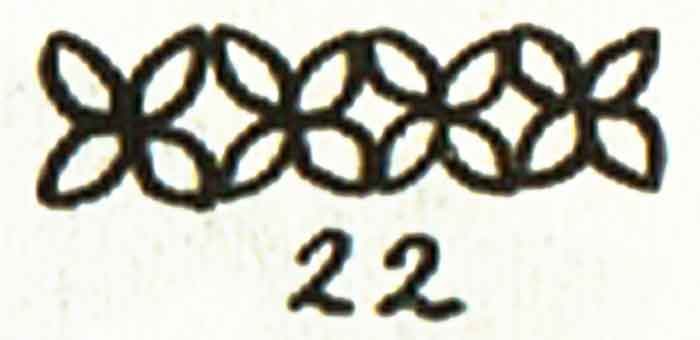 |
|
|
|
|
In the ornaments of other high cultures whose influences on the Yakuts may be assumed (these are the Russians or Persians that emigrated in the New Age), the rosette is often used and it can also be found in finds from the second Pazyryk kurgan. These motifs were used by the Persians as a sun symbol and were therefore a very popular ornament. The Kyrgyz used the rosette equally often. They mostly made it the dominant pattern, that often replaces the sun symbol. Its solar character may therefore be assumed. It was assimilated from the Persians.
The Yakuts also sometimes use the six- or eight-leafed rosette in place of the sun symbol (panel VIII, fig. 34, box, carved in wood, panel IX, fig. 2, box, wood with bone inlay and panel X, fig. 4, box, carved in wood). It is therefore not unprobable that the Yakuts, who had formerly lived further south, also assimilated this motif from the Persians, for whom it played an important role.
Round silver disks that apparently represent the sun and are decorated with the eight-leafed rosette hang as pendants from the sky in the ornament (panel XI, fig. 18 and 23, jewelry plaque, silver, engraved).
Only once does the rosette substitute for the normally used blossom in profile in a tendril pattern (panel IV, fig. 16, box, carved in wood). In this instance it resembles the Chinese portrayals of a plant’s blossom that is considered a sign for luck and good wishes. These similarities may also be a coincidence and should not form the basis for any conclusions.
|
Borrowings from more recent times |
The rosettes on the closet (panel XI, figs. 28 and 29, box, carved in wood), were made with a compass. The middle circle is absent. This kind of rosette is produced by the Russians and other European peoples. The use of a compass is a prerequisite for this. The Yakuts probably borrowed the production technique of this ornament from the Russians.
The Yakut culture was influenced by the immigration of the Russians. The first of them settled in this region in 1633 as hunters and merchants. At the end of the previous century 6500 immigrants were already living here, only half of whom lived from agriculture and animal husbandry. The great immigration occurred in the 1840ies. A large number of them were of course farmers, and many belonged to the persecuted religions that had fled and went on to have a positive influence on the area. This resulted in inter-religious marriages and everyone lived in peace with one another.
Even if the connections between Russians and Yakuts outside were less strong outside of the cities, and the Yakuts outnumbered the Russians by far, the Russian influence, coming from the leading social strata and increasingly also the spiritual upper class, was naturally more noticeable. This was also reflected in the Yakut ornaments. Russian imitations developed.
(Fig. 70) shows an acanthus tendril in the style typical for Russian ornaments. It is modified from the jagged Byzantine style in that the Russians generally reinterpreted it with round shapes (panel XII, figs. 1 and 2, sugar bowl, silver, engraved).
These patterns also contain typically Russian elements (panel XI, fig. 37, sugar bowl, silver, engraved, panel XII, figs. 6 and 7, sugar bowl, silver, engraved, fig. 3, tea pot, silver, engraved).
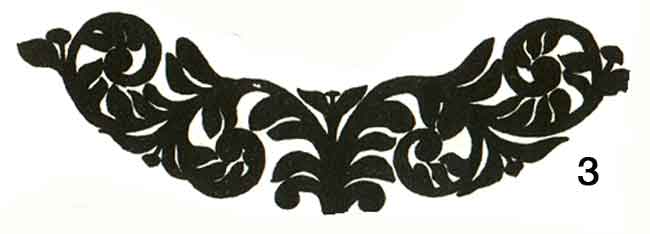
tea pot
These motifs were also borrowed from the Russians’ material culture. The Russians introduced the Yakuts to sugar and subsequently the sugar bowl. Teapots were also of Russian origin, as the motifs on the silver tea cups and saucers show (panel XI, fig. 35, cup, silver).
tea cup 
The motifs on wooden snuffboxes also only appeared after the Russians had introduced this product. They are not of a typically Yakutian style, neither chip carving nor a scoring technique were employed, instead the boxes are decorated with a slightly elevated relief whose edges are not angular but in a right angly to the surface and pattern. The base sets itself apart from the pattern by a cross hatch, which is more common in silver works (panel XI, figs. 36 and 38, snuffbox, birch bark, flat relief, panel XII, fig. 10, snuffbox, birch bark, flat relief and panel XIII, fig. 1, snuffbox, birch bark). Other boxes show patterns created with this technique that was not typical for the Yakuts: a brass wire was laid into wood (panel XII, figd. 4 and 5, snuffbox, birch nodules). This inlay technique is exclusively used on snuffboxes. The tops of boxes decorated in this manner are adorned with patterns that have neither parallels in either the Yakut nor the Russian world. They were discovered in a collection and one must assume that they originate from an artist’s creative imagination (panel XII, figs. 12 and 14, birch bark).
The ornament on one side of a silver saddle (panel XII, fig. 11, saddle, silver, engraved) also corresponds to borrowings from the Russian culture.
A silver fitting (panel IV, fig. 19, saddle, silver, engraved) also contains Russian shapes, as this one buckle here (panel III, fig. 37, belt buckle, silver relief).
The same is true of these simple heart motifs: (panel XII, figs. 20 through 22, on sugar bowls, wood with bone inlay) or here on a snuffbox as a row ornament: (panel XI, fig. 31, engraved wood). This motif appears no where else, if one disregards the saddlecloths, which have obviously developed from the lyra motif (panel XIII, fig. 3, saddlecloth, textile, embroidered).
It is probable that imitations of Russian heart motifs were adopted very late. The patterns of all the other sugar bowls and snuffboxes also proved not to be original. The decorating technique used on these objects does not match the Yakut methods. The brass inlay works are also used for patterns in other cases that also point to a Russian influence. But neither are whittled row ornaments as on the snuffbox made in a Yakut style with chip carving or scoring technique, instead the edges of the patterned surface are at a right angle to the pattern and the base (fig. 31, see above leftt: heart ornament). The same carving technique can also be found on a salt shaker (panel XI, fig. 33 and 34, salt shaker, wood, carved, or panel XII, 19, cigarette holder, silver, engraved).
It is more difficult to find the influence of the contact with the Russians on original objects and their decorations. Take the row ornament on this kumys container, for example: (panel XI, fig. 32, kumys container, wood). Names do not always give definite information. This also applies in the case of this zigzag pattern on another kumys container (panel XII, fig. 16, kumys container, wood). It shows a tendril that consist of acanthus leaves without a stem.
Motifs with an enamel technique are also atypical for Yakut ornaments (panel XII, fig. 9, small jewelry plaque for women’s headwear, silver). Narrow leaves create the tendrils (panel XII, fig. 8, small jewelry plaque for women’s headwear, silver, enamel).
These patterns show no parallels to Russian ornaments. The patterns are similar and are on the rims of two silver decorative plaques for women’s headwear.
Similarities to these patterns are most likely found in the modern Chinese ornaments. The disks themselves can be traced back to the Chinese mirrors.
The fact that the Chinese mastered the enamel technique is commonly known. Therefore it can be assumed that these patterns were adopted from the Chinese rather than the Russians. This kind of a flower in the enamel technique (panel XII, Fig. 17, pearl in zinc or tin with enamel) confirms this assumption. It adorns a pearl that was made from a shell casing. It can be compared to this Chinese flower. (Fig. 71). The asymmetric composition of the whole ornaments does not match the Russian patterns.
Other pearls made from shell casings (panel XII, fig. 18, pearl in zinc or tin with enamel) have only one engraved pattern. They are symmetrical but still differ greatly from the Yakut patterns.
|
The women’s headdress (panel XIII, fig. 6, woman’s headdress, cloth, embroidered), is cut from a piece of fabric embroidered with silver string. The rectangular shape on the front and the one on the back were attached with a backstitch and not sown in as on other headdresses. Like the jewelry plaques, they cover the already embroidered fabric with no attention to the original pattern. The ornament consists of rosettes and branches with leaves, but the structure shows no connection to the Yakut tradition, and the technique is also Russian.
|
|
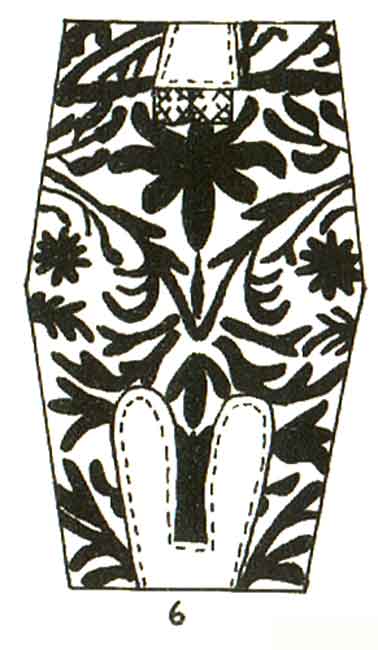
woman's headdress
|
The saddlecloth embroidered in silk and brocade (panel XIII, fig. 3, saddlecloth, textile, embroidered) shows combinations of motifs from the Russians and the Yakuts.
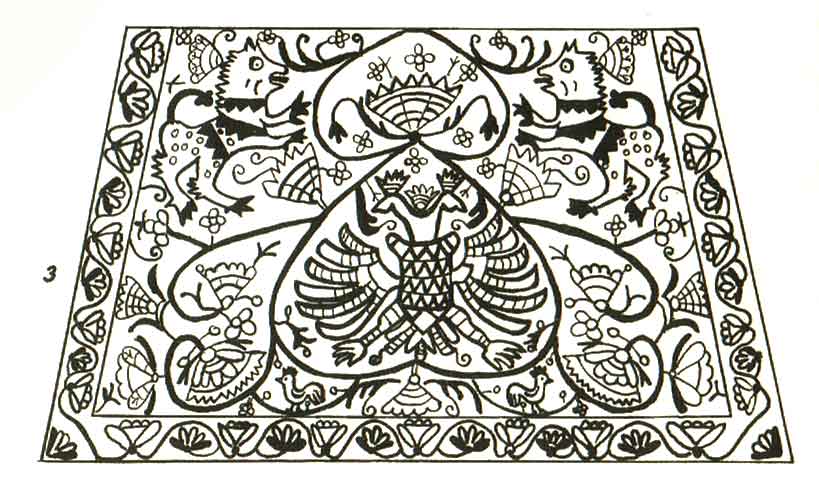
saddlecloth
The lions, the double eagle and the roosters are obviously derived from Russian motifs: The Russians often portray the rooster alongside lions. The latter can be found on all Yakutian silver saddles along with a mythological unicorn with the shape of a horse which is also a typically Russian motif. The Russian crowned double eagle was introduced to the Yakuts as a Russian national emblem. It is found not only on the coins from the czar era but also on the liquor bottles, on stores that sold the state monopoly of liquor, pharmacies and many other places.
Of the plant motifs on the saddlecloth one completely corresponds to the Yakut motifs, while the other that consists of five petals instead of a calyx with a horizontally striped gusset filling and leaf crown, looks like a daisy in profile. But these motifs also seem to be a modification of the normally typical flower motif. In the center of the shape that frames the double eagle, the slightly modified lyra motif that is normally used on embroidered saddlecloths can be recognized.
The most difficult question remains, in which degree the more free design of the leaf shapes only arose after the contact with Russian art.
|
The leaves are only found in the three-leafed form and in the kind in (fig. 38) among the prehistoric finds in Siberia. But the lyra motif was not used on the tendrils and outlines. It is entirely possible, that the smithery works from the time before the arrival of the Russians contained similarly few leaves as the woodwork from today and that only the familiarity with the Russian patterns inspired the smiths to portray the leaves in greater clarity. Similarities to this use of leaves can not be found in Russian folk art, but the inspiration to carry the composition may have come from the Russians.
|
|

motif from the Altai
|
|
Summary
This goes to show that the Yakut ornaments make use of two discernible groups of motifs: geometric ornaments and spiral and plant ornaments.
Wood kumys containers and pieces of pottery are usually decorated with geometric ornaments. Plant motifs are only rarely found on them, while tendrils in conjunction with geometric patterns and ram's horns are often found carved into wood containers and boxes. The reason for this limitation of motifs is partly to be found in technical difficulties. The blossoms and flowers are much harder to depict on wood than jagged lines. A single spiral next to straight lines is easier to produce than the exclusively rounded forms and fine archings of plant patterns. This has led to the Yakut tradition of decorating boxes, cases and trunks – important items for all nomads – with geometric and plain spiral shapes. The tobacco tins, Russian fief, do not conform to this tradition.
Smiths decorated their work with plant ornaments. The execution of these complex patterns was only achievable with such perfection because they practiced it their whole lives. They used more simple spiral patterns for less valuable objects.
It was also easier to represent round shapes in embroidery, for which the moss stitch was mainly used that is otherwise unknown in Siberia. It is for this reason, that these items make use of spiral motifs. Plant motifs are rarely used in embroidery either and none of them are of the evenness and finesse of smithery work.
Other than this relation to the material, the selection of an ornament can also be necessitated by tradition, since certain items must be decorated with certain ornaments, and sometimes even a certain technique is prescribed.
The oldest motifs are apparently the geometric motifs. Many of them can already be seen on finds of the earliest era of Siberian history, 3000 until 2000 BC. All the symbols that represent the heavens – crossed squares, wheel crosses and swirl shapes – belong to this group.
The plant motifs and tendril shapes used in the art of the south Siberian nomad peoples and subsequently the Yakuts can be traced back to the time from the 5th until the 3rd centuries BC. Here, they first appear on findings from the kurgans of Pazyryk in the Altai, where they followed the animal style as the leading style of art. This new art style reached southern Sibera via the coast of the Caspian Sea from the Middle East.
While this development began with the first kurgan, by the second kurgan, the plant motifs had all but completely replaced the animal shapes. If one compares these plant patterns with the motifs the Yakuts had used in the previous century, a close relationship can be recognized. Also, there is no plant pattern that does not have parallels to the ornaments of the Yakuts. Special attention must be paid to the reconfiguration of the head of Argali, that is used numerous times in the first kurgan of Pazyryk. It is obviously a religious symbol, because even today the sheep and the cow are symbolic of the female imagined earth goddess. This would be an explanation for why the cattle breeding nomads in Asia decorated women’s headdresses with horns. In the second kurgan the motif appears as a double spiral ornament in a lyra-like shape and remains a popular form of decoration. The most common of the Yakut spiral ornaments has the same lyra shape.
Only the Yakuts knew these ornaments in their characteristic shape at the end of the previous century. The lyra shape and the wave tendril also appear sporadically in the art of the Kara-Kyrgyz (Mountain Kazakhs) and the Kyrgyz. But they are not typical elements of these peoples’ ornaments.
In the Altai, this motif can only be traced back to the time around Christ’s birth. Even in the kurgan of Kuryge approx. 200 AD, a change in the Altai culture can be seen, that can be attributed to the fact that a new and even stronger Mongolian population settled here while the number of the previous inhabitants decimated considerably.
In later times, specifically the 6th century AD, tendril ornaments of a similar kind can be found in northern Mongolia, while the lyra motif was used in the ornaments of the Rouran (Ruan Ruan – Juan Juan – Quryqan), a people situated at the southern end of lake Baikal from the 6th until the 9th centuries AD
|
- see more information about the Xiongnu – 3rd century BC to 4th century AC – Hsiung-nu - Xiongnu
The Rouran are considered to be the predecessors of the Yakuts that migrated north and merged with the Paleosiberians and Tungusic peoples located there. They are said to have lived there before the 6th century. Judging by archaeological finds, they can only have settled here after the beginning of the Iron Age, so in the first years of the common era. Their migration lead them south along the Angara river. There is no proof for this assumption. It is only known that the material culture of the Rouran is similar to that of the peoples around Krasnoyarsk and those in the Altai and Sayan Mountains. Yet the path of the Angara river does not lead to the northeast and therefore Krasnoyarsk, but instead more or less due north. If instead one follows the path to the Altai region, one needs merely go along the rivers Ulug-Khem (Yenisei) or Bii-Khem or Kao-Khem (Great and Lower river – upper Yenisei), that pass through the Tannu-Ola region (today’s Tuva). It follows that if one wants to regard the Rouran from a western perspective, it is equally probable that they did not originate in the northeast but instead directly in the west. Comparisons with the ornaments of prehistorical finds show that the Yakuts are the only ones to still use surprisingly similar or even identical ornaments as the peoples of the Altai in the 5th until 3rd centuries BC.
- map sketch: - Jennisei und Angara
|
The material culture of the Yakuts is also similar to that of the peoples of the Pazyryk, if one considers that sheep are not lucrative in the wetter northern regions and therefore can not be bred, while cattle can only flourish in regions with enough pastures. Only in recent times, after the invasion by the Russians, was it kept in equally large numbers as horses. All this data points to the fact that the Yakuts lived in the area of the Pazyryk culture, i.e. in the Altai Mountains and their vicinity, before they went to the south end of Lake Baikal. They would have had to pass through 900 km of lakebed before reaching this area. The climatic conditions in both regions are similar. This distance is not of relevance for nomads, especially if one considers that the second migration route of the Rouran from the Baikal Lake to Yakutsk was twice as long and led to a different climate zone.
A relationship of the Pazyryk culture with the Yakuts and the Rouran that is noticeable in the use of the same horse harnesses, seems to be closer to the culture of Minusinsk of the same time.
The ornament of ram's horns dates to a later time. It first appears on the magic mirror of the Han dynasty in China, where it symbolized the arrangement of the universe. It was an unusually frequently used ornamental symbol in southern China, in Indonesia, in the north and west of the empire and in Siberia. Shortly after the Nativity it appeared on the mirrors that were an important export article in China and also as an ornament of other items of daily use. The ram's horns were used on Yakut women’s breast jewelry als late as the end of the previous century. The ornament apparently still had the same meaning in Siberia as in China.
The Huns decorated their objects particularly often with this motif, it is probable that they are responsible for its introduction into Eastern Europe. Some of the Huns’ metal cauldrons sport the same ornaments as the Yakut kumys containers that apparently developed from this kind of pattern on pots.
- see more information about the Huns – 4th century to 6th century after Christ – Huns
The last period before the borrowing of ornaments by the Yakuts lasts into our time. They copy some Chinese patterns and also many motifs of Russian folk art. Like the plant motifs of the Pazyryk era, these were not introduced as religious signs, but instead were assumed as part of a higher culture together with the objects on which they are found. This applies to tools, guns, urban wood buildings and even prayers and the modern Russian school system.
It is thereby proven that the ornaments are one of the most pertinacious elements of the Yakut culture, in terms of primitive and semi-cultured peoples in general. It is therefore not surprising that motifs have endured from very early eras, from prehistoric times, in the ornaments of the Yakuts.
Another fact can be proven by way of the example of the Yakut ornaments: Every motif originates in religion. Not all of the Yakuts’ motifs appeared as religious symbols, as can be assumed with the lyra motif, or were introduced as religious symbols like the ram's horns. The plant ornaments were apparently only adopted by the wealthy class of cattle-breeding nomads of the 5th through 3rd centuries BC as meaningless imitations of the wealth of the empires of the Middle East. The borrowings of modern time happened in a similar fashion. But if the motifs are traced back to their emergence in their country of origin, one must discover that they also developed from lotus depictions – religious symbols.
A special characteristic of the Yakuts’ sense of art is the great number of variations that exist of each individual motif. No pattern completely matches another, as it is common with the Mongolian Buryats and the Ostyaks. The Yakuts always try to create something new, despite always using the same traditionally prescribed basic motifs.
|
- Collection of further ornaments see also panels I through XIII |
|
|
|
| - Mongolian traditional (national) costumes und History of Mongolian traditional art and artwork |
|
|
© Albi, November 2011 – English translation, March 2012: Hermelinde Steiner
|
PageTop
 |
|
|





